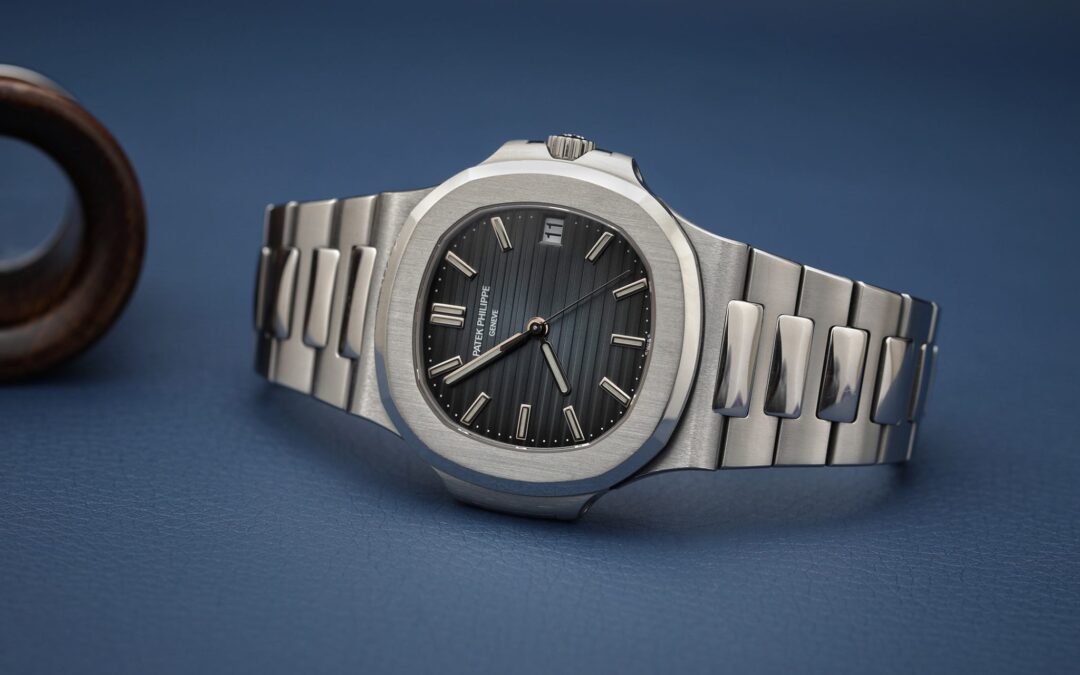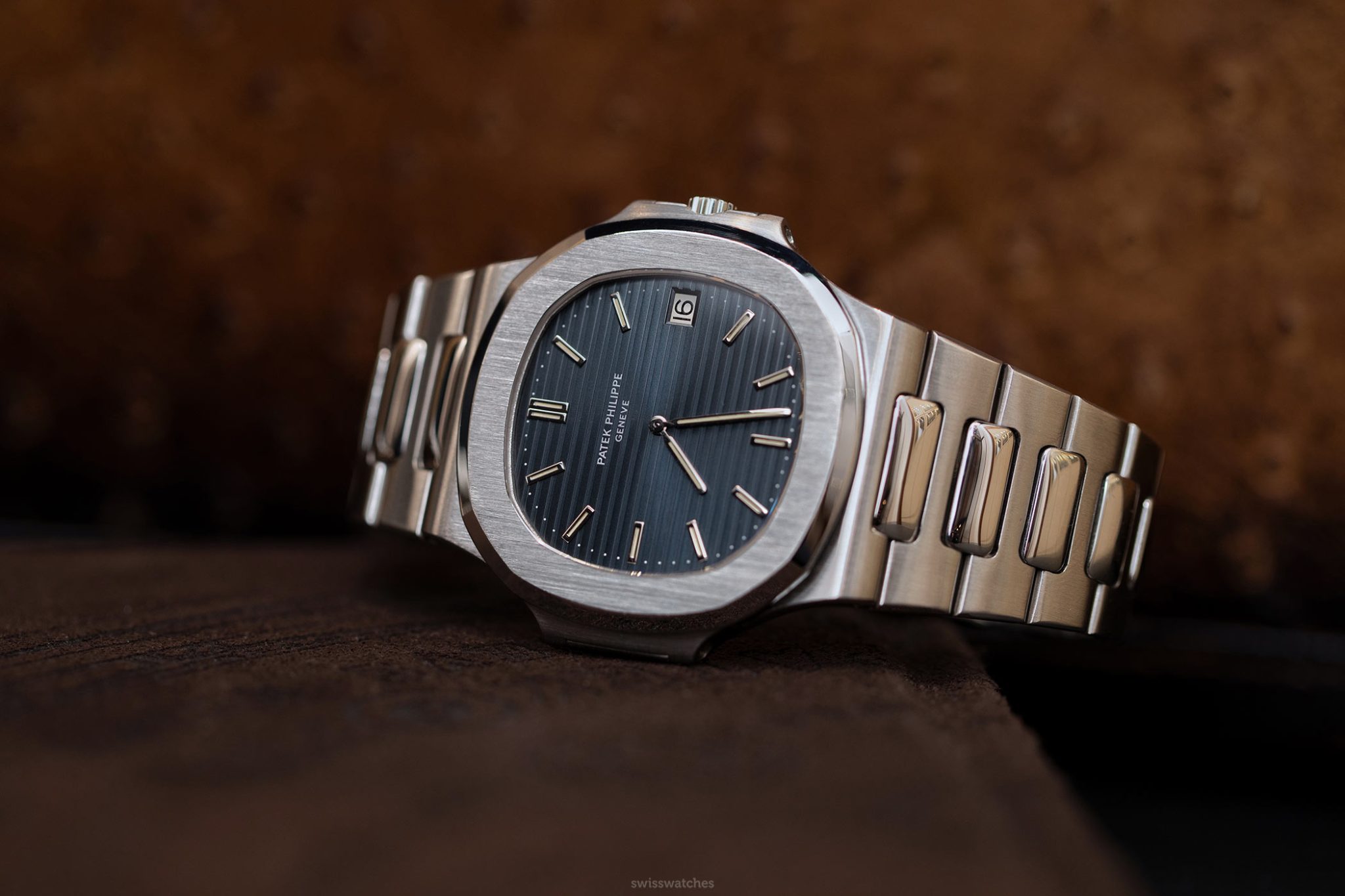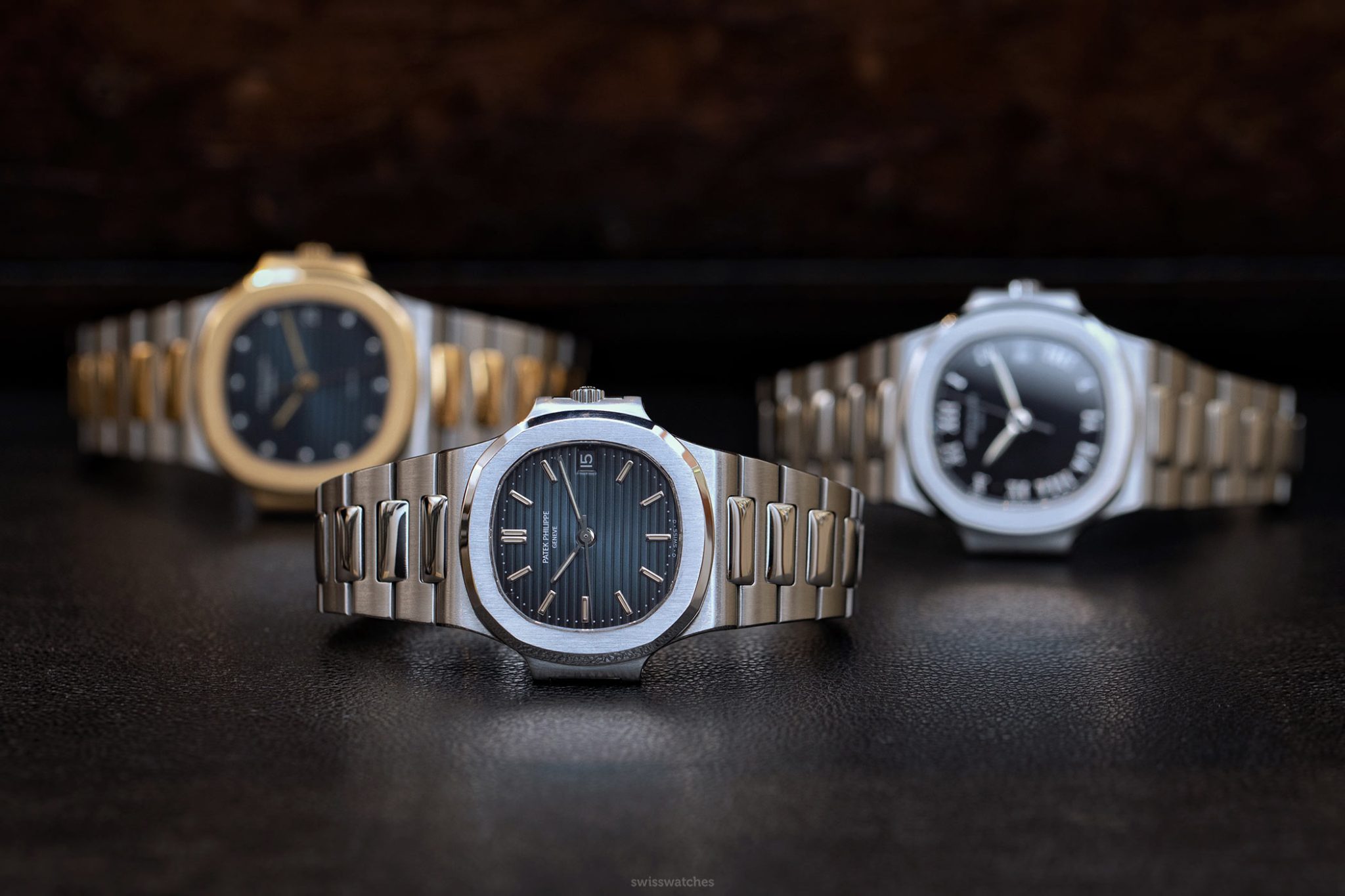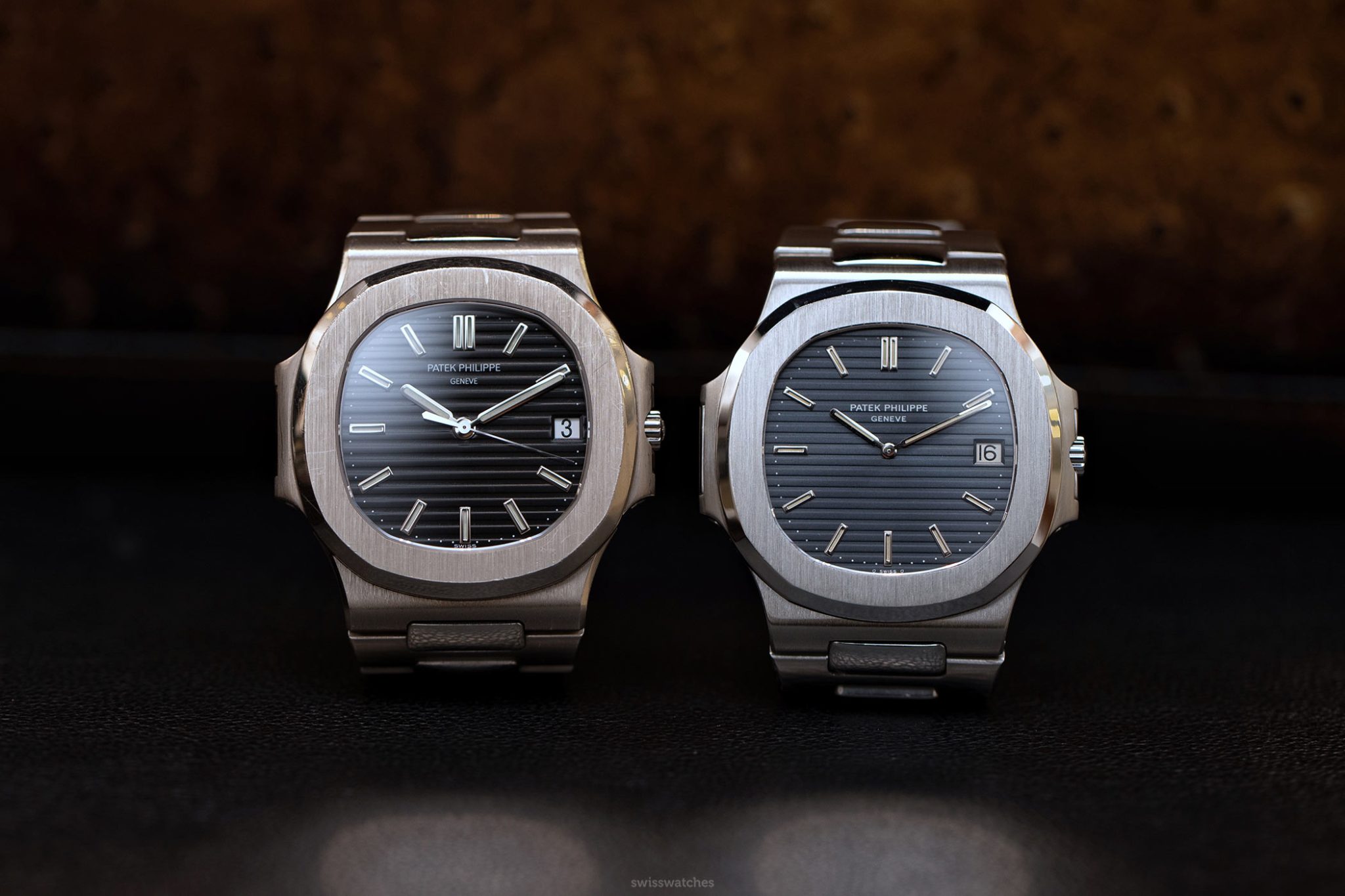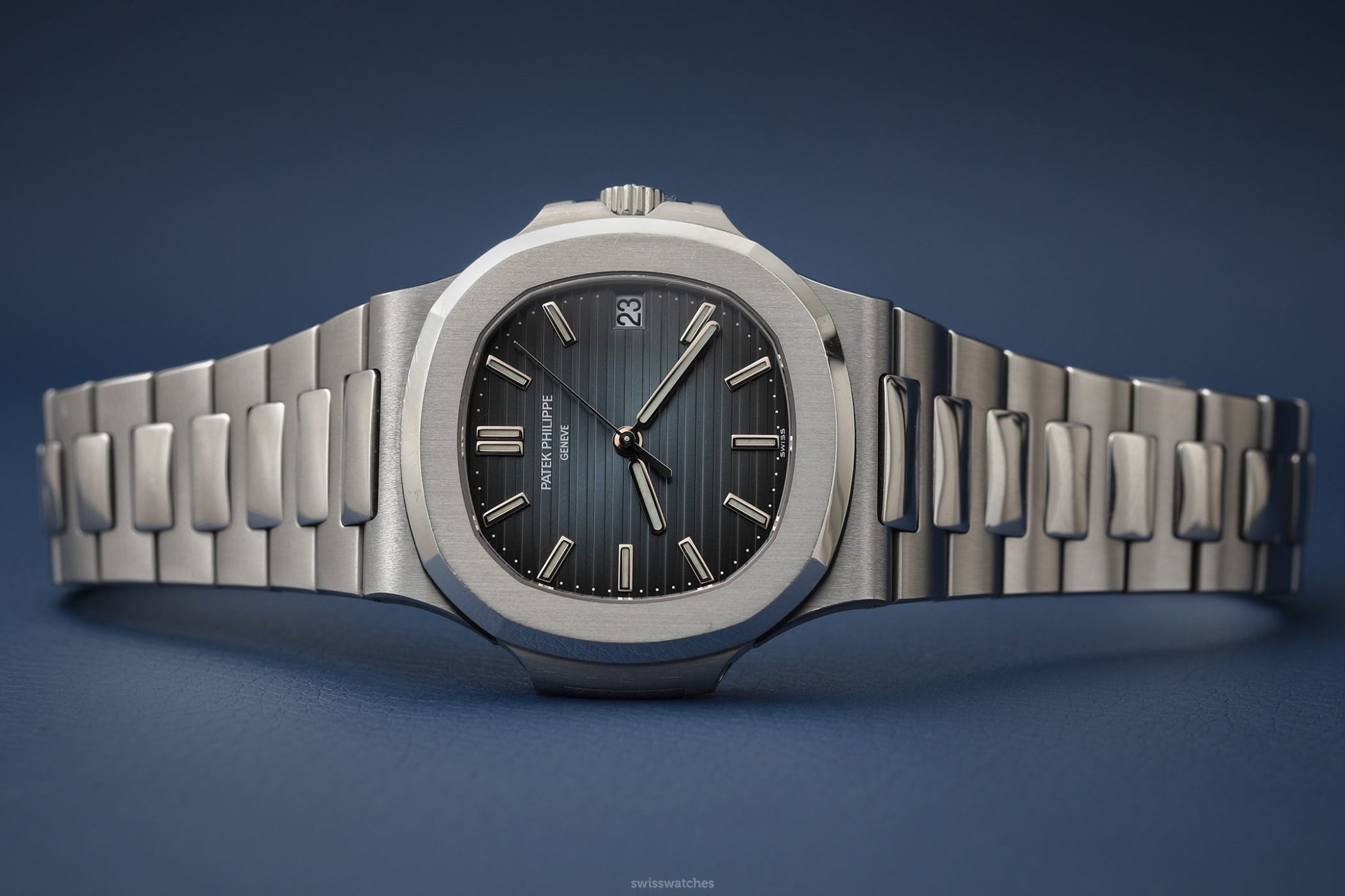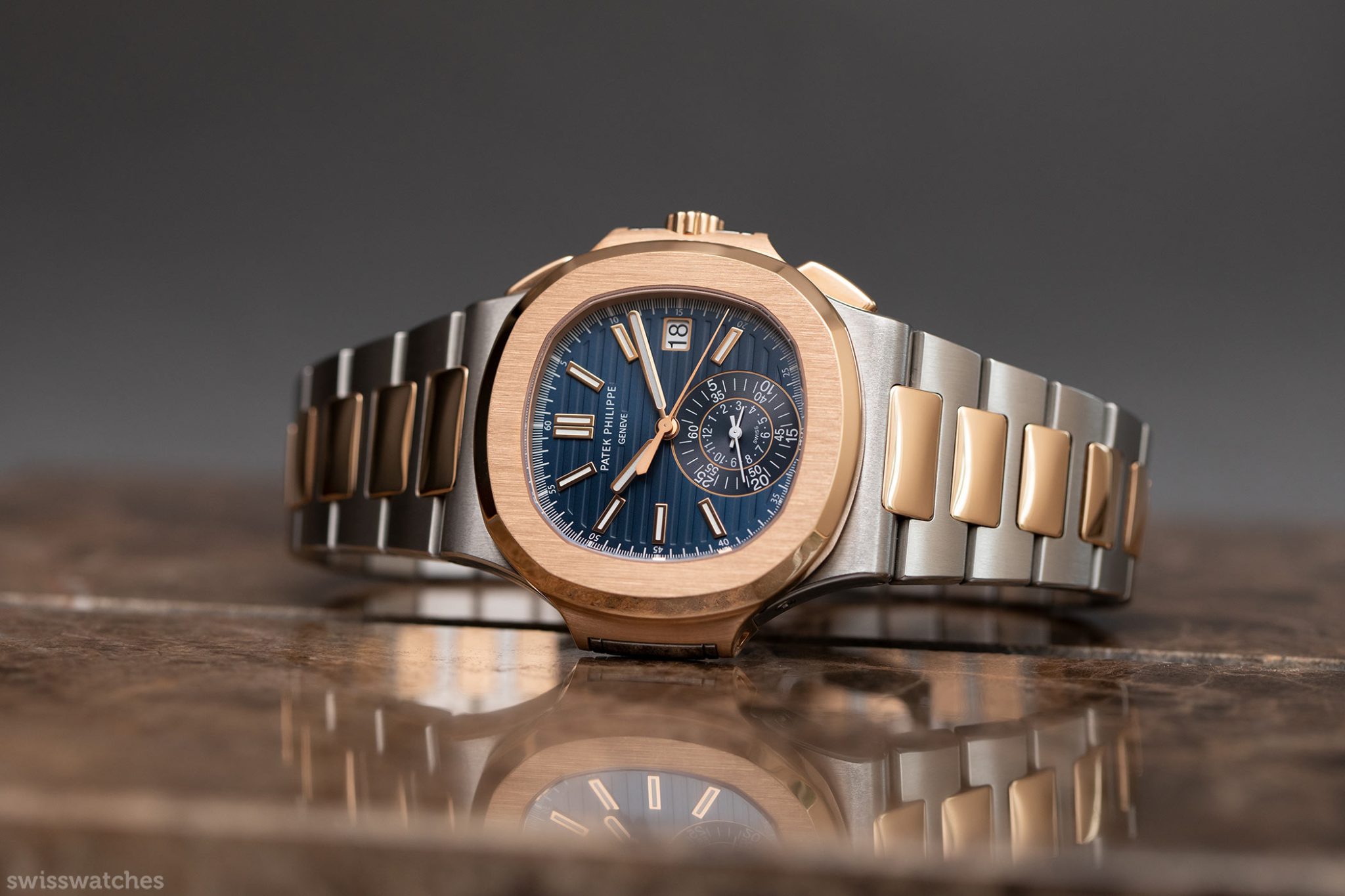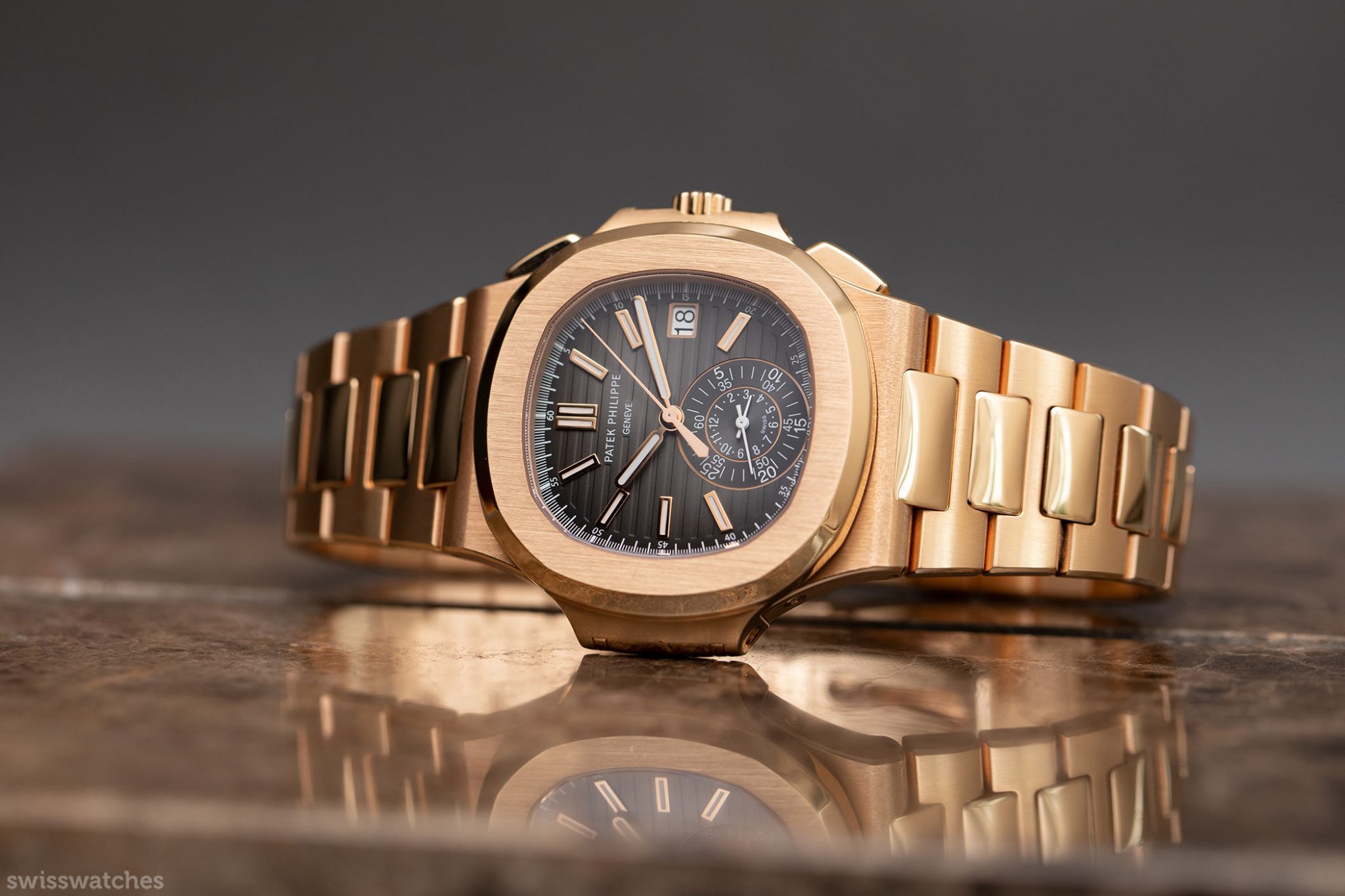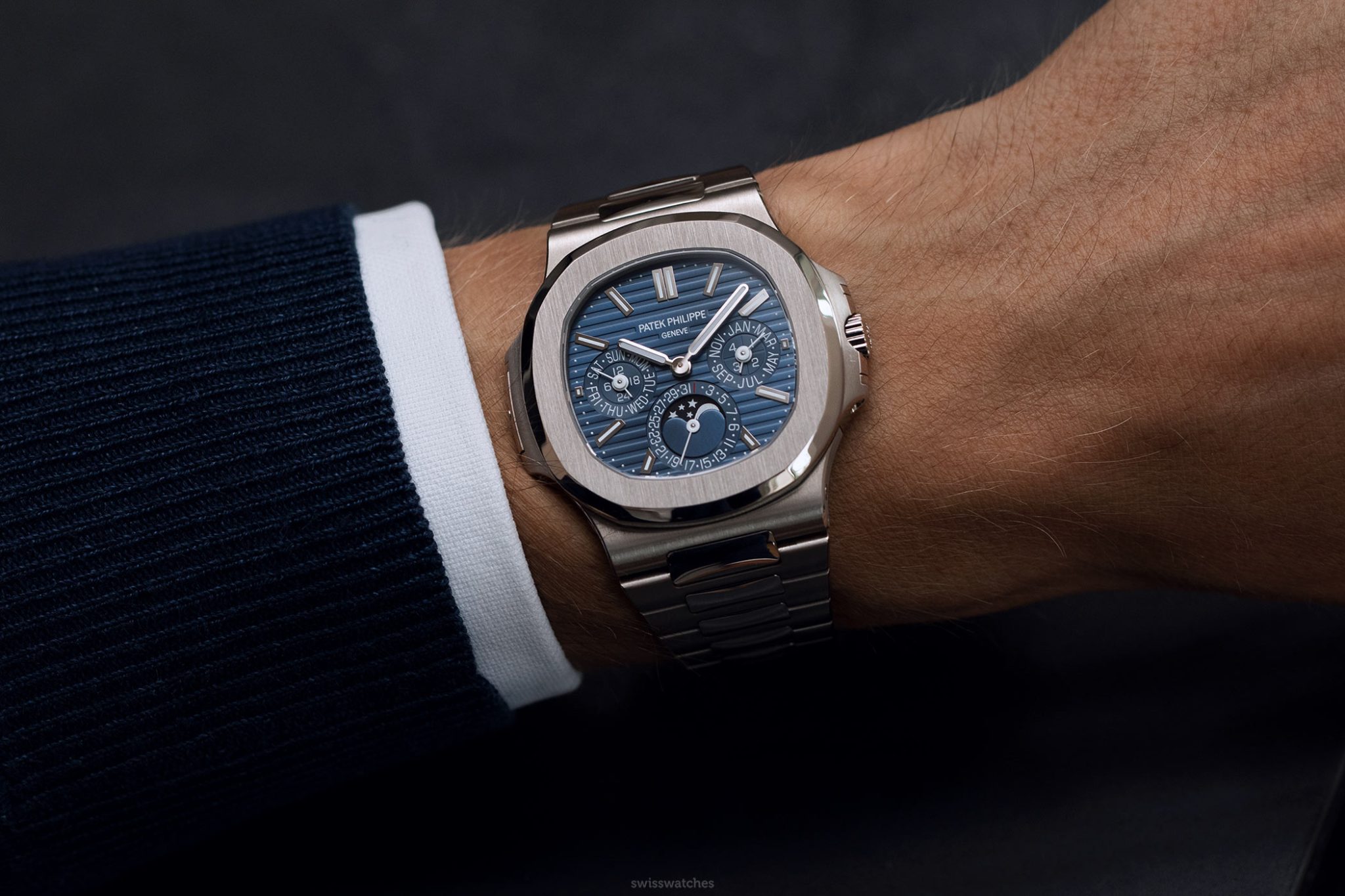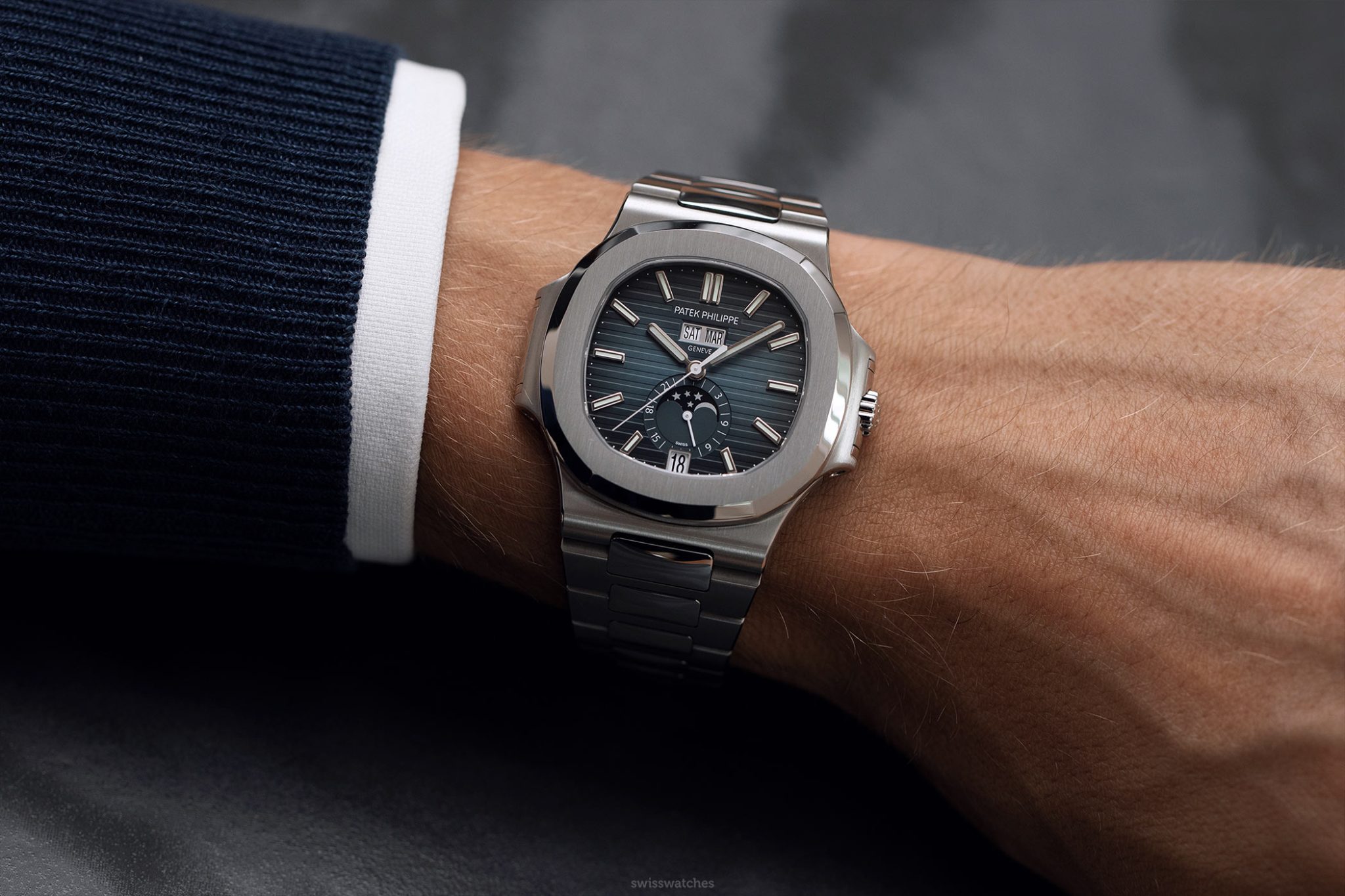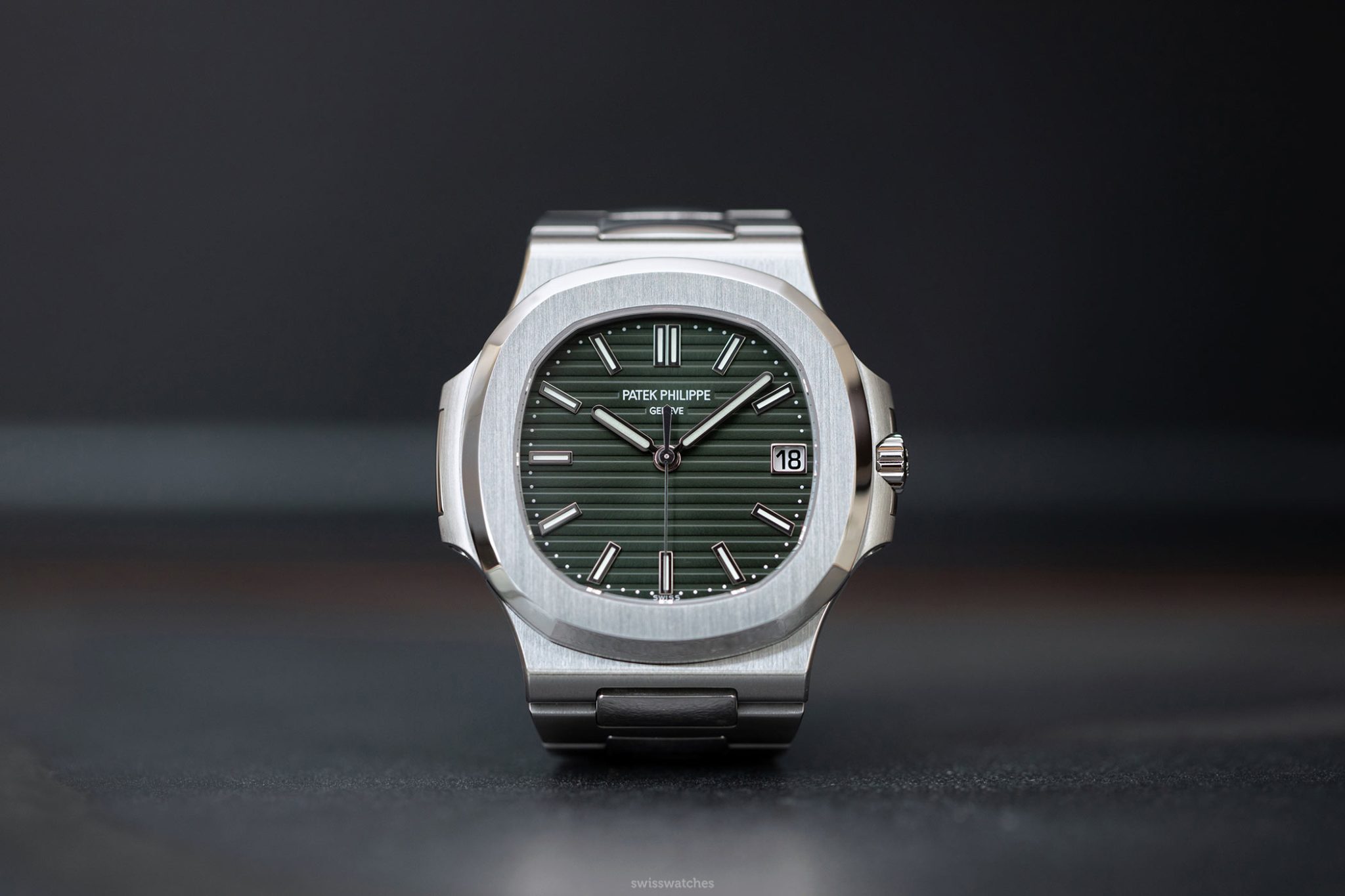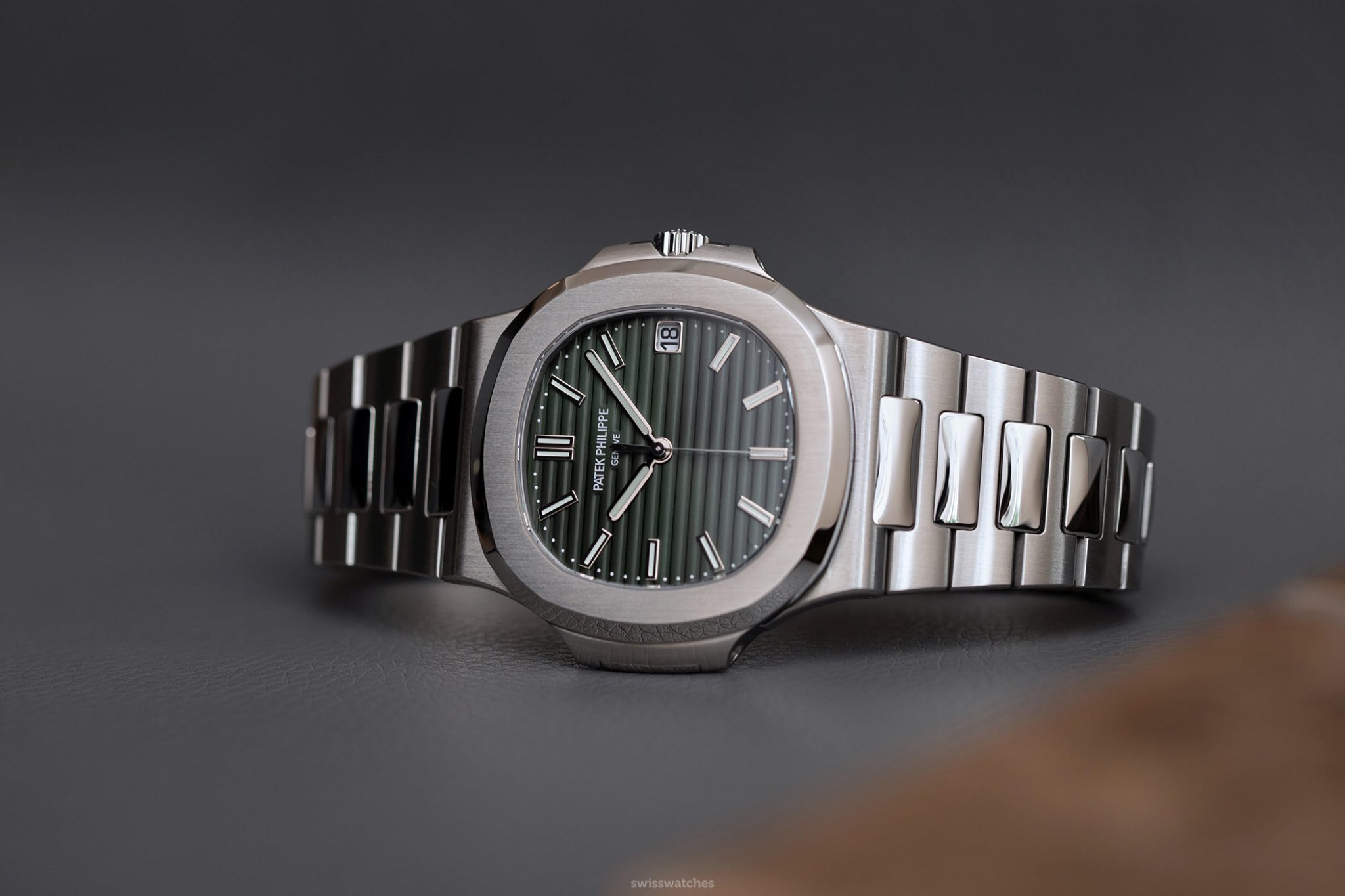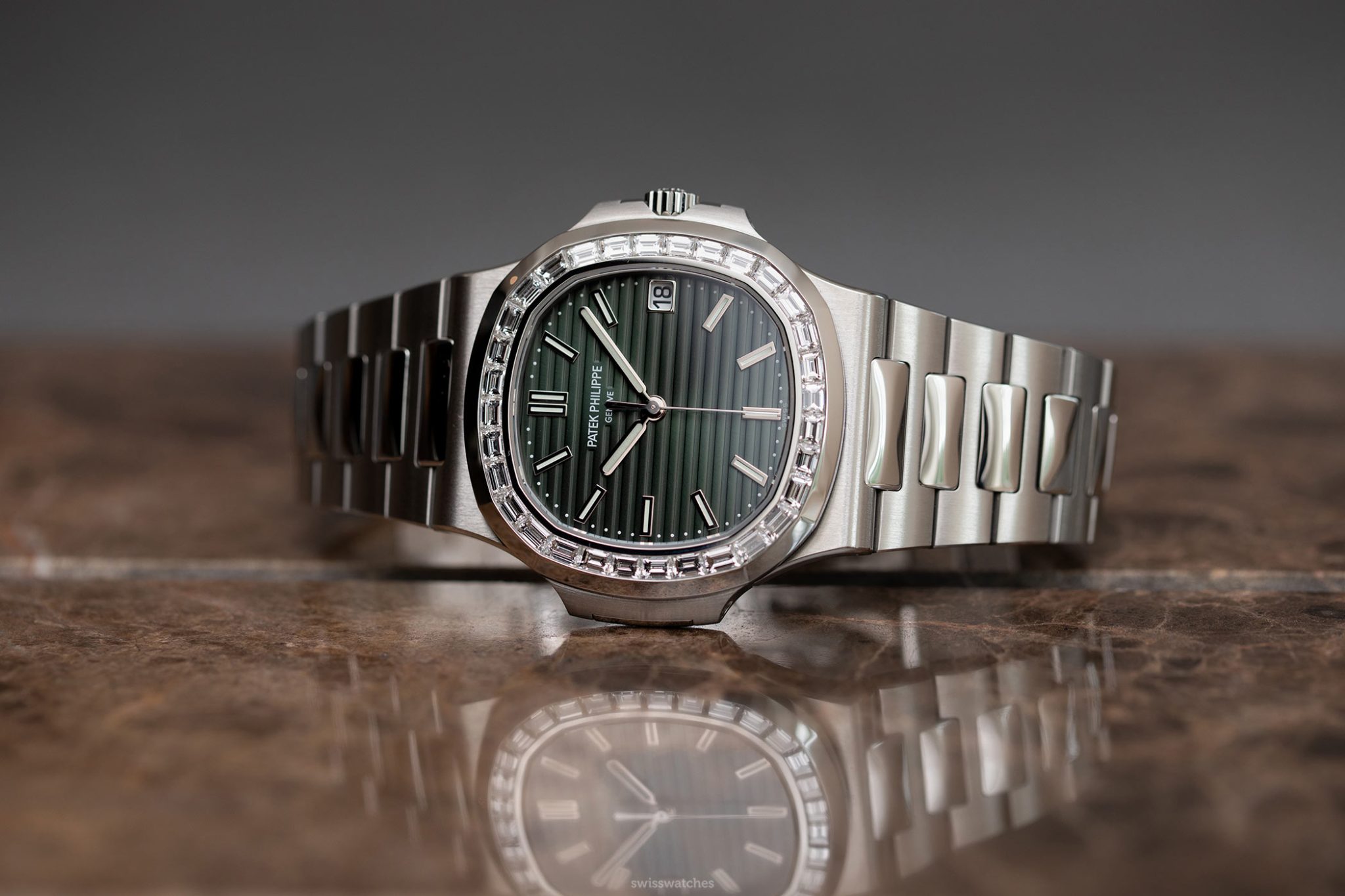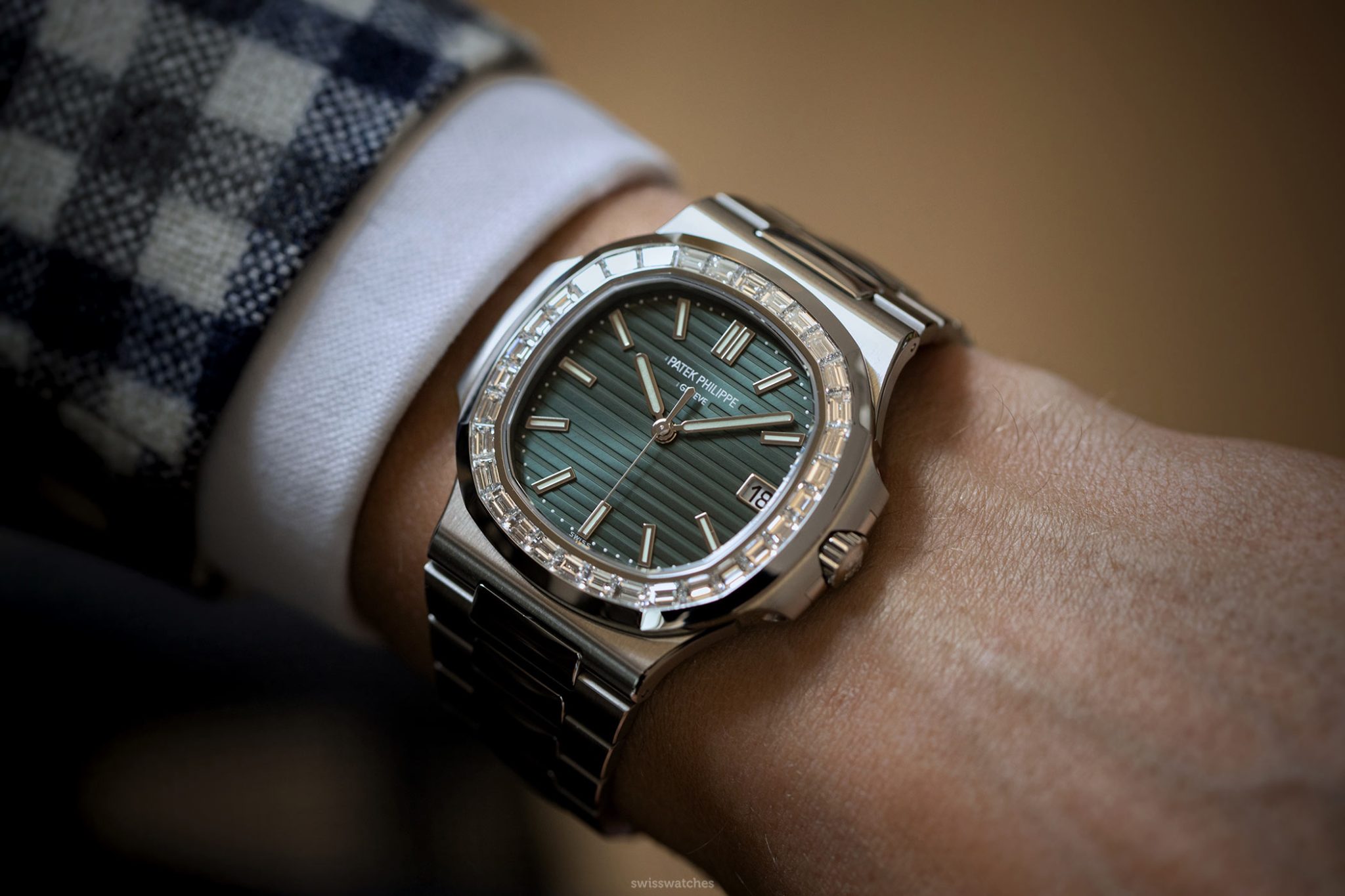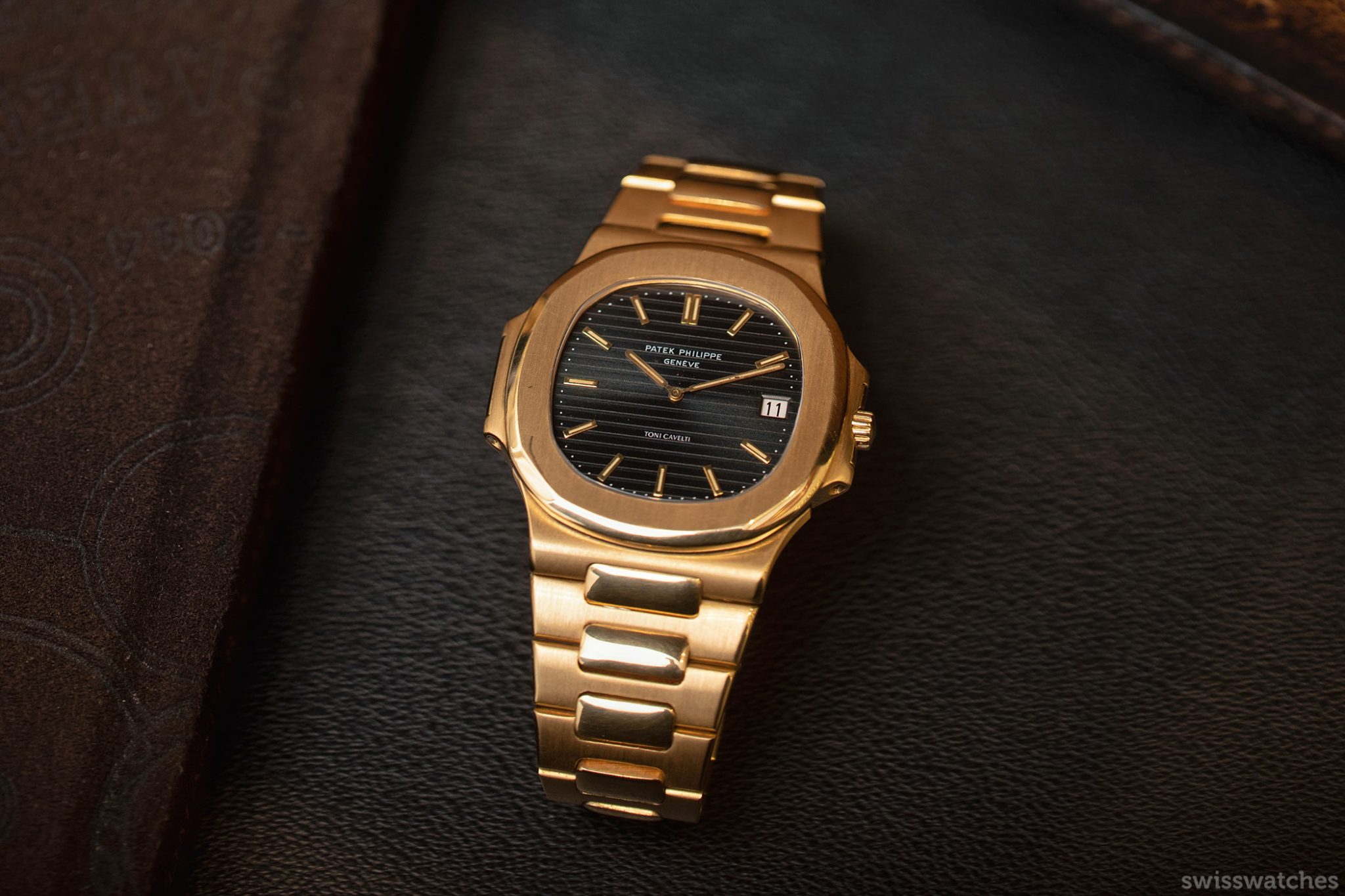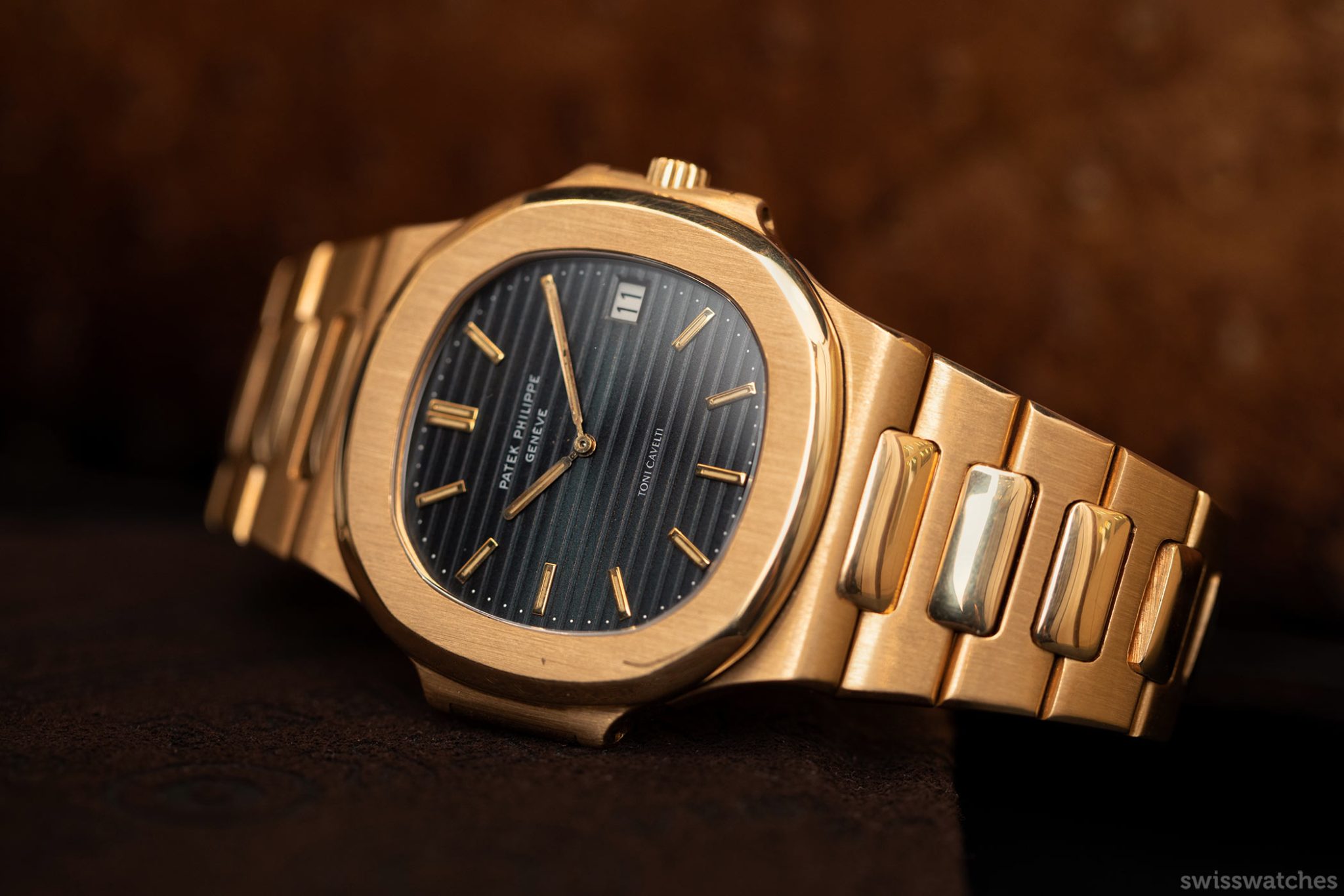So what does Swisswatches Magazine know that you don’t? For starters, the experts at Swisswatches are not just satisfied with a normal guide to the Nautilus; “Write us the ultimate Patek Nautilus guide!” was my assignment. “Ultimate” is an overused word, but in this case (at least at Swisswatches) it means: “Forget everything else. You shouldn’t need to read more than this single text. It should cover absolutely everything regarding the world-famous watch”. Well, let’s find out whether I managed to rise to the challenge.
Why Three Hands And Steel Is Just The Beginning
Ref. 3700-1A from 1976 and Ref. 5711-1A-010 from 2006
I must confess that even the request to write this text brought beads of sweat to my forehead. For days, I tried to ignore the pile of books that piled up next to my desk. Yet I had virtually just gone through my entire watch bookshelf, so as to have all the information at hand. I also own about two metres’ worth of books about Genevan watch manufacture Patek Philippe, supplemented by newspaper clippings, auction catalogues, old interview records, and important sources such as the Patek Philippe magazine.
So, let us enter the madness of what is probably the most consistently valuable steel watch in the world. And should anyone out there find that they are not getting their money’s worth, that some tiny detail is missing, please do write to Swisswatches. I am happy to hear every new insight.
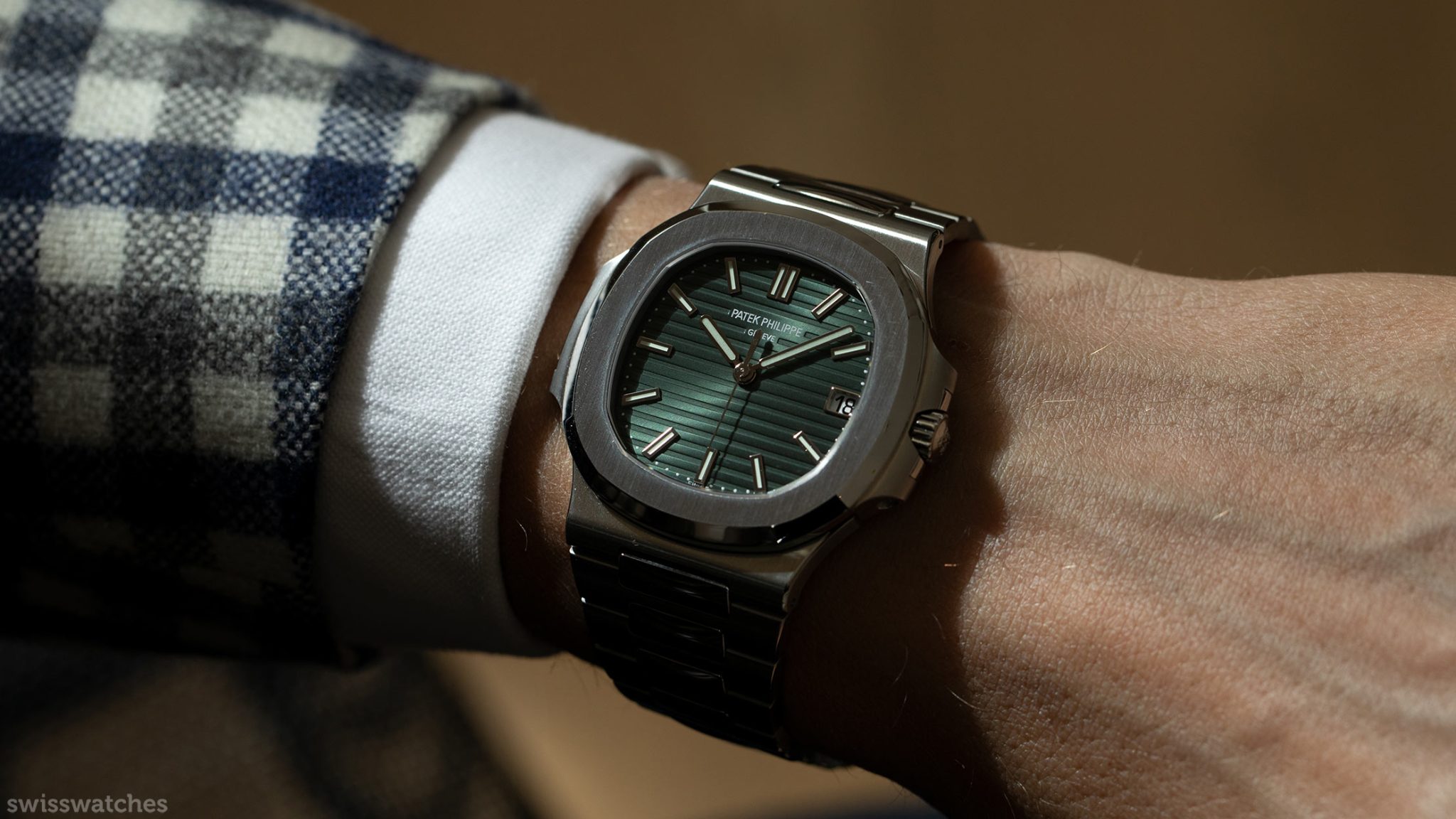
Nautilus 5711/1A-014 in olive-green
Firstly, though, don’t say I didn’t warn you, because “ultimate” also means that this article will be a lot. Your head will be spinning, possibly even turning octagonal like Gérald Genta’s unique case design from the seventies. At some point you may start to dream about the Nautilus at night like I do, at a depth of around 120 meters (the maximum water resistance of the watch), with a diving bell on its head, with a viewing window in the shape of a porthole (the inspiration for the case design) on the bottom of Lake Geneva (the site of Patek Philippe’s headquarters), while musing with Patek CEO Thierry Stern (the son of the watch’s co-inventor) about how the world’s most coveted stainless-steel sports watch might one day find its way back to reality – but in a completely different way than we could ever imagine.
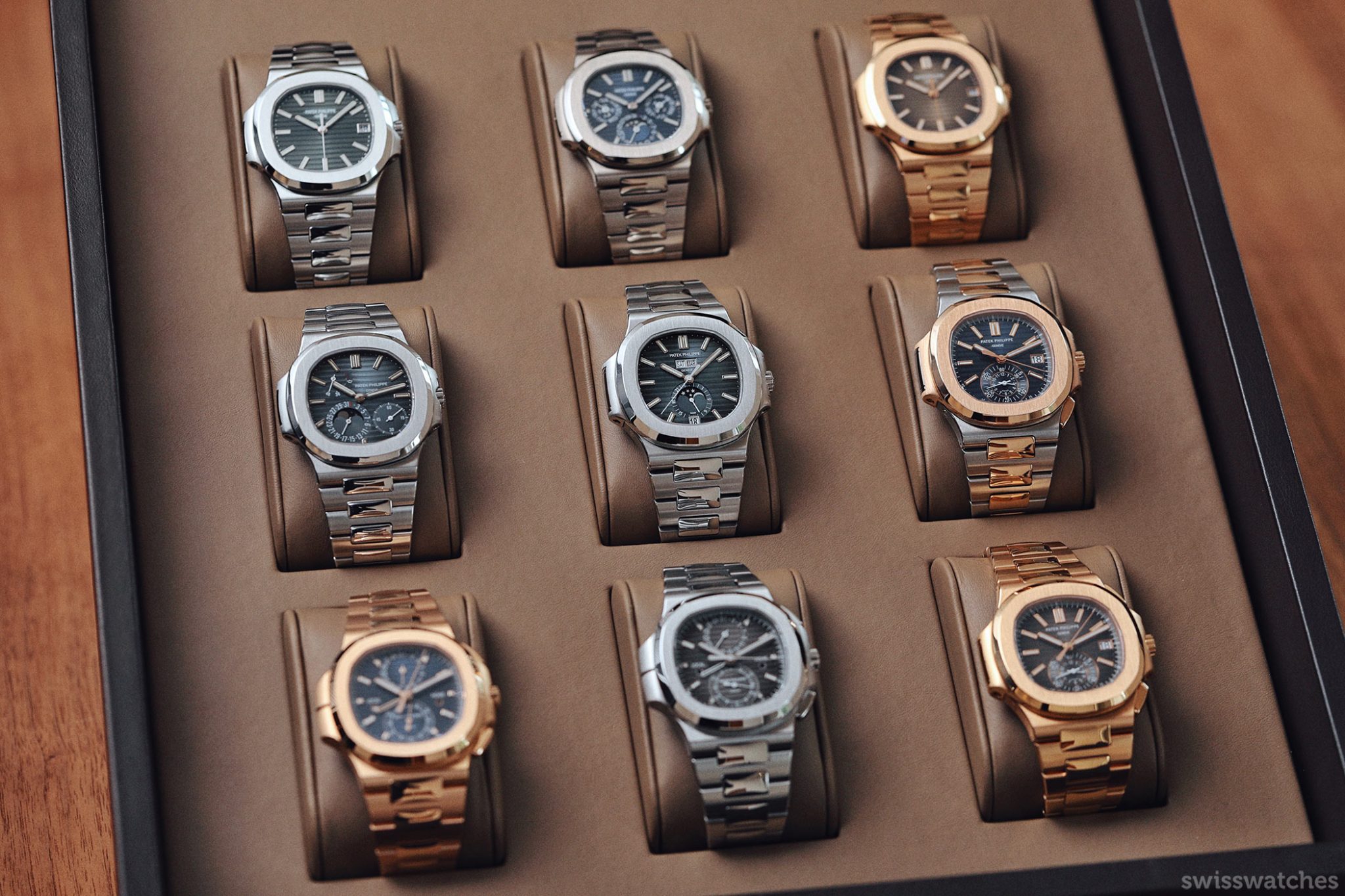
A genius (and a lot of work)
Let’s start with the basics. For all you newcomers: to create an iconic product, you need a person with a brilliant idea, but more importantly, you need the right partner to make it happen. In the case of the Nautilus, this involved a brilliant designer meeting an ambitious heir to a company. Only very few manage to push through an idea against initial resistance without diluting its original character. This is just as true of successful companies as it is of successful products.

Take the Porsche family, for example, who managed to inspire people with the idea of a four-seater sports car and a design that every child knows today (first with the Porsche 356, then later with the legendary 911). To achieve something like this, you firstly have to have a lot of experience (Ferdinand Porsche had been developing cars, especially racing cars, all his life before his son created the 356). Secondly, above all, you have to be able to break with habits (at Porsche, for example, the six-cylinder boxer engine is located behind the rear axle, which is what frees up space for four people in such a slim body). Thirdly, you have to understand why all this effort has any added value for the customer at all.
An obvious example is, of course, Rolex. Hans Wilsdorf (son of a Franconian brewer – I always have to mention this as a native Franconian) had the vision of a robust everyday wristwatch in his head, when everyone in the world was still lugging around clunky pocket watches. For about a quarter of a century, he refined his formula and, in parallel, developed the famous company name and logo until the model known today as the Rolex Oyster Perpetual stood in its modern form. And when he cleverly combined this principle with the emerging modern leisure activities of his customers (car racing, scuba diving, mountain climbing), modern classics were born, such as the famous Rolex Daytona, the Rolex Submariner or the Rolex Explorer. What does all this have to do with the famous Patek Nautilus?
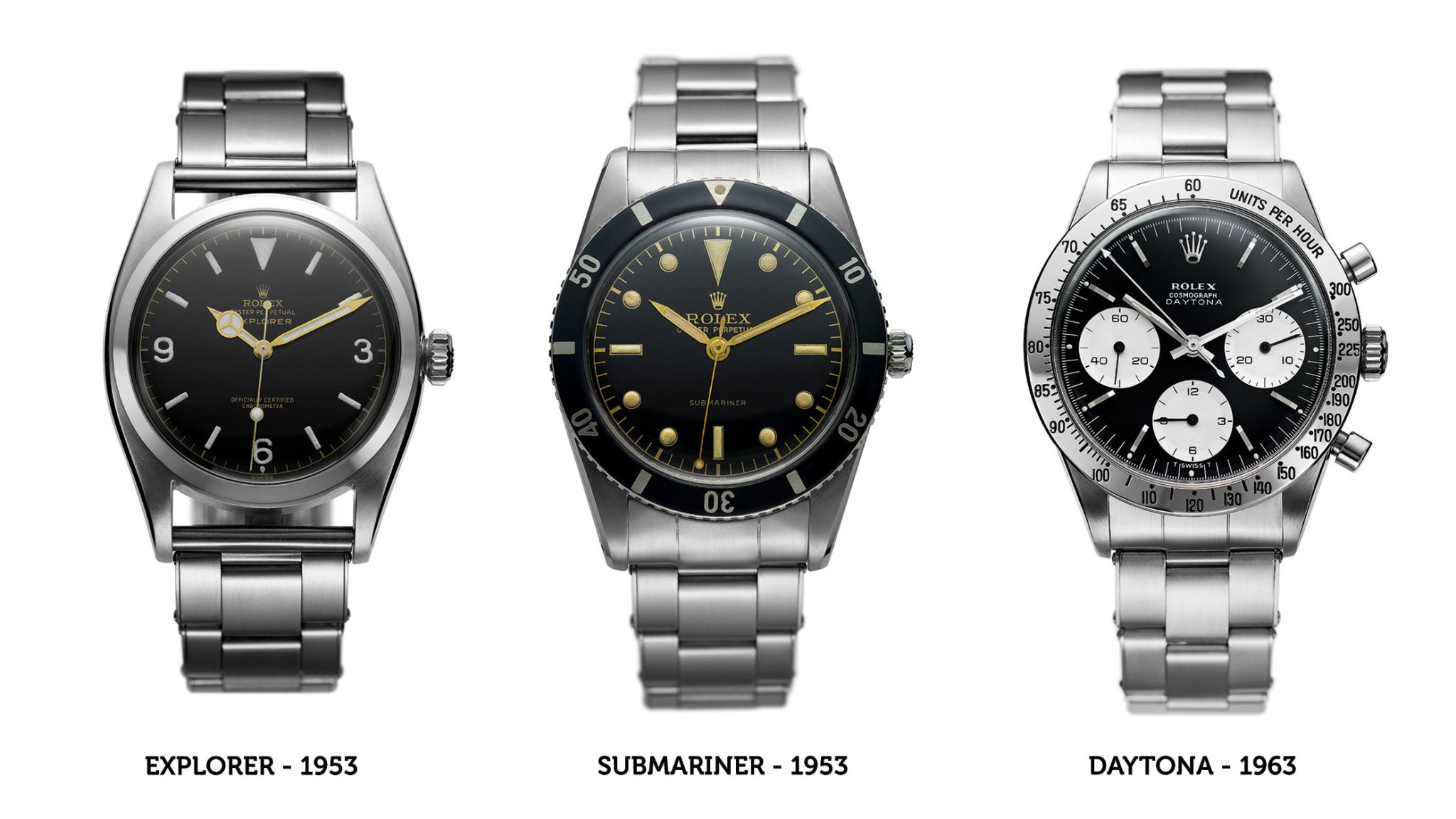
Credit © Rolex/Jean-Daniel Meyer
A timeless design
The answer is: a lot. This is because the crucial question is, how is this design icon so timeless that in 2021, people will spend as much on a design from 1976 as they would on a brand-new Porsche 911? The design of the Nautilus was not created by a nobody, but by someone who already had a reputation in the industry. The designer Gérald Genta, full name Gérald Charles Genta, actually learned the craft of jewellery design, but from the early sixties devoted himself mainly to watches. When he approached the son of Patek Philippe’s president in the early seventies to present what he thought was a groundbreaking new watch design, the latter was skeptical.
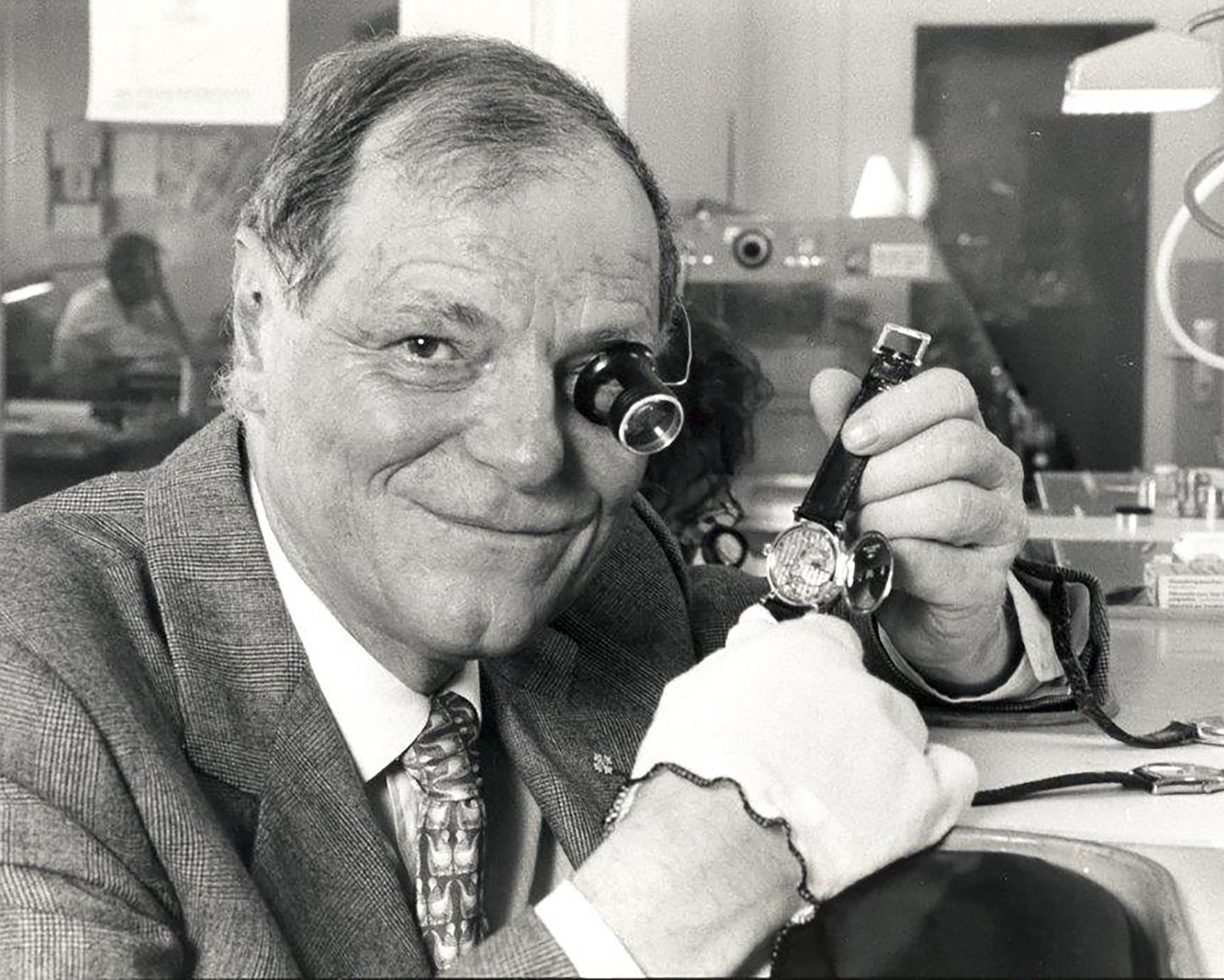
At the time, Philippe Stern was a young manager who had gained his first international experience in the USA. It was a time of great upheaval. The first supersonic flight was accompanied by the first oil crisis. The emerging quartz crisis with cheap watches from the Far East was causing problems for Swiss watch manufacturers. Was Patek Philippe really ready for a watch design as radical as it was modern?
Stern recalled: “Gérald Genta came to us with this idea. He was very convinced of the idea and believed the watch would be a success for the century. It was, and it still is today. At the time, it was a gamble for us. No one expected a costly steel watch from Patek Philippe back then.” He added, “The Nautilus was not just a new watch for Patek, it was a completely new concept. It came out around the same time as the first Range Rover, and for us it was the horological equivalent; a waterproof luxury sports watch to match a sporty luxury car. But combining such a radical design with high water resistance was difficult.”
The genius – and the madness – of manufacturing
The designer Gérald Genta proposed a watch to the aspiring company heir that had never before been seen in the 137-year history of the company. And that should mean something for a company whose maxim since its founding in 1839 has always been to create the best watches in the world. Genta proposed a watch made of stainless steel that was water-resistant to 120 meters, with its shape inspired by the portholes on steamships, and held together by a steel link bracelet with lugs integrated into the case. The whole thing was also supposed to be equipped with a mechanical movement. In addition, the case was enormous for the time, with a diameter of 42 millimetres.
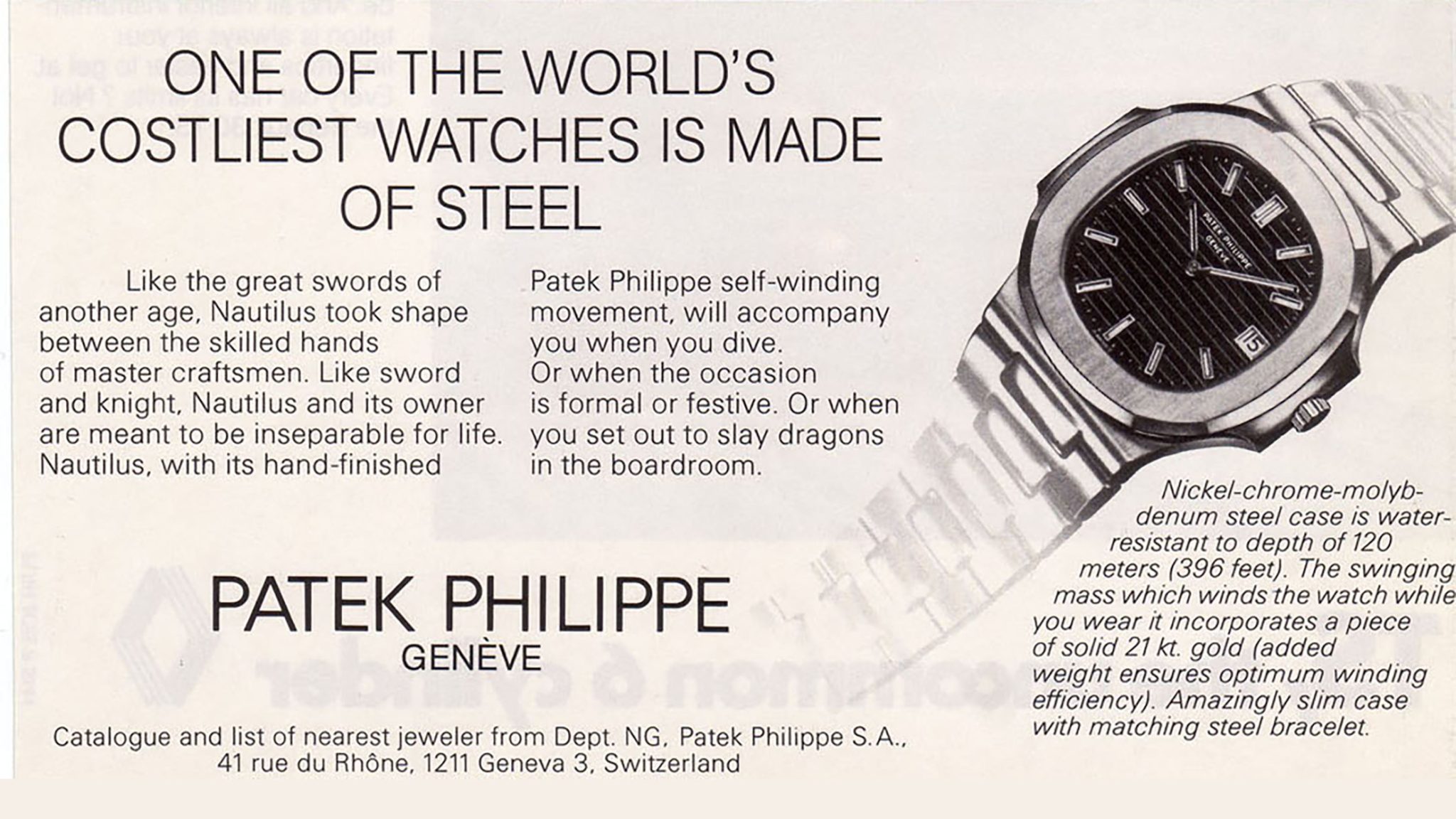
Mr. Stern was doubtful, later admitting: “At first, I wasn’t so sure.” The watch clearly went against his company’s strategy at the time of making small, flat watches. The Nautilus was completely different and very bold. “It was for younger customers who travelled a lot and enjoyed sports,” recalls Stern, himself an avid skier and sailor who won regattas on Lake Geneva. He had travelled extensively in his younger years, and recognised the needs of a new generation. That reads easily, but what it meant for modern fitness consciousness to become a mass phenomenon for the first time in the 1970s is best described by a cover of the New York Times, which, in April 1968, described “jogging” on the front page as an “in sport.”
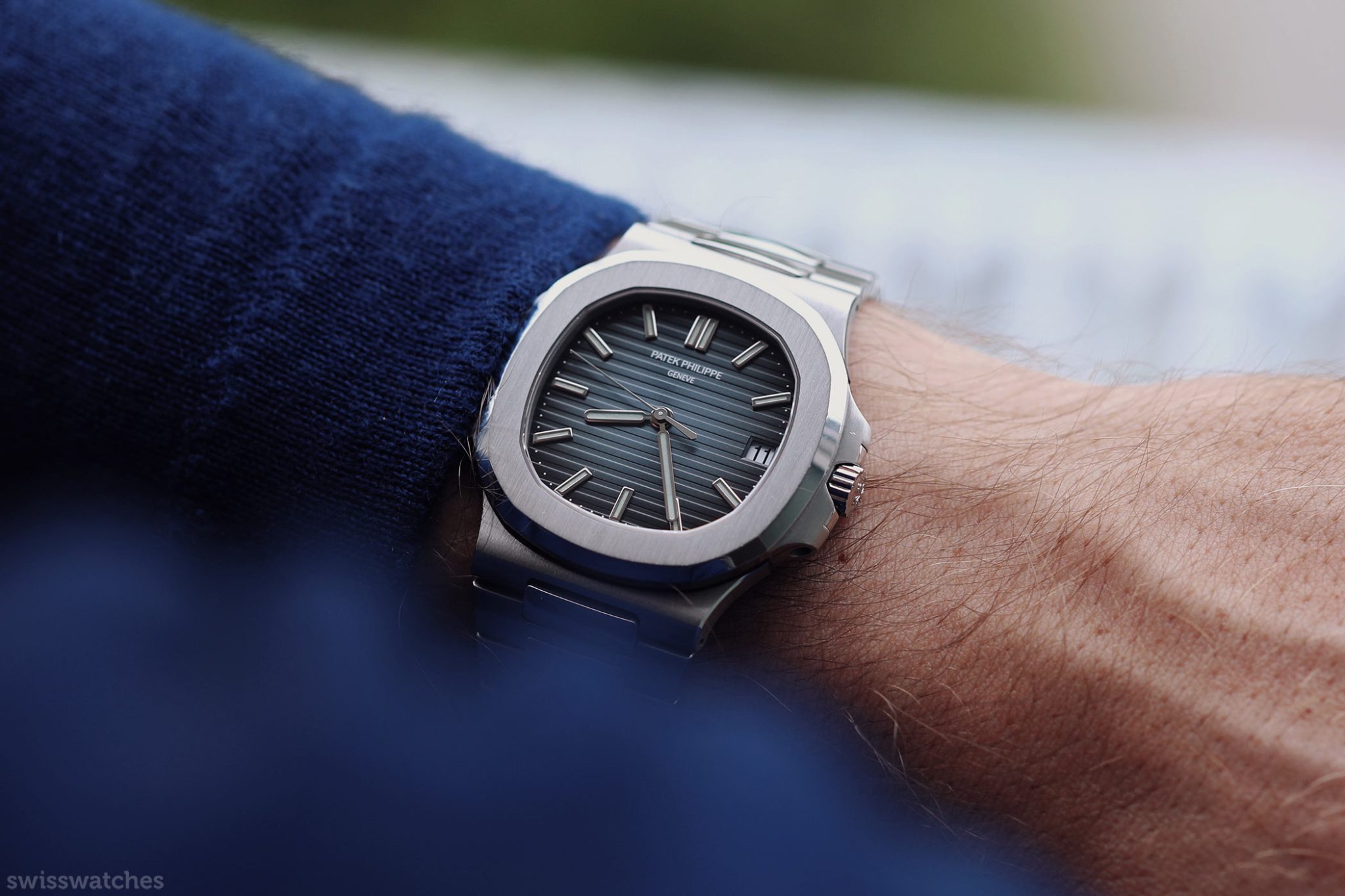
Patek Philippe Nautilus
Stern, the son of an entrepreneur, was clear-minded on the topic: “People were becoming more active. Many were doing sports for the sake of their health and were now looking for the first time for a robust wristwatch that they could wear while doing so.” He was therefore happy to let himself be seduced by the designer’s idea, but initially remained cautious: “We decided to produce a prototype. Only then was the final decision made to actually build this watch.”
A legend was born. Of course, it helped that the designer was not entirely unknown: Gérald Genta had already designed a sporty steel watch four years earlier, the Royal Oak for Audemars Piguet, another design classic.
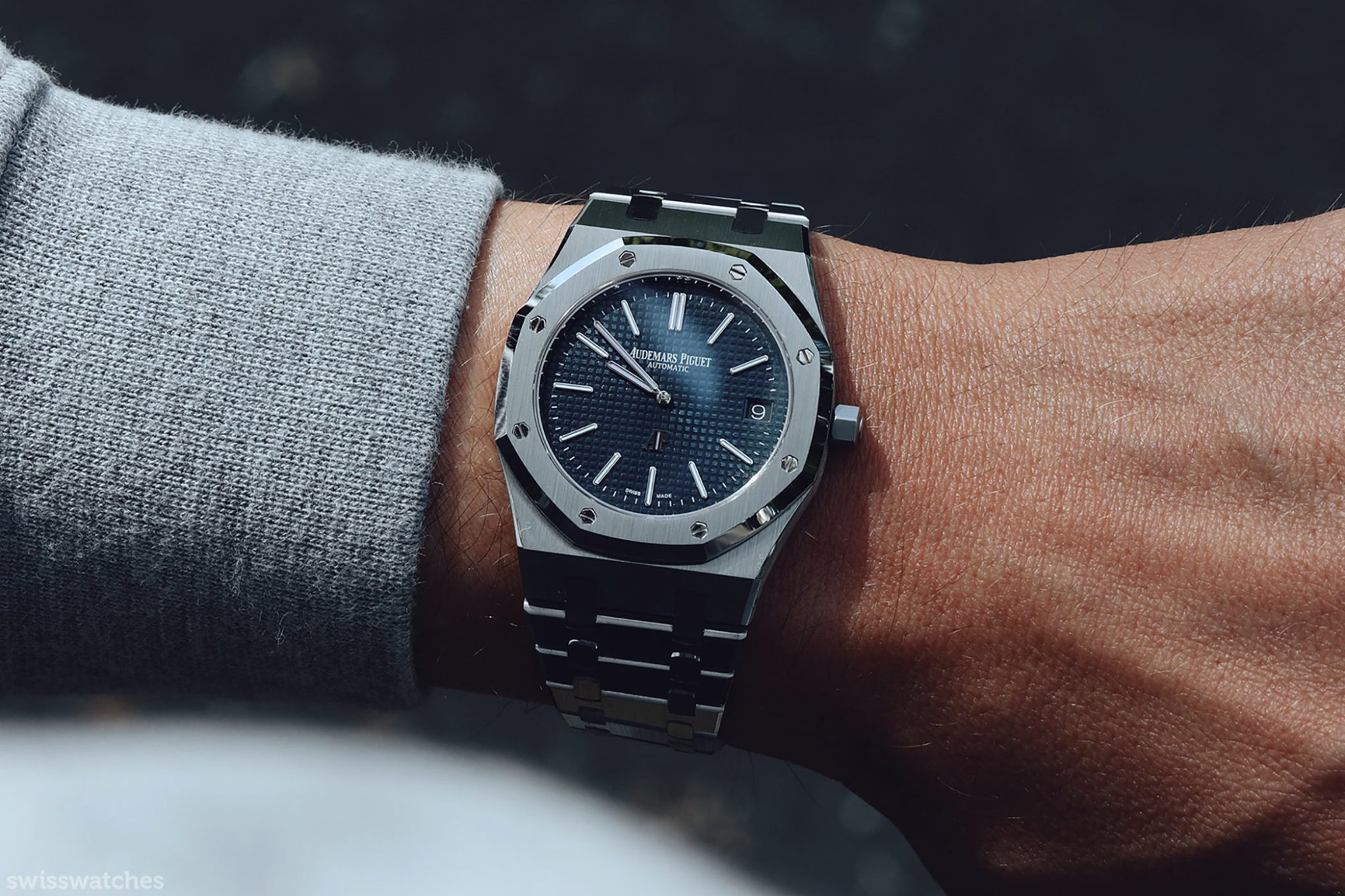
Audemars Piguet Royal Oak
The new project, however, was intended to crown his previous work and was actually more technically complex. Speaking to Patek Philippe magazine decades later, Genta’s wife Evelyn commented, “It was Gérald’s favourite watch. He loved his Nautilus.” It was also said that of all the watches he so loved, “he liked the prototype best.” This should make clear to collectors where to look for the holy grail of Nautilus collector pieces. Genta never let go of the Nautilus; shortly before his death a good ten years ago, he even worked on a new dial and helped Patek to relaunch the ladies’ version more than two decades after his great success.
Gérald Genta’s masterpiece
Given that no-one knows the various Rolex designers, why is the name Gérald Genta actually so well known? The reason we don’t know the names of the designers of most of the other iconic pieces is because there is usually never a single creator to attribute the designs to.
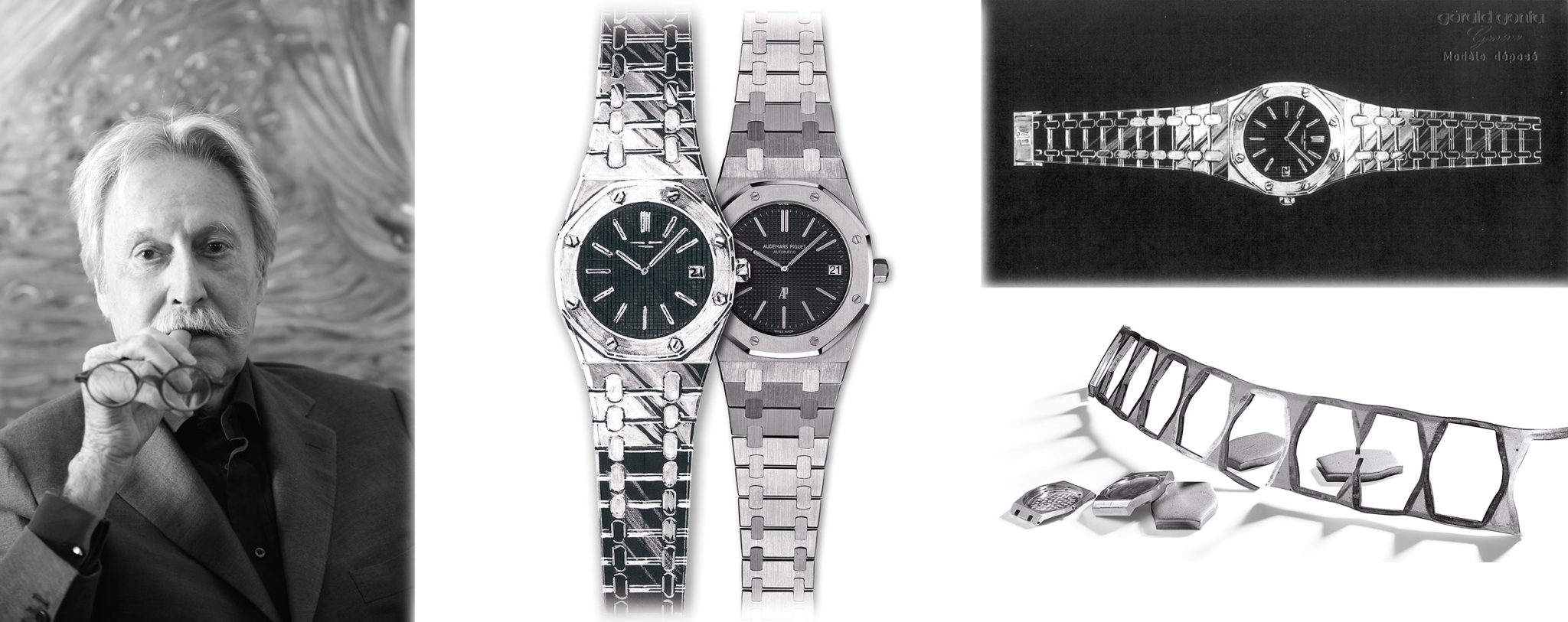
Royal Oak & Gérald Genta
Most watches have been created in an evolutionary rather than revolutionary fashion, and more in many iterative processes than in one grand sweep. Genta, on the other hand, pulled the Royal Oak and later the Nautilus out of his hat, demonstrating not only his distinctive style, but also technical know-how and the audacity to imagine that in the age of the quartz watch, people would wear an intricately handcrafted steel sports watch that, in the year it was unveiled, cost around $3,100 – the same as a brand new Jaguar. So this is not about the vanity of a designer, but a genius in his field. This is the real reason why we will continue to remember his name.

Nautilus & Gérald Genta
Credit © geraldgenta-heritage.com
The art of making complex things look simple
Building a 120-meter water-resistant diver’s watch that was also to be highly elegant presented engineers in the 1970s with major challenges. So did the stainless-steel used as the case material, given it was very difficult to machine at the time. It wasn’t until a prototype had been made that the engineers also realised the complexity of the whole project. Without the computer-aided design and manufacturing processes common today, countless individual steps were necessary to produce the intricately shaped octagonal case with slightly rounded edges and subtly curved bracelet links.
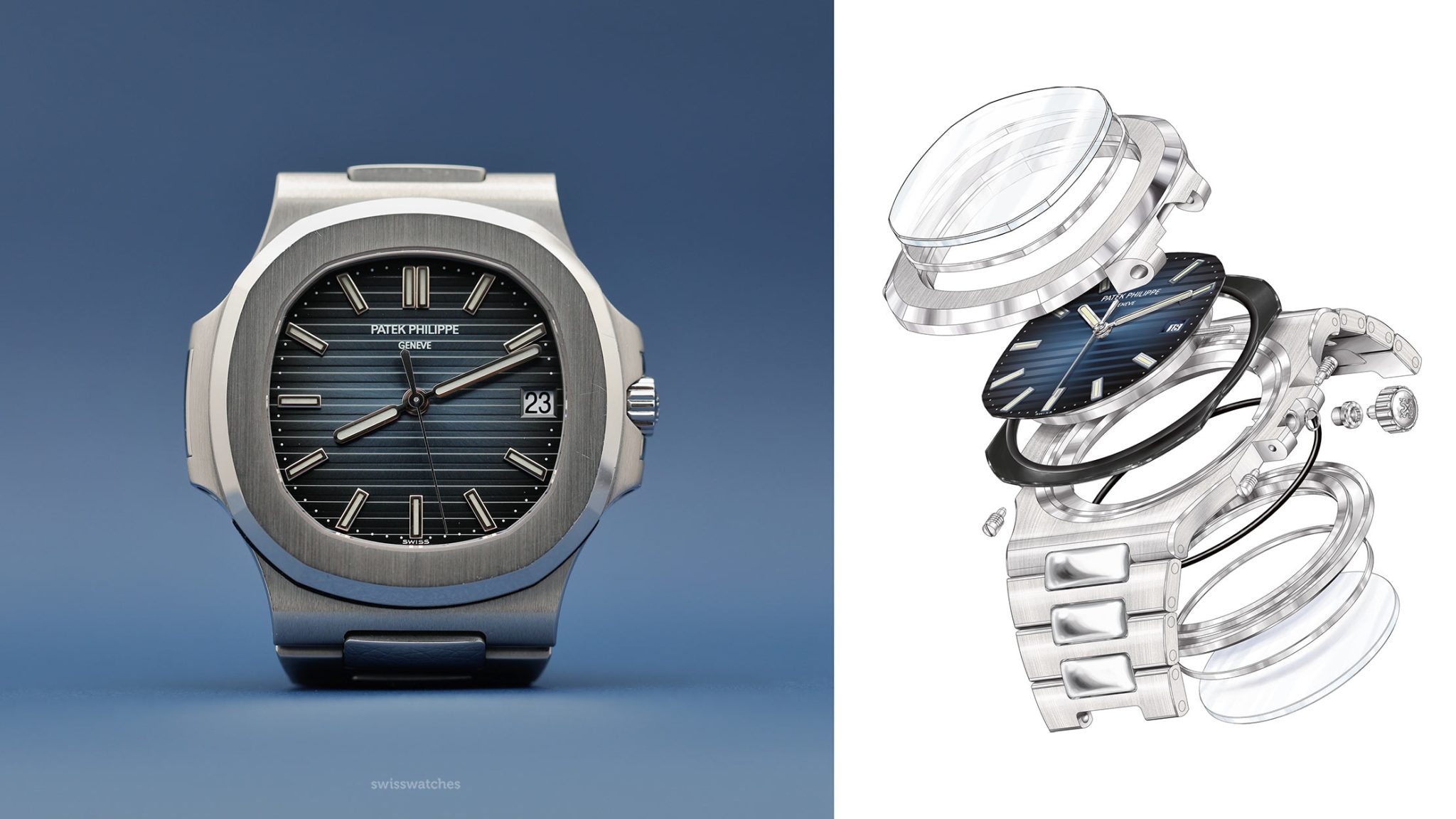
The initial two-piece monobloc case was complicated by the fact that the parts were screwed together via side hinges, just like a real porthole. When the first Nautilus was presented at Baselworld, the world’s most important watch fair at the time, in the spring of 1976, everyone involved was eager to see how the project, which had taken two years of painstaking development, would be received by dealers and customers.
A good idea takes time
The response was pretty restrained, to put it mildly. “Nobody had expected such a modern watch from Patek,” Stern later recalled. What’s more, the watch, presented in a modern cork box, was more expensive than many gold watches. Had the future head of the company, Philippe Stern, gone too far? Of course, the story has a happy ending, as the Stern family trusted their visionary son. And while he did not yet hold a leadership position in the company when the Nautilus was in development, he was appointed General Manager in 1977, just one year after the Nautilus was launched.
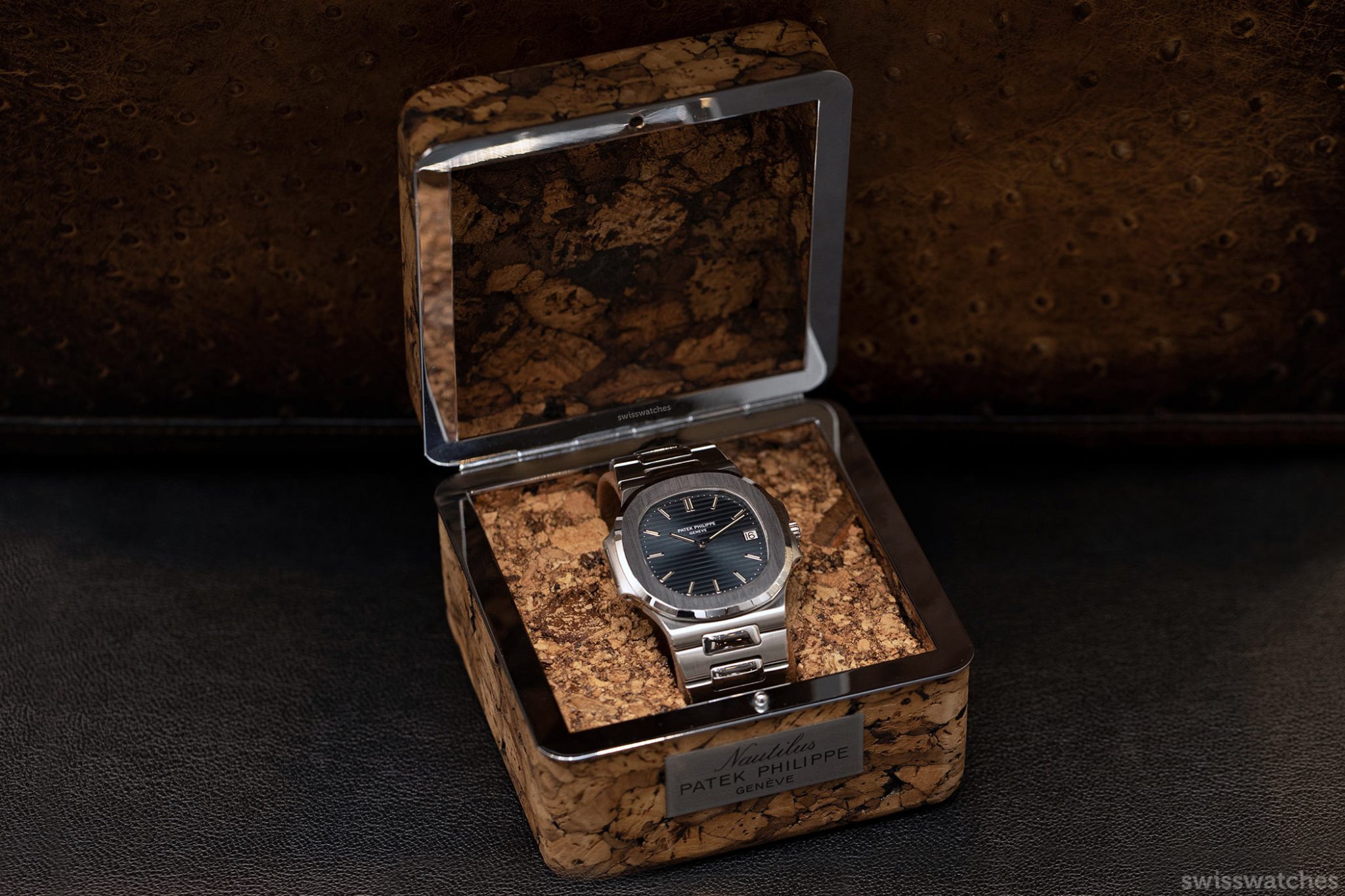
Patek Philippe Nautilus Ref. 3700-1A in a vintage cork box
Stern Junior now went on the offensive with the model, advertising the elegant diver’s watch with the claim: “They work as well with a wet suit as they do with a dinner suit.” He made the steel watch presentable, and in doing so, he demonstrated great commercial skill. While the large men’s model was initially difficult to sell, the ladies’ version of the Nautilus that launched in 1980 was a hit, as was the midsize model with a 37.5 millimetre case launched a year later.

A collection is born
Slowly, and with care that few family-owned companies can boast of today, the Stern family developed the Nautilus into a proper watch family. Collectors took notice and affectionately named the watch “Jumbo“. While the company was celebrating its 150th anniversary in 1989 with the most complicated mechanical watch in the world, Philippe Stern was already working on the next generation of the Nautilus. It was to be in no way inferior in technical terms to the other outstanding mechanical watches of the manufacture, because, as mentioned, that is the credo of Patek Philippe to this day: to always strive to build the best watches in the world.
To this day, the manufacture of the Nautilus is not only a watchmaking challenge, and thus a technical one, but above all, a challenge in terms of craftsmanship. The Patek Philippe magazine once described in detail the madness surrounding the manufacture of the bracelet; a prime example of how complicated the elegant can be. It involves satinage, polissage, anglage, avivage, sablage, émerisage, feutrage, lavage, lapidage – the métier of the polisher is its own universe of terms and techniques, which not only, but especially for the Nautilus, goes hand in hand with specific tools and a wide variety of techniques. In the bracelet design of the Nautilus, one of the first watches ever to feature fully integrated lugs, “h-shaped” outer links encircle smooth inner links and shimmer like pearls.
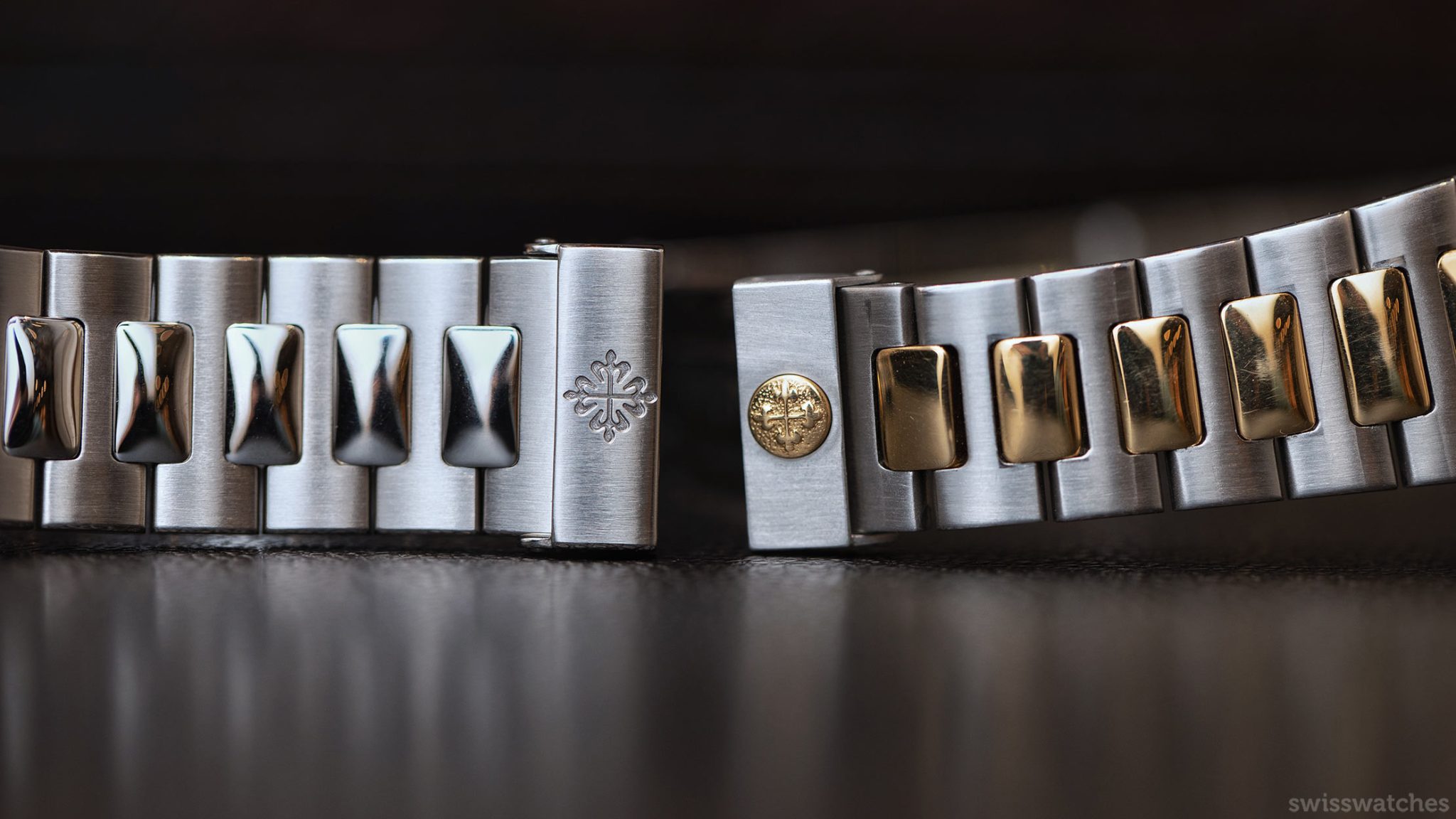
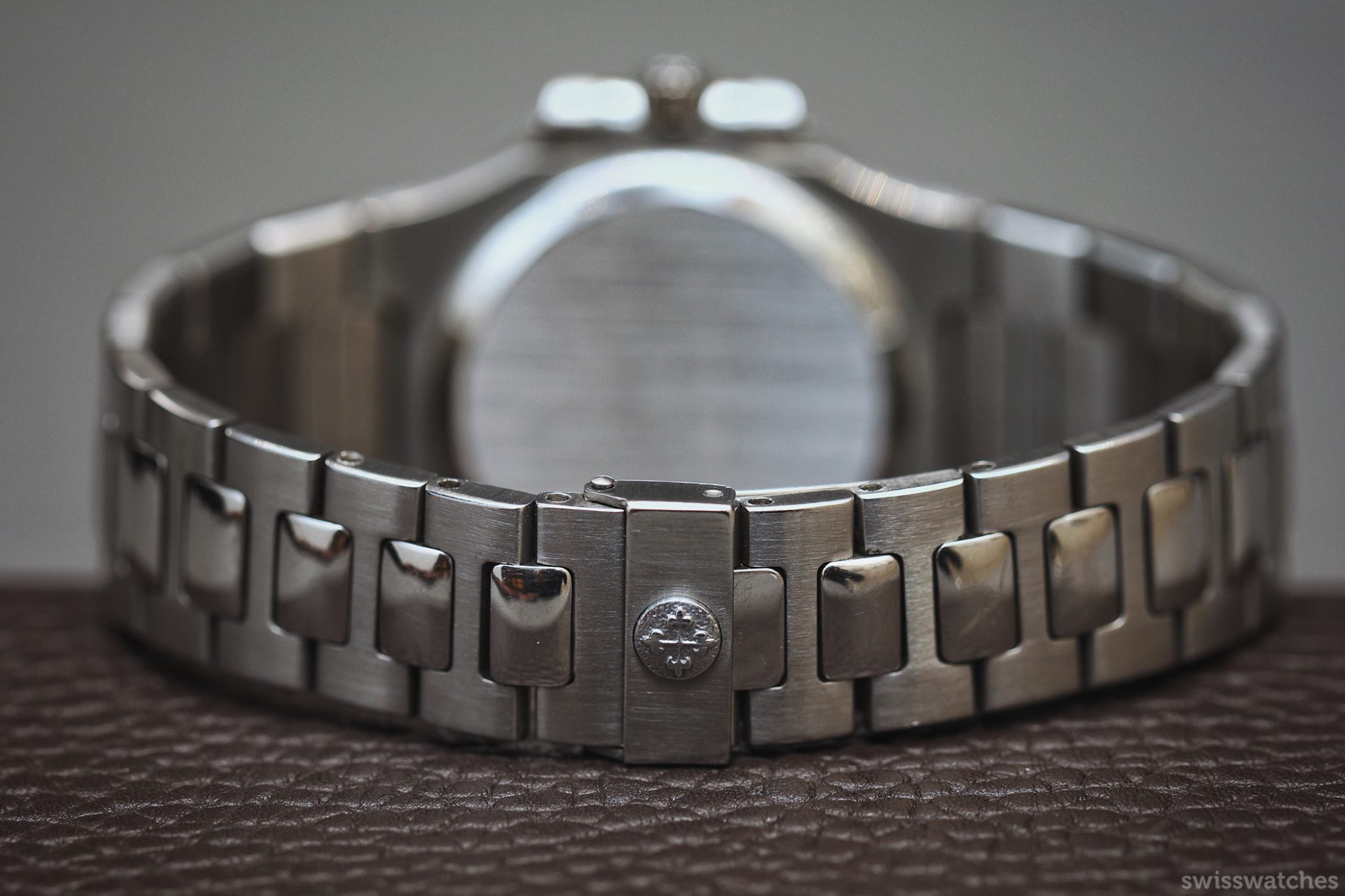
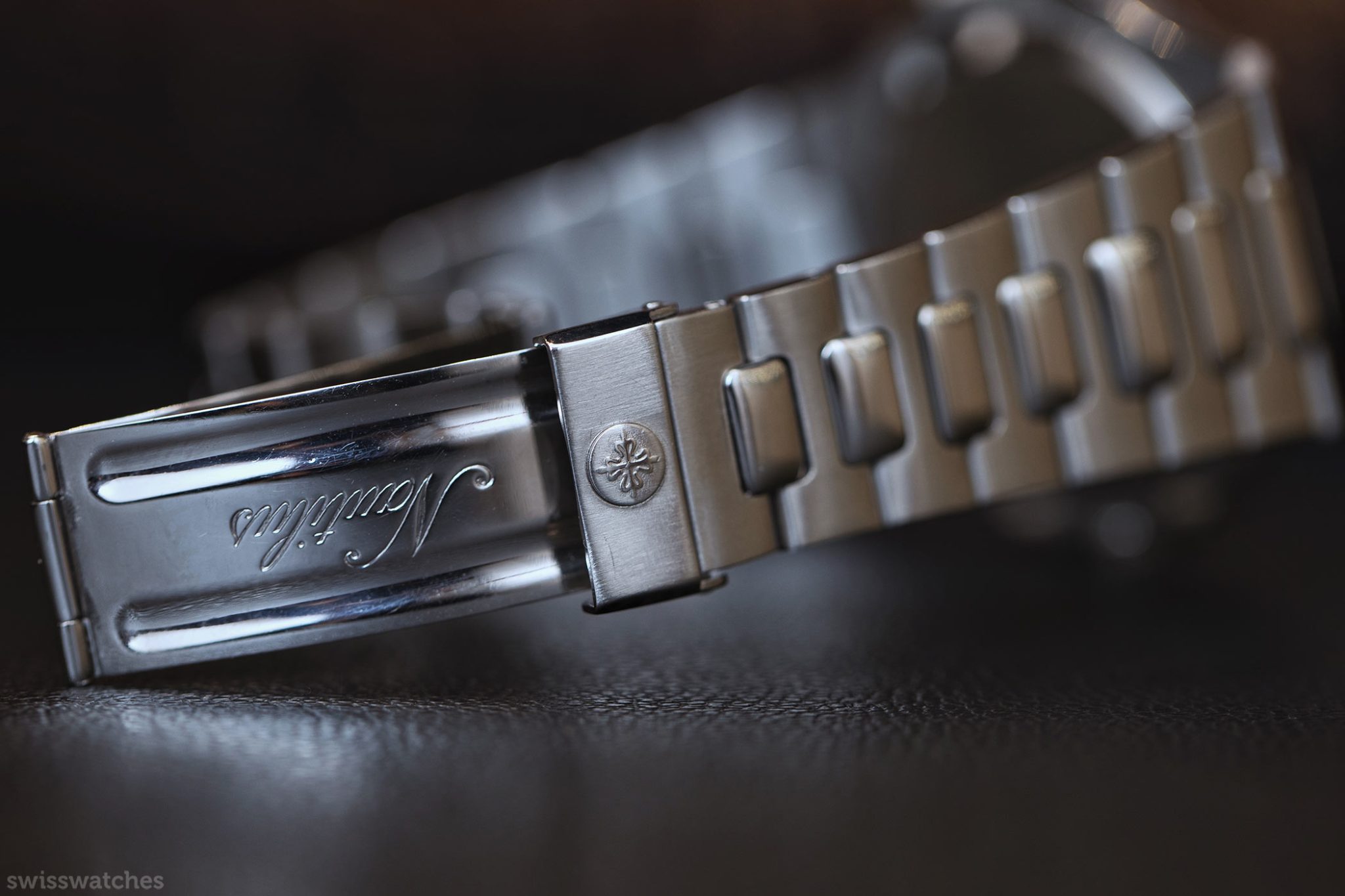
If you add together the screws and metal components that connect all the links with the 15 parts for the bi-fold clasp, you need 159 individual parts just to create the Nautilus bracelet. Its assembly can only begin once a polishing machine has been over each individual element. Furthermore, since the whole bracelet tapers elegantly towards the clasp, it must also be polished as a whole at the end of the assembly process. Extremely precisely applied adhesive foils are used to prevent the polishing of the inner links from scratching the edges of the outer ones. Even with today’s three-piece case, dozens of steps are required for each element. I know of no other steel watch where such an effort is made by hand.
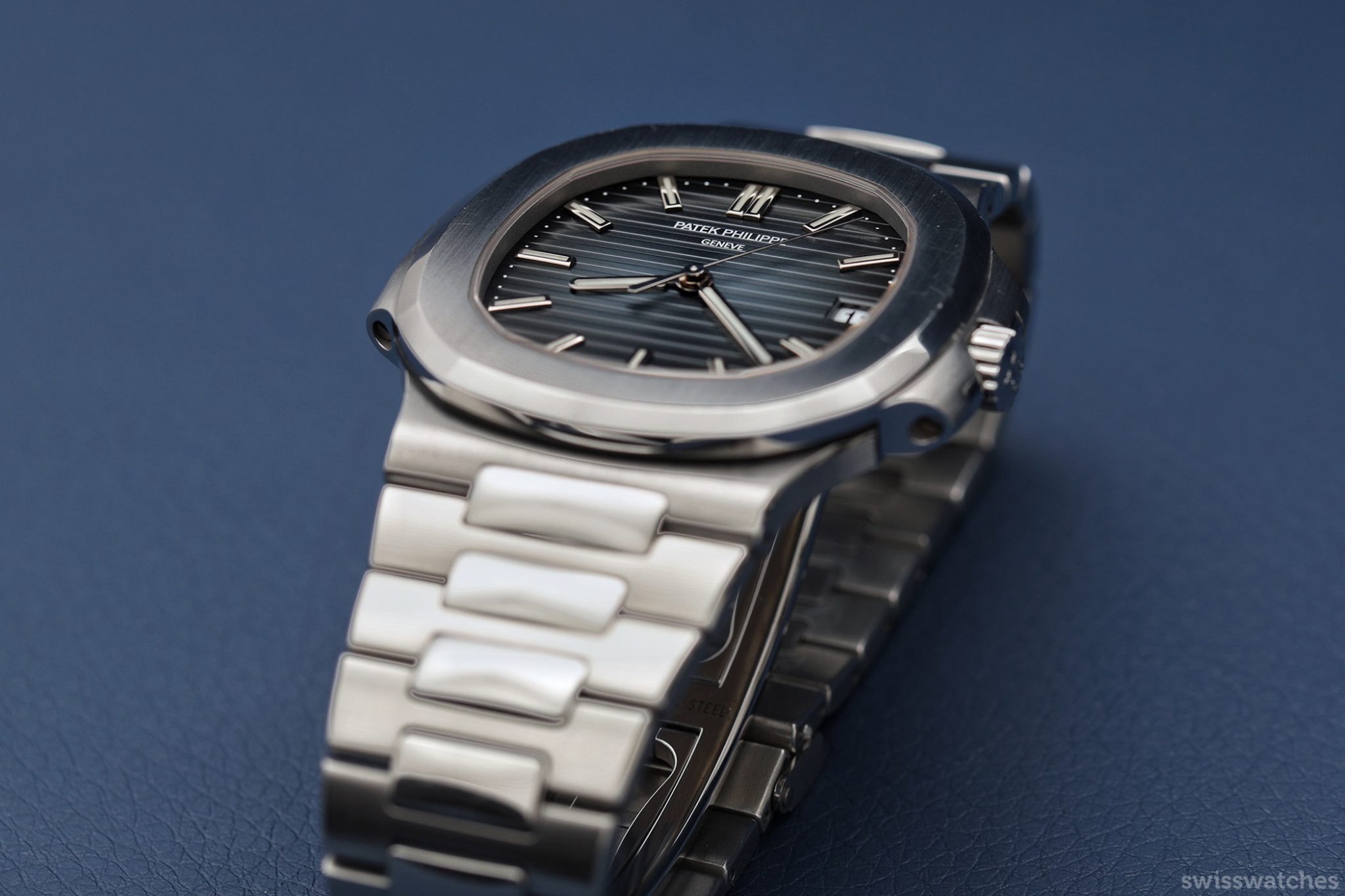
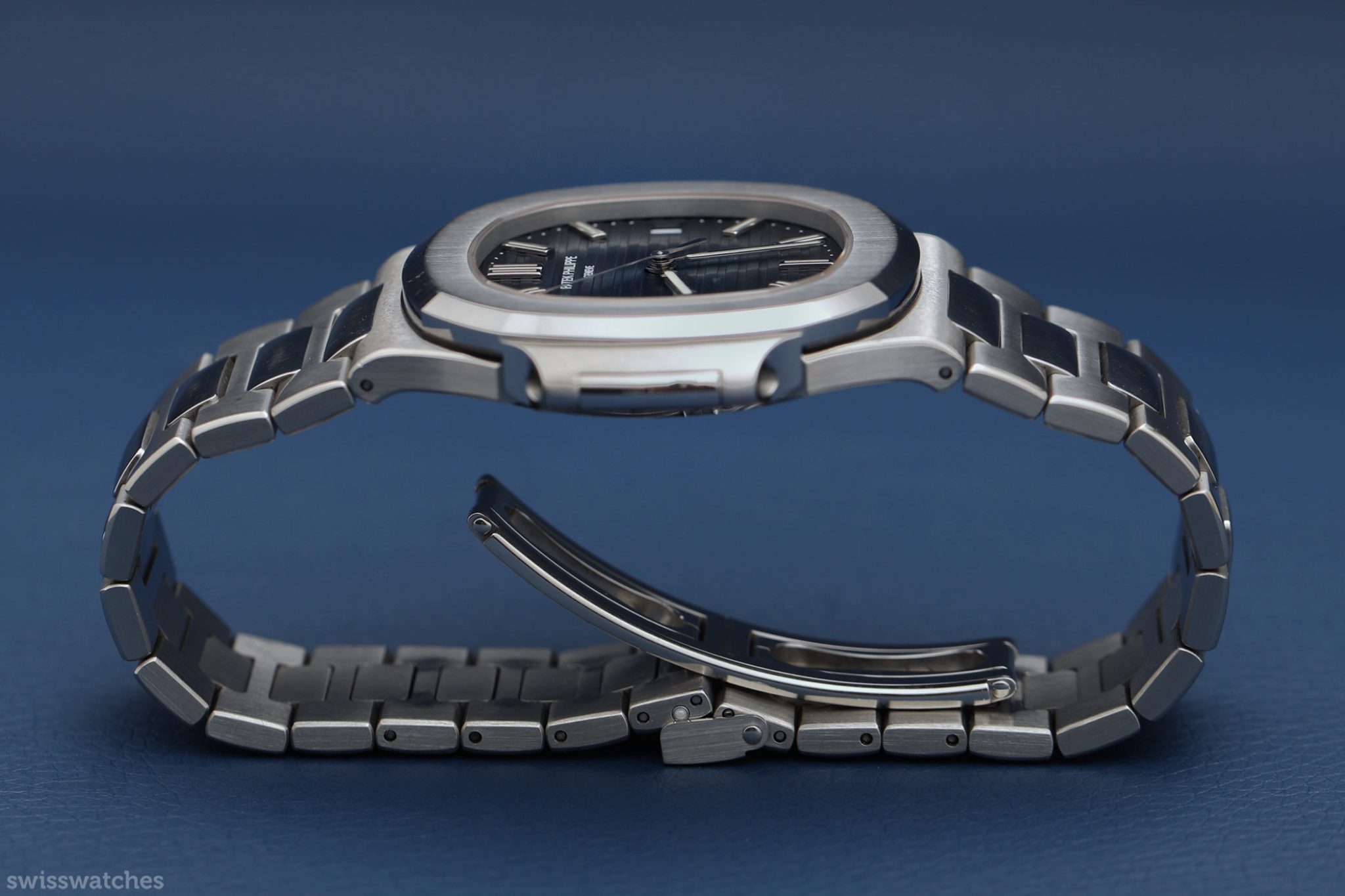
A cult classic owing itself to skill
To really understand the cult around this model, we should go a bit deeper at this point. The Nautilus was by no means just about a trend or chic design. At Patek, everything is always about the core; the movements of the watches. Even before Genta’s design, in the first half of the 70s, engineers at Patek Philippe started thinking about a wristwatch that didn’t need to be wound and yet could compete in some ways with quartz watches, although not with the same level of precision, of course.
In the authorised Patek Philippe biography, my British colleague Nicholas Foulkes, who has had the privilege of immersing himself in the history of the House of Patek Philippe as few others have, quotes Philippe Stern, who recalls an interesting detail: “We thought that maybe we could make it more elegant than a quartz watch.”
Today, in retrospect, it seems easy to logically comprehend certain developments that were made. In order to understand the enormous foresight with which the Stern family behaved at the time, in contrast to almost the entire Swiss watch industry. I would nevertheless like to look at a few interesting circumstances at this point, and ask the question as to whether each of us would have behaved so courageously in the same situation.
Entrepreneurial courage versus risk
Philippe Stern was only in his mid-twenties when he returned from a stay in the USA at the end of the 1960s. The Patek Philippe company produced, as it proudly stated in its advertising, only about 23 watches per day.[2] The company was proud of this low production figure primarily because it illustrated the enormous manual effort with which each Patek watch looked forward to its completion. In addition, not all parts of the wristwatches were manufactured by the company itself. This was also unusual at the time.

Philippe Stern
President of the Geneva watch manufacturer Patek Philippe from 1977 to 2009
Traditionally, the Swiss watch industry resembled a dense network of highly specialized family businesses. Global trade also functioned according to this principle. However, a change was becoming increasingly noticeable. Consolidation and concentration of manufacturing capacities became ever more important in larger companies. The great technical achievement of watchmaking in the late 1960s, the first automatic Swiss chronograph movements, had not been made possible by a single pioneer, but rather by a consortium of Heuer and Breitling, since the development also swallowed up vast sums.

Geneva, Switzerland
These major changes were also felt in the corporate forms of the companies themselves; Girard-Perregaux was the first watch company to go public in 1969, followed the next year by Heuer. At the same time, however, a new player appeared on the market: Japan. Seiko, for example, presented a similar chronograph mechanism in the same year as the Swiss industry, whose technical lead had melted away. Philippe Stern Junior, who was increasingly entrusted with the company’s business, was already aware at the end of the 1960s that the both industry and markets in general were facing enormous upheaval.
Independence as a factor for success
Even in December 1970, long before the industry as a whole plunged into a crisis, Stern Junior made it clear in an interview that he never wanted to join any group of companies, but rather to “develop high-quality watches for the needs of an appreciative and demanding clientele,” as can be read in the company biography. Above all else, according to the company history, it was necessary to protect and strengthen the horology house and its image as a luxury company.

The new Patek Philippe Manufacture – 2020. Geneva, Switzerland.
Statements like these read logically today, but in truth this was an approach that would not really pay off until many years later: “In a world where standardisation has become the rule, prestigious production bears all the more weight.” Stern said it and knew it; however, he had yet to prove it by means of ultra-elaborate mechanics that were nevertheless suitable for everyday use.
Balancing act: Increasing units while keeping collectors happy
Philippe Stern quickly realised – and thus probably saved the company’s independence during the quartz crisis – that the company had to grow in order to remain viable. Today, many people might smirk at the number of pieces produced in the sixties, but by the beginning of the 70s, the company had moved from producing 6,000 to 15,000 watches per year. 366 employees worked at Patek at that time. One explanation for the enormous desirability of watches from Patek Philippe is, among other things, that they never turned the volume up too much, although there was always pressure to produce significantly more watches, not least because dealers introduced their own waiting lists for the Nautilus.
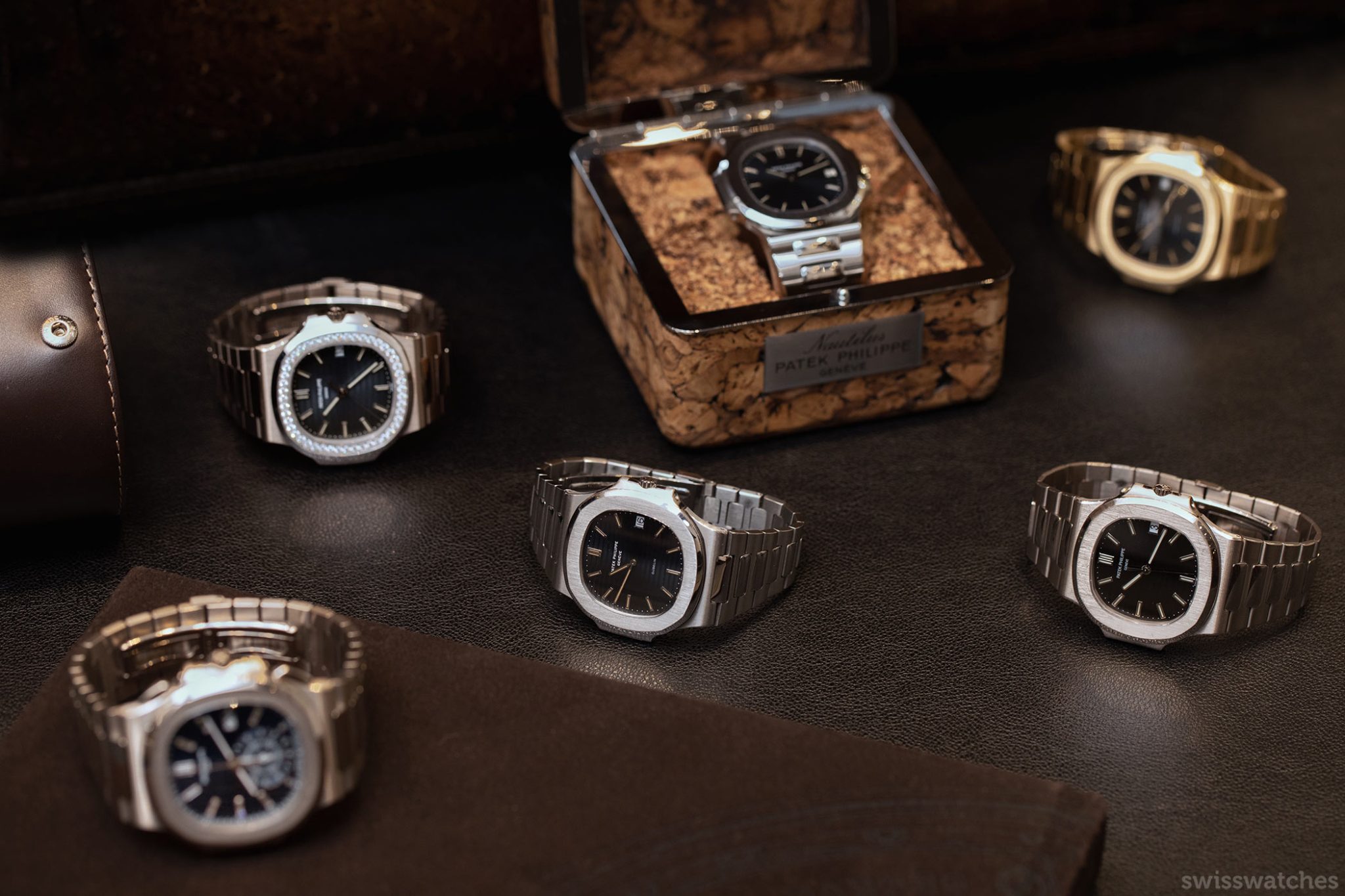
Today, almost 50 years later, annual production is still only around 62,000 watches. And what’s also interesting in this context is that even then (as well as today, which we’ll see later), Patek remained true to its motto of offering as wide a range of watches as possible, rather than limiting itself to one area or tying its corporate identity to a single model. Do you see the point I am making? Such an undertaking would have been perfectly logical in terms of production and economics, but deadly in the volatile market of the early seventies.
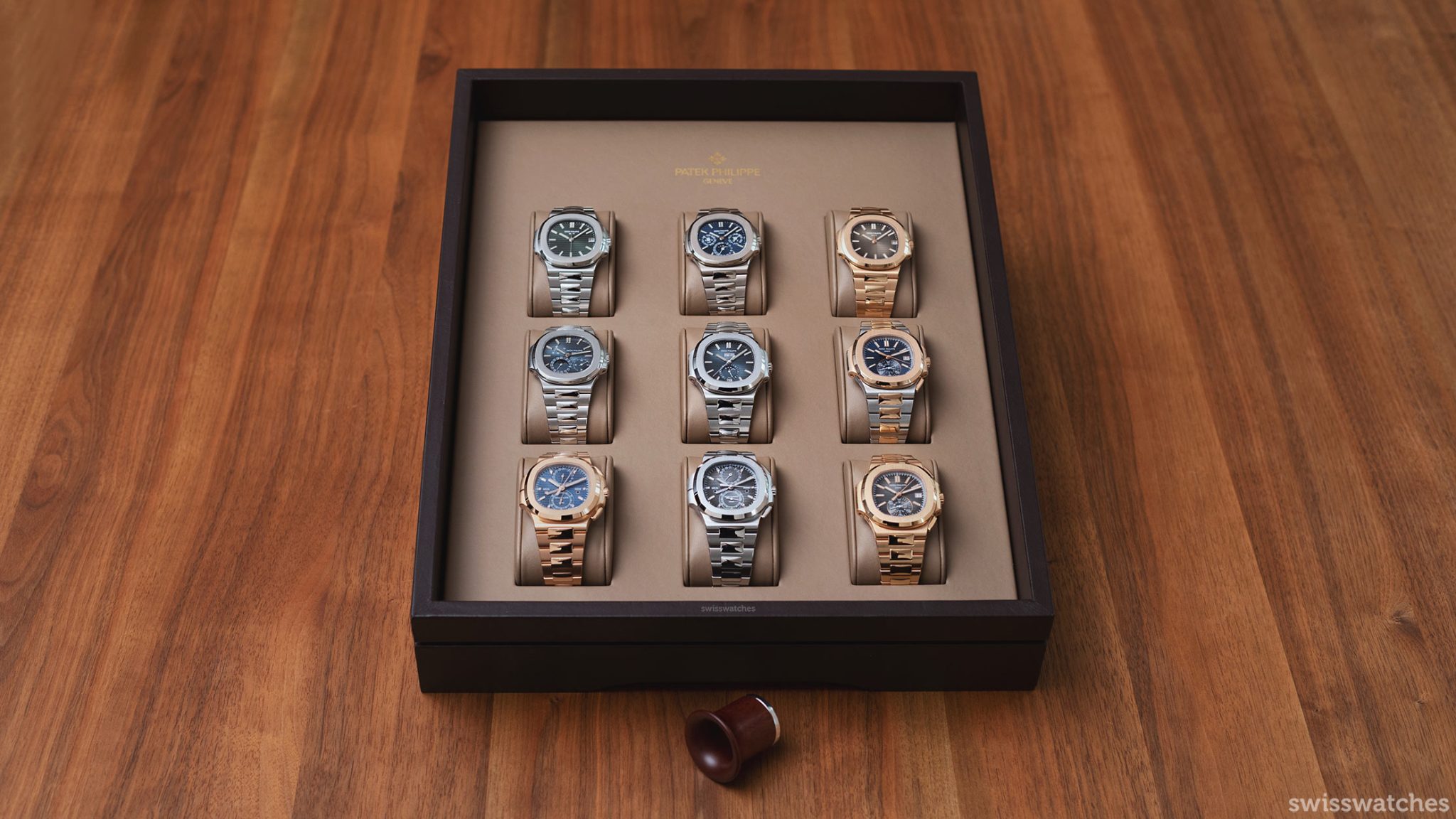
It was also absolutely natural for Philippe Stern, by the way, to produce not only the most complicated wristwatches in the world, but also electronic timepieces for train and air traffic, slim 60s models such as the Ellipse d’Or as well as haute joaillerie ladies’ watches, solar-powered cathedral pendulums and extremely complicated pocket watches, such as the famous watch for Seth G. Attwood, whose secular perpetual calendar took into account not only the time leaps every four years, but also those every four hundred years.

Credit © Patek Philippe
Then, disaster struck. The availability of cheap quartz watches on tap, and the departure of the dollar from the gold standard, saw the Swiss watch market truly collapse. The world market share of Swiss watches fell from 43 percent in 1977 to 15 percent in 1983, while the number of employees dwindled from 90,000 to less than 40,000. Even Patek had no choice but to lay off employees.
A luxury watch versus a crisis
All this must be taken into account if one is to understand the courage with which the Nautilus was created in 1976. Take 1978, for example, two years after the launch of the Nautilus, when Philippe Stern returned from a trip to Asia. He returned to his workers in a depressed mood and described to them how, in the Far East, production on the assembly line was partly carried out according to Swiss methods but under conditions that the Swiss would simply not be able to compete with.[3]

Credit © Patek Philippe
Stern’s closing remarks were interesting. He nevertheless seemed “convinced that the Swiss product has a very positive future, as it has a strong brand image and is known on the world stage, where it can clearly distinguish itself from mass-produced goods through specialisation of a technical, aesthetic, or other such nature and excellent quality.”[4]

You have to be a visionary first and foremost; but a crisis is when true entrepreneurs reveal themselves. And Patek, as mentioned, was not exactly behind the times technically. By the end of the 1970s, it had already become independent thanks to the production of its own quartz movements, and in the early 1980s, it launched the first Nautilus ladies’ model – but more about that later.
Rise to icon status
Where does the enormous run on the Nautilus today actually come from? A common misconception is that Genta watches only became popular in recent years. The internet only made the collector market aware of the rarity of the watch and social media only served as a catalyst for a global, digital elite. The Nautilus as well as the Royal Oak have been popular for decades and were worn by style icons in the pre-Instagram era. They were – please allow me this joke – always the gold standard in luxury sports watches.
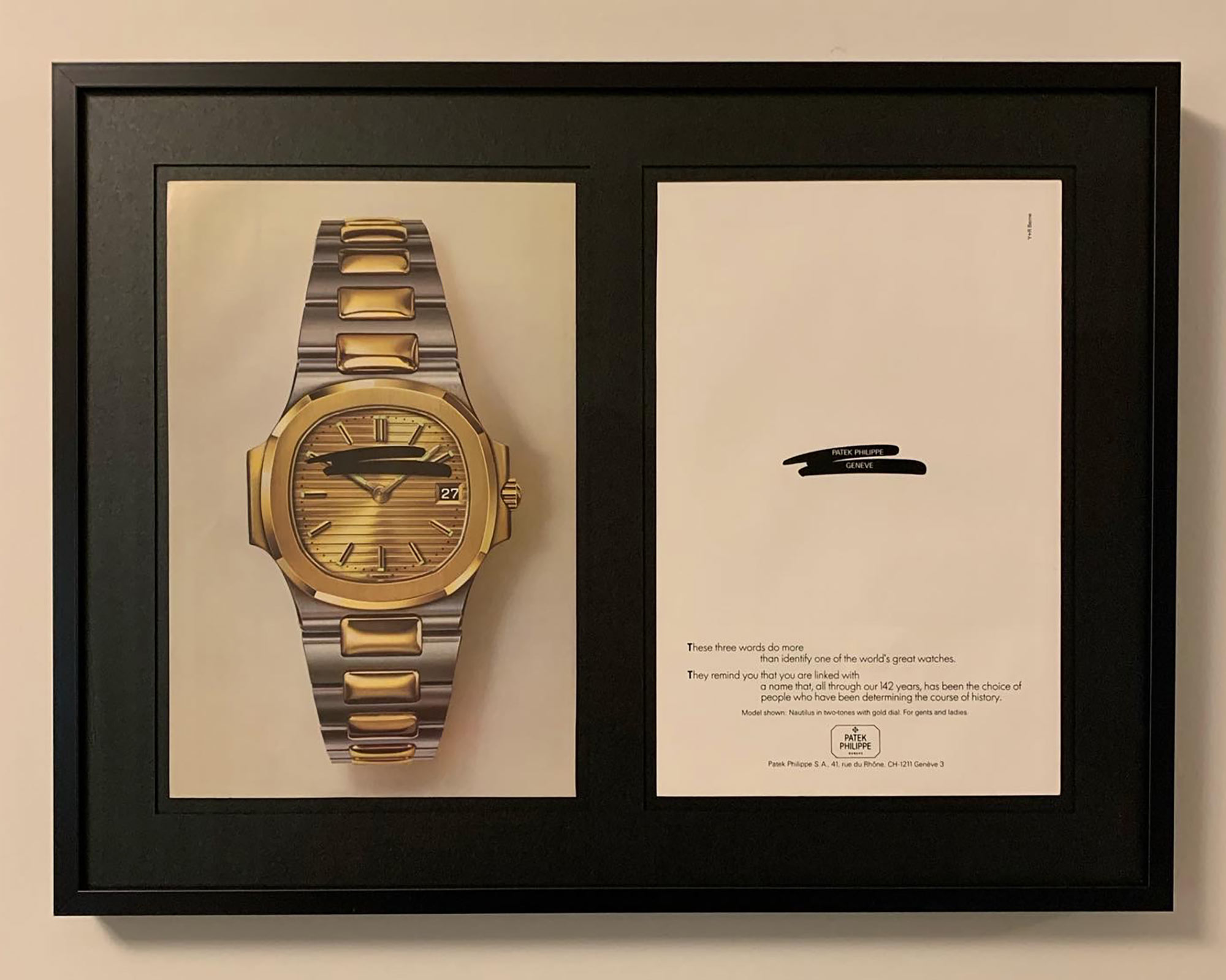
Credit © Horology-Ancienne
Over the last decade, thousands of high earners have got into the hobby of watch collecting. Easy money from central banks and a lack of alternative tangible assets has caused demand to rise for all the famous Swiss watch models, but exponentially, of course, for the most desirable ones. At the same time, production numbers have not increased nearly enough to keep up with this explosion in demand. You can see this in relatively common models like the Rolex Submariner, which has always been the most sought-after diver’s watch. But even Rolex is powerless, with hundreds of thousands of new collectors all wanting the one diver’s watch; unless they were to produce so many in the long run that they would completely spoil prices with it. This inevitably leads to the gap from the retail price widening further.
Long-term action as a corporate goal
As you can easily see from reading thus far, Patek produces all of its watch models with a vision of creating a long-lasting presence on the market. Surges in demand, as is currently the case, then naturally collide with low production figures (as with the Nautilus) because hardly any series steel sports watch is produced less frequently. It may sound strange, but the standard at Patek has always been watches made of precious metals, never of steel – and one would do well not to change that.
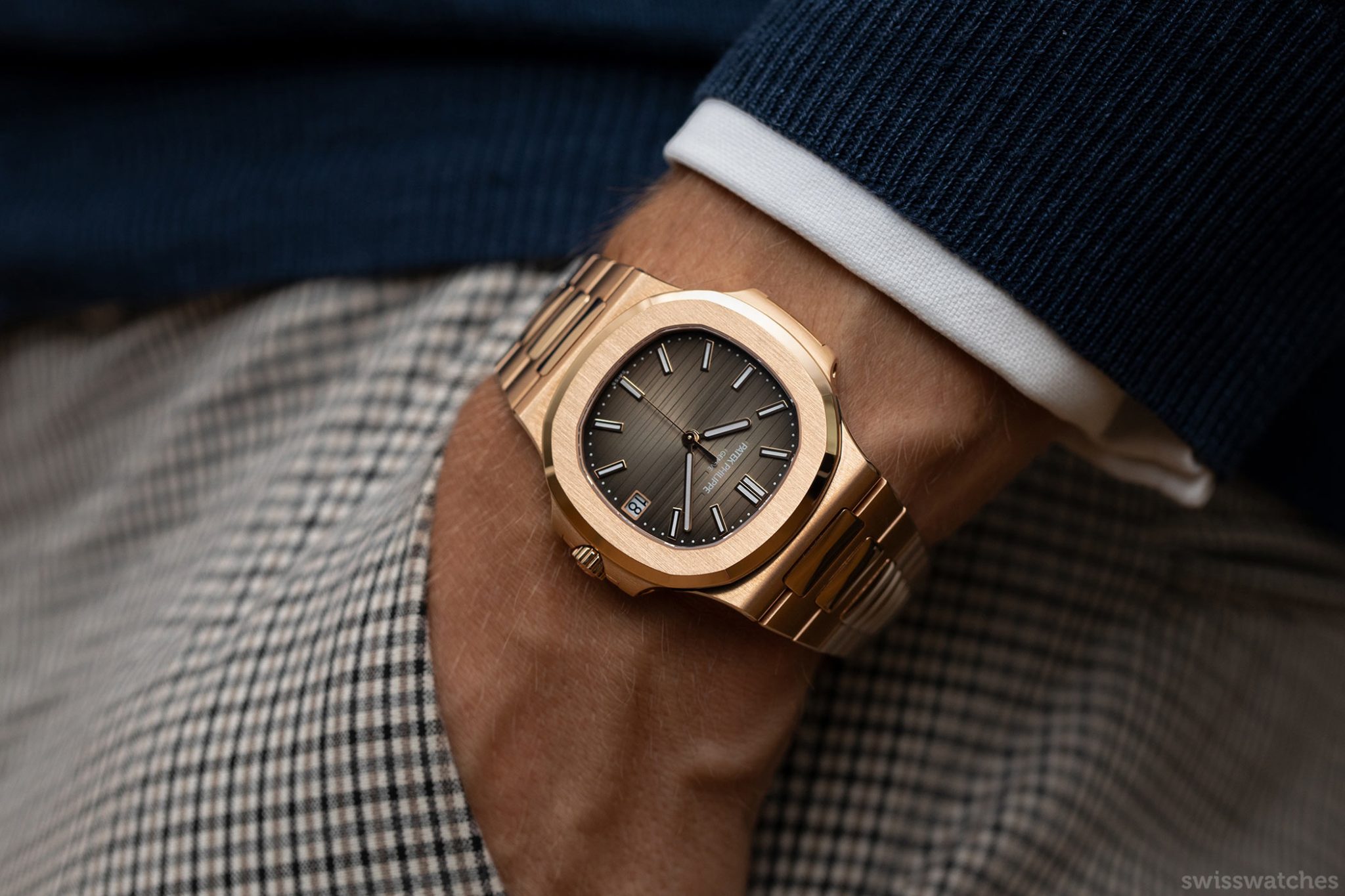
Both elegant and sporty – Nautilus 5711/1R
Another point that hasn’t been discussed enough, and that an observant collector recently posted on Hodinkee, is simply the fact that Western societies dress much more casually today than they did in the past, which means that most collectors would rather wear sports watches. It also gives the anonymous jeans-and-T-shirt millionaire his understated status symbol. While it would be easier with a three-piece suit, times have changed, and even if they hadn’t, a watch worn with a jacket is usually also covered by the cuff.
Competition copies the classics
To make matters worse, if you take a closer look at the watch market over the last five to ten years, the competition seems completely content with releasing obvious knock-offs of the five to ten or so iconic watch models. Their hope is to attract buyers who can no longer afford – or have given up waiting for – the watches they really want.
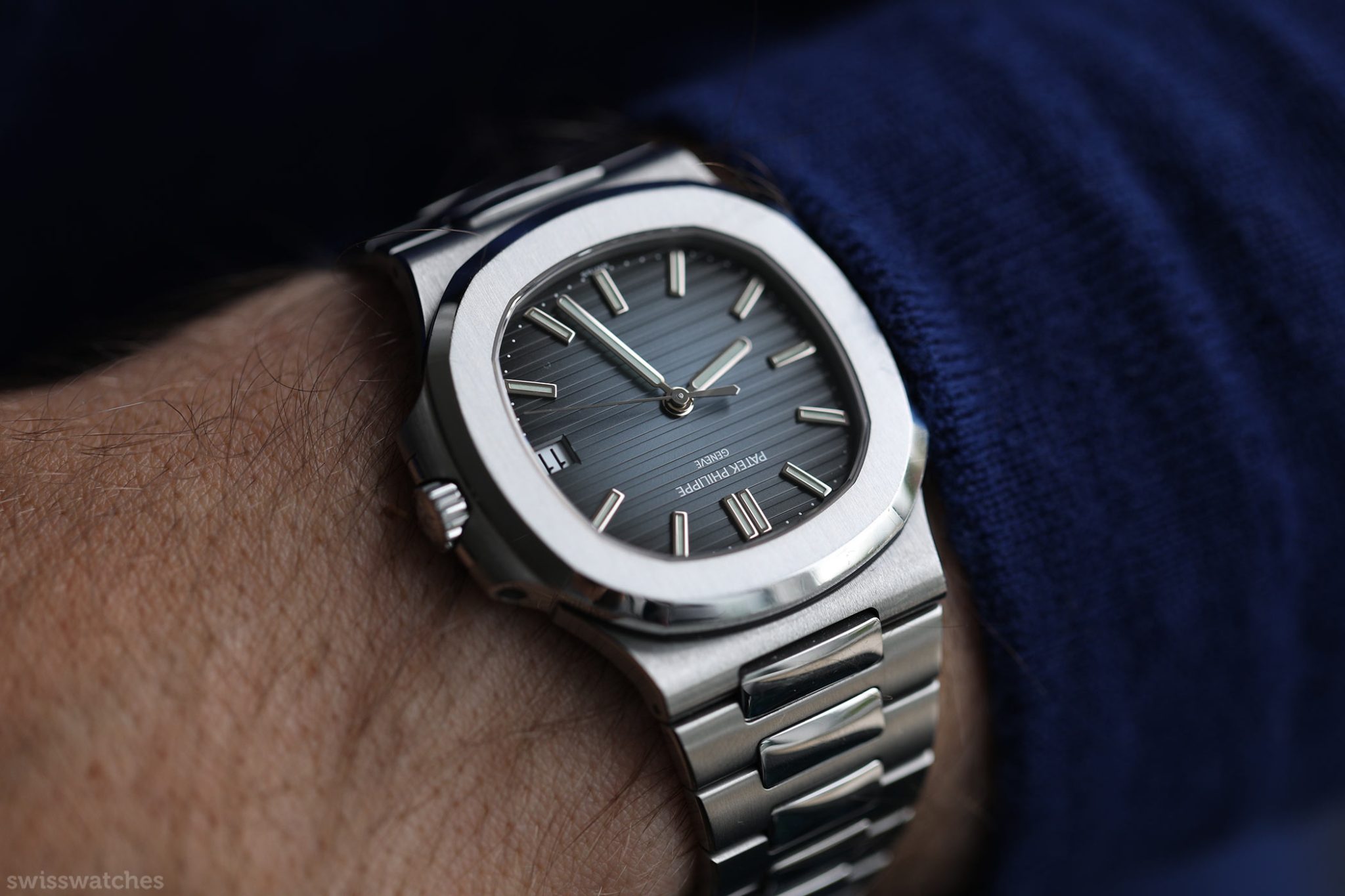
The timeless design – Nautilus 5711/1A
But when models like the Reference 5711 become pure status symbols and trophies for the performance-oriented digital elite, who are only casually interested in history and fine watchmaking, it quickly becomes dangerous for Patek Philippe. But then, company heir Thierry Stern pulled the emergency brake and took a product off the market. After all, if a customer isn’t really interested in something, but only in increasing its value, why would their son or daughter be?
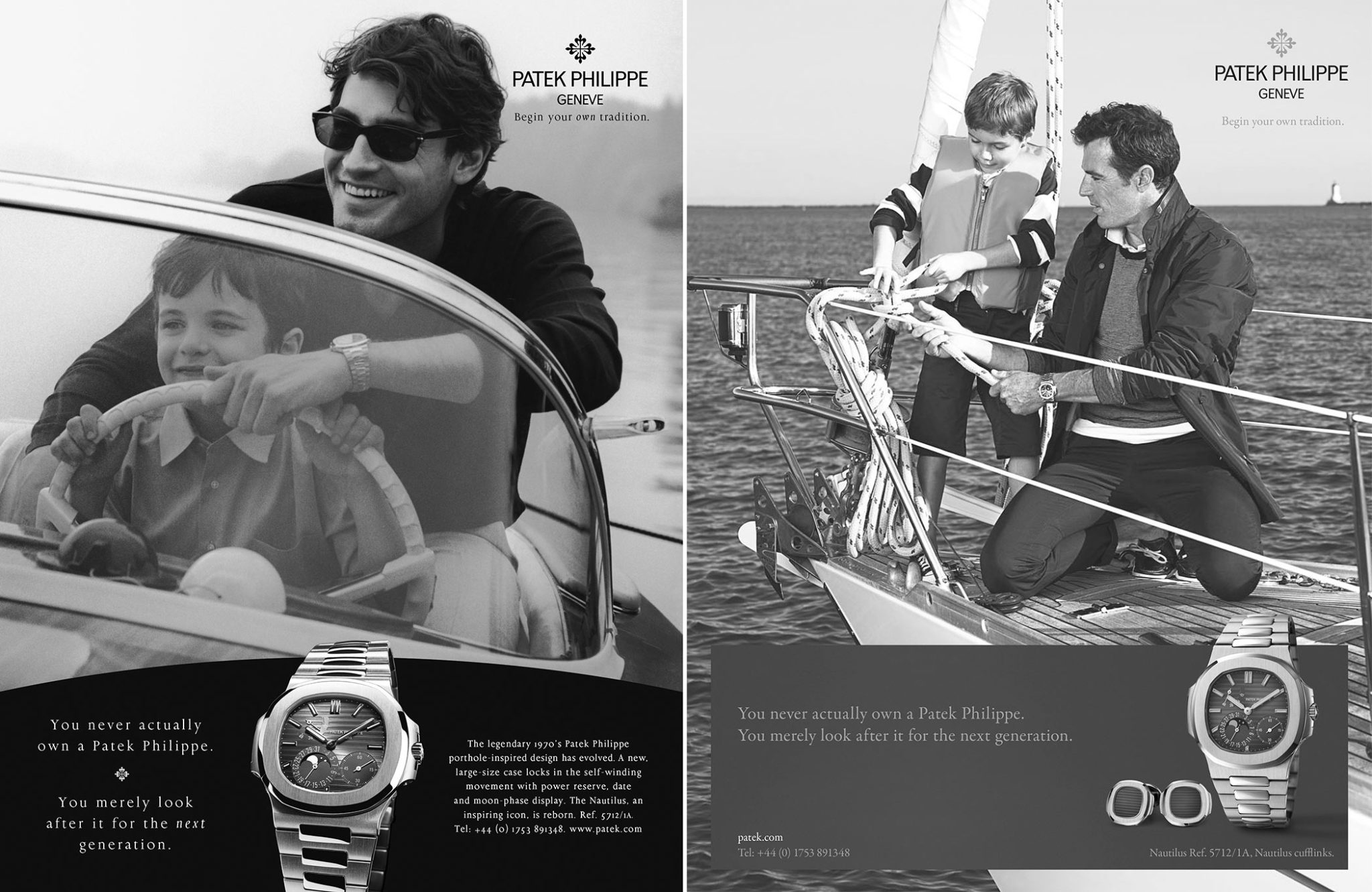
Patek Philippe Nautilus advertisement with reference 5712/1A
But it is this secret generational contract, in which collectors pass on their passion, that makes luxury brands in general – and Patek Philippe in particular – so valuable. It is not for nothing that the most famous advertising slogan in the watch world comes from the same company and reads: “A Patek Philippe never belongs to you alone. You enjoy it for a lifetime, but actually you keep it for the next generation.“
A history of the Nautilus movements
Although in the early 70s, alongside many watch companies, Patek tried to keep up with the extremely fast spreading quartz watches, Philippe Stern was convinced of the opposite with the Nautilus, insisting: “The Nautilus should remain a mechanical watch.”
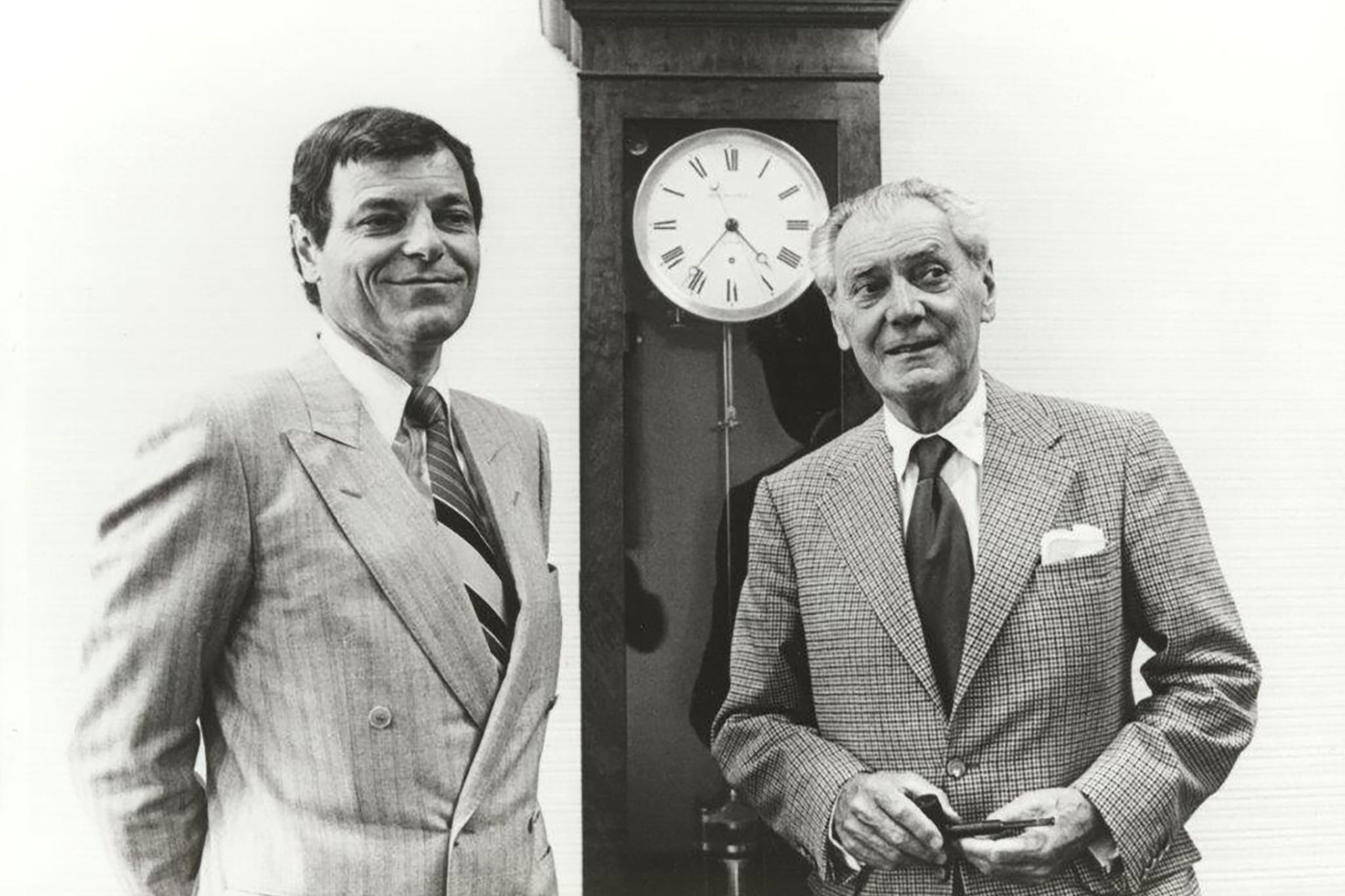
Philippe und Henri Stern – 1989
Appreciate the fact that this was being said by someone fully indulging in the industrial quartz watch business; just how well Patek Philippe knew its way around quartz watches was evident, for example, from the fact that Philippe Stern’s father, Henri Stern, set up an electronics department as early as 1948. By 1956, Patek had already announced its first fully electronic watch. Even if it may alienate collectors today, electronic timepieces back then were advertised with the same verve as mechanical ones, and, not infrequently, side by side.
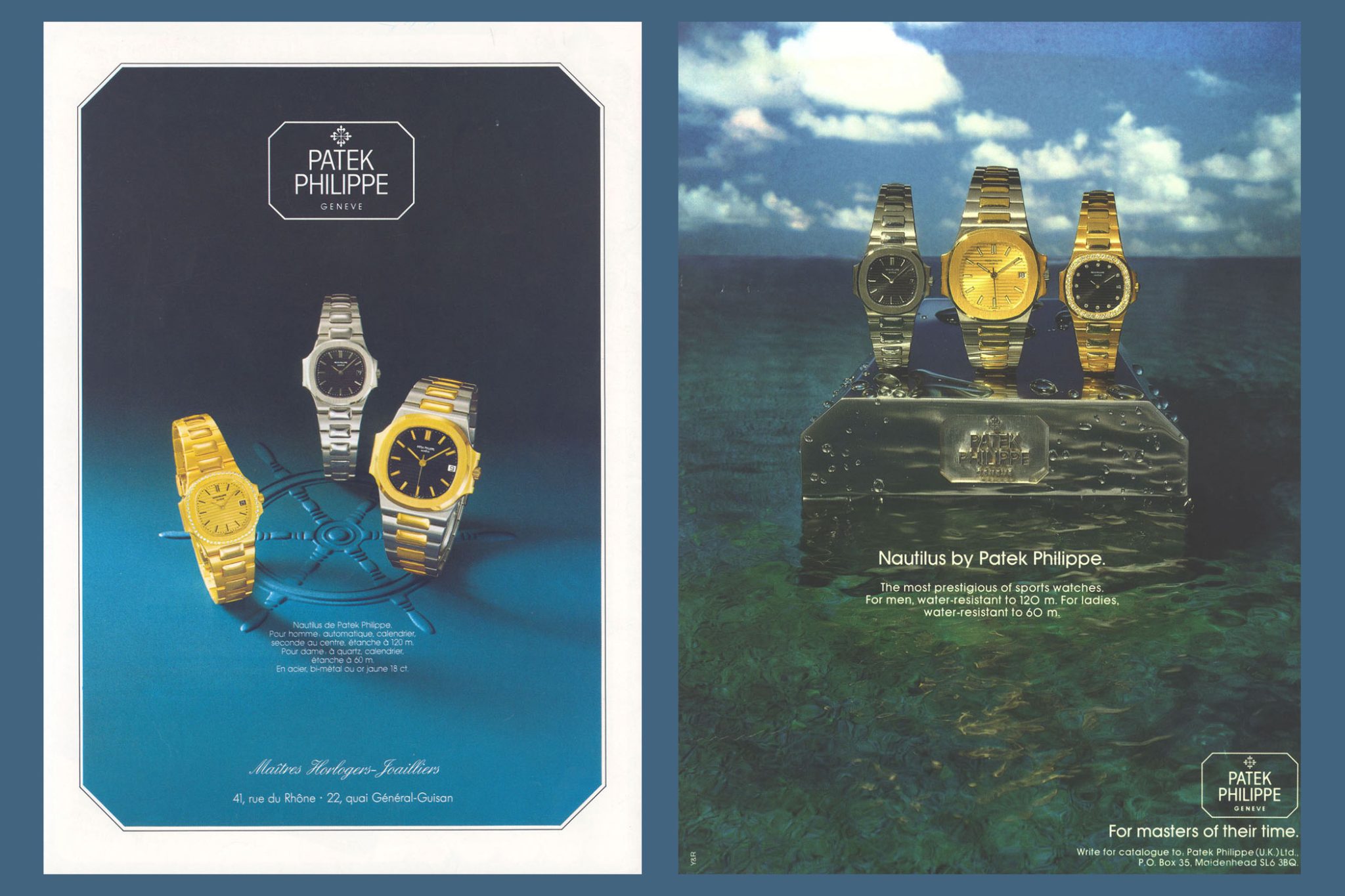
In the years that followed, Patek also supplied major industrial customers, public institutions, and transport companies with its hyper-accurate, quartz-controlled timepieces. Not only did Geneva Cointrin airport have a Patek Philippe quartz plant with so-called master and slave clocks, but even the colleagues of Rolex were provided with a version for the factory. Even the Holy See in Rome entrusted its new timekeeping system to the Stern family, following on from several popes in the 19th and 20th centuries who already owned Patek pocket watches. Patek’s master system controlled hundreds of electronic clocks in Vatican City and served as the basis for Radio Vatican’s time signal.
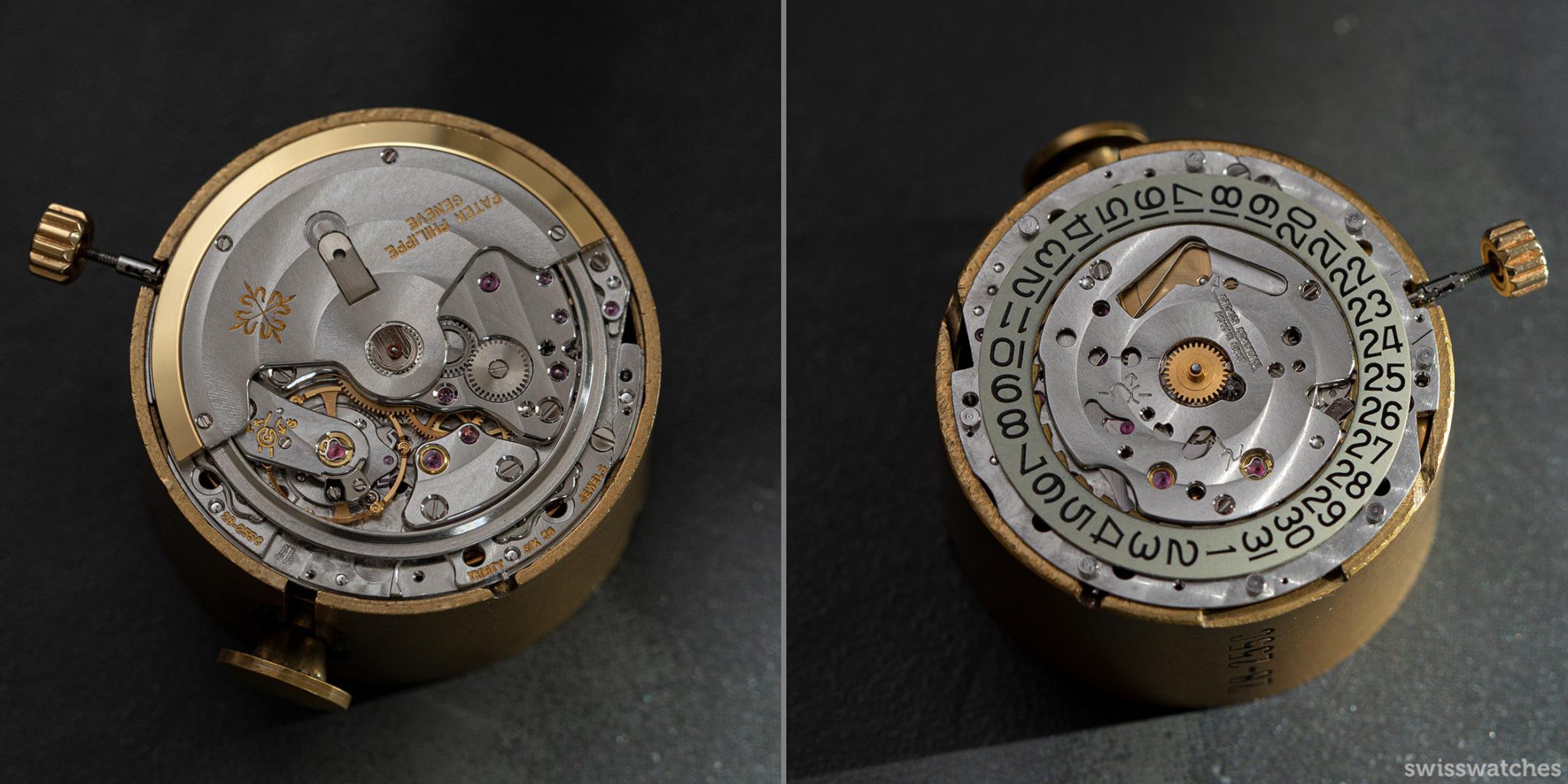
Patek Philippe Calibre 28-255C
Ultra-flat mechanical movements such as the LeCoultre one used in the first generation of the Nautilus, the 3700/1A, were rather uncommon at that time, and under high pressure, Patek started to develop its own flat automatic movements. The calibre 28-255C was based on the legendary Jaeger-LeCoultre calibre 920, which is still used today in classics like the Audemars Piguet Royal Oak “Jumbo” and the Vacheron Constantin Overseas Ultra Thin.
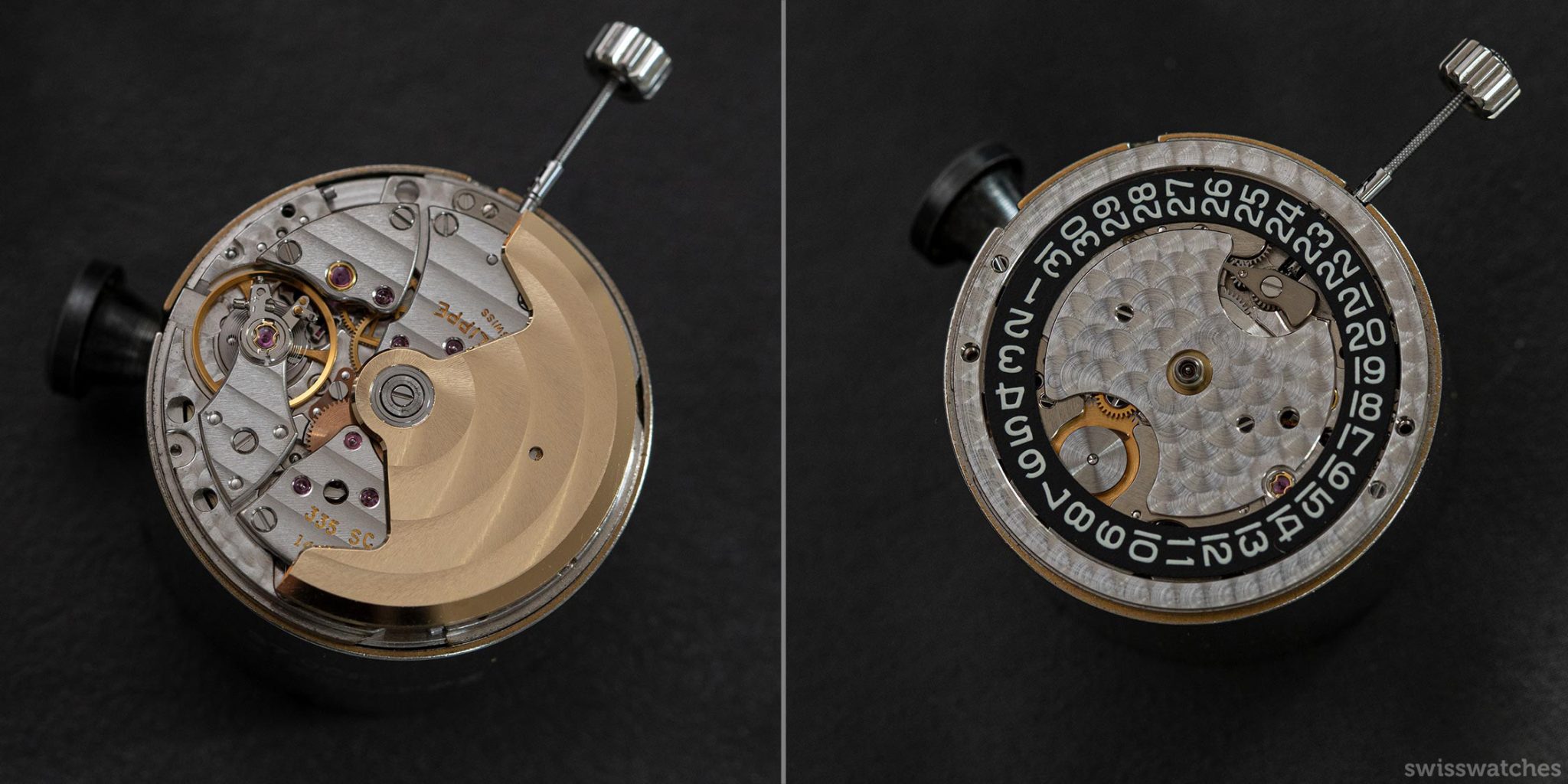
Patek Philippe Calibre 335 SC
As early as 1981, the company switched to the in-house calibre 335 SC for its midsize models. This watch also had a central second hand. When the successor to the original Nautilus, the Ref. 3800, was presented in the mid-1980s, the era of the “Jumbo” came to an end. The successive reference was significantly smaller, with a diameter of just 37.5 millimetres. It was not until 2004 that a new edition of the “big” Nautilus was launched in the form of the Ref. 3711, available exclusively in white gold alongside a black dial. The reference was accordingly the 3711/1G-001. Sources differ a bit here, but according to the site luxify.de, it was only manufactured for about two years, and this has also been confirmed by the German auction house Crott. The movement inside the 3711 was the calibre 315 SC, with central seconds and date.
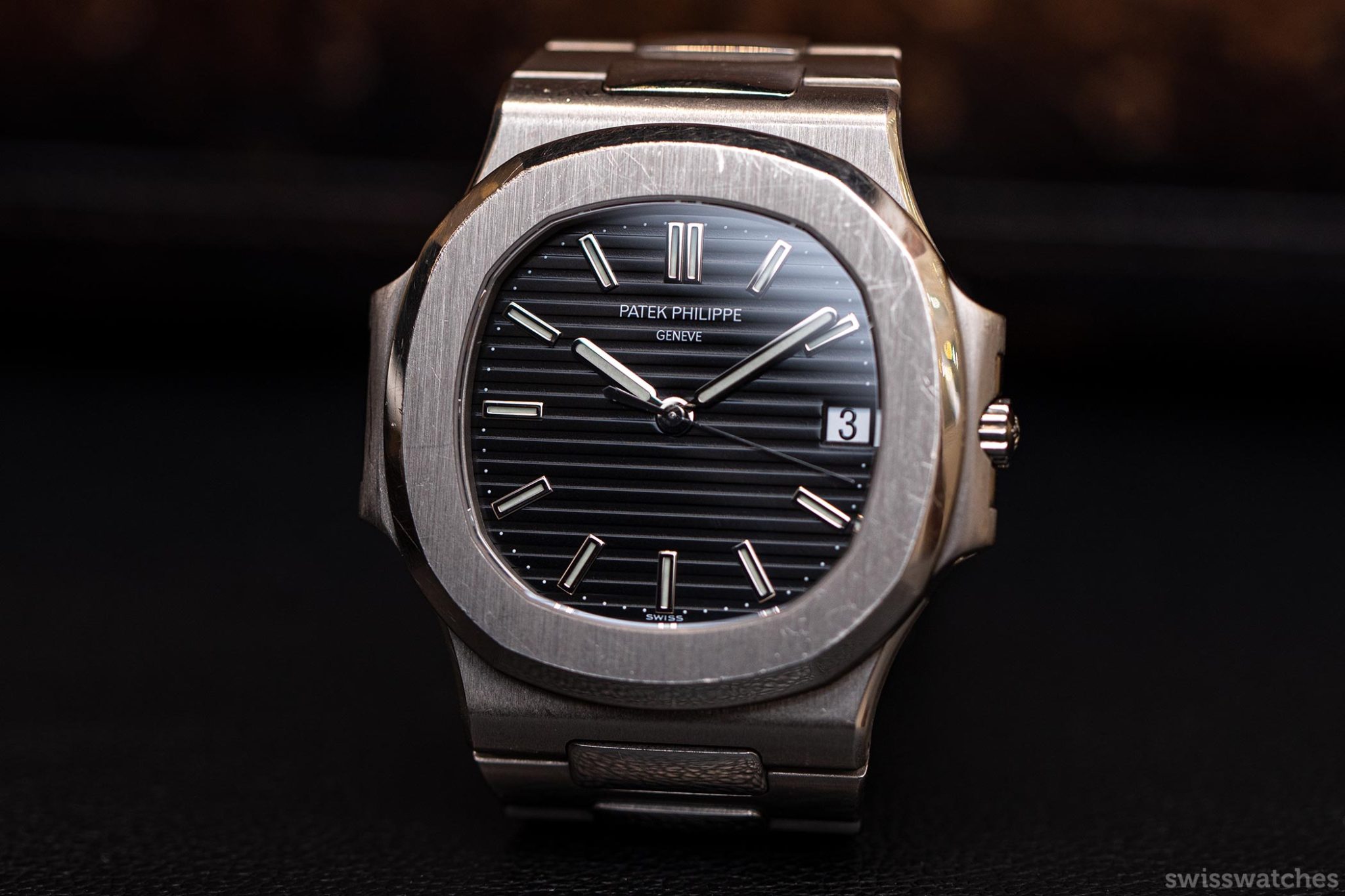
Patek Philippe Nautilus Referenz 3711/1G-001
But back to the early years: as the newly designated director of the company, Philippe Stern was not satisfied with using a foreign base calibre in his Nautilus. He therefore commissioned several groundbreaking movements as early as the mid-1970s, including the particularly complex calibre 240 with micro-rotor, which made its debut in 1977 in the Ellipse D’Or and found its way into the Nautilus case for the first time in 2005, shortly before its 30th birthday in 2006. This was in the Reference 3712, which was only produced for about one year, and of which, according to 100percentpassion.net, only about 900 pieces are said to exist. Let’s also not forget the extremely precise automatic calibre 324SC, which, with a rate deviation of -3 and +2 seconds per day, still outshines every Swiss chronometer (according to COSC standard) and has been powering the Nautilus since 2006 (and was only recently replaced).
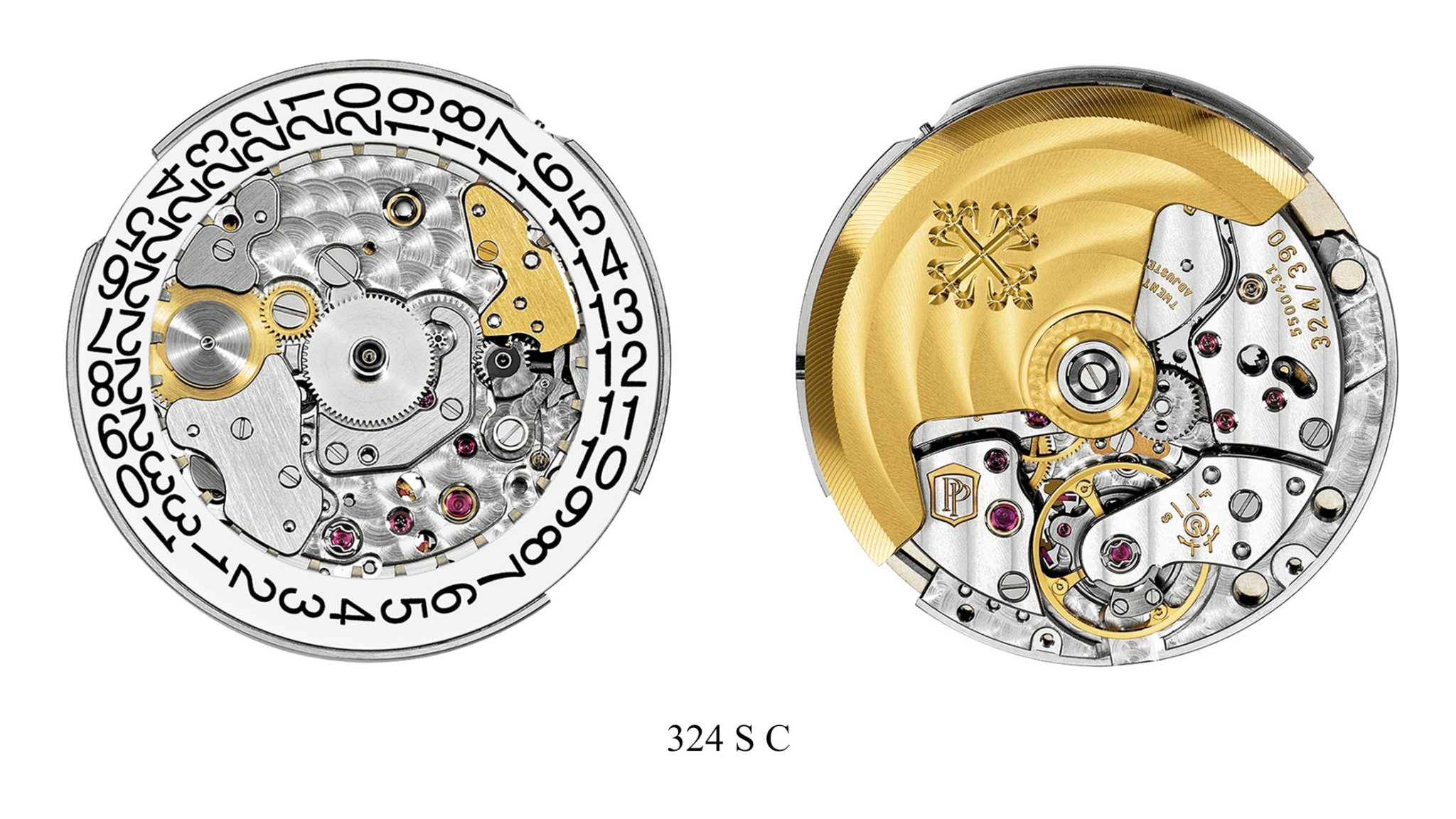
In 2009, Philippe Stern handed over the sceptre to his son Thierry, who then became company president. His wife at the time, Sandrine, works as the company’s chief designer. To ensure the continuation of outstanding quality in Patek’s watches for the future, Philippe Stern crowned his life’s work with an in-house, strict quality seal. The so-called Patek Phillipe seal is, of course, also carried by every Nautilus to this day. Also to this day, Patek still manufactures its own quartz movements (even if they are only used in ladies’ models), which are elaborately finished by hand.

Key Nautilus models
Let’s take a look at the individual models and their variants up to the present day. The original Nautilus model was introduced in 1976. The Reference 3700/1A with its 42-millimetre steel case and a movement that, as mentioned, came from LeCoultre, remained in the line-up until 1990. The model is recognisable by the missing seconds hand. Allegedly, only about 3,300 pieces were manufactured, according to acollectedman.com.
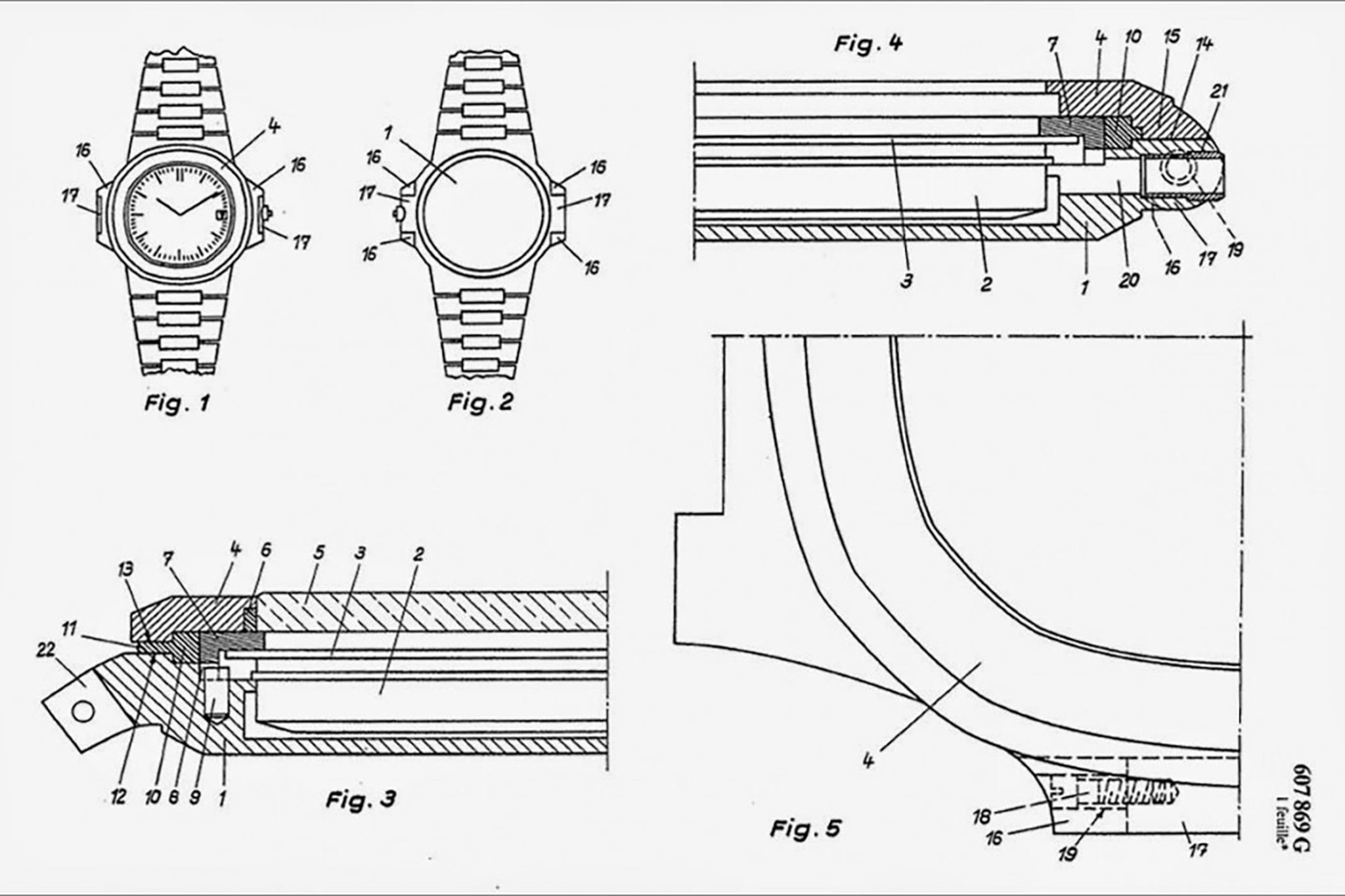
Patek Philippe Nautilus 3700 patent application
For Philippe Stern, it was clear from the start that the Nautilus should retain a mechanical movement – especially since the watch was quite large. So, “a small quartz movement would not have been a very satisfactory solution from a horological point of view.” Stern did, however, install a quartz movement in the first Nautilus ladies’ watch. He added for an article in Patek’s magazine, “It was clear to me that Patek Philippe should continue to focus on mechanical movements in the future; in the case of the Nautilus, I wouldn’t have known what we could have used to justify a quartz movement. Such a large steel watch was an exception for Patek at that time, and I thought a quartz movement would destroy all the appeal that was atypical for Patek.”
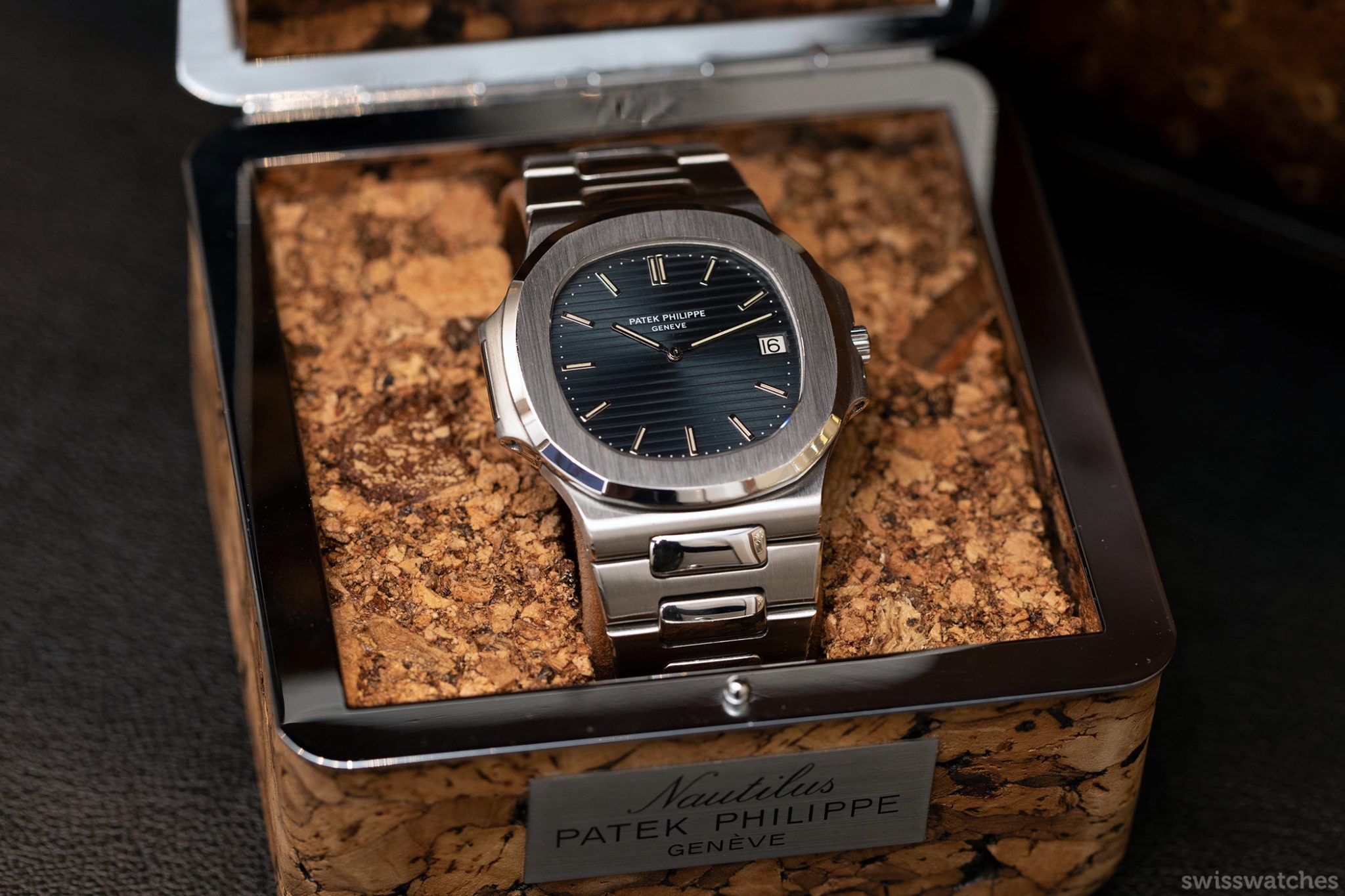
The first Patek Philippe Nautilus Ref. 3700/1A in a 42mm stainless steel case with the blue dial.
Success for the ladies’ version
In 1980, this ladies’ version of the Nautilus was presented. The following year, in 1981, the Nautilus was launched in a midsize size that is very exciting for collectors today. This model measures only 37.5 millimetres in diameter. Introduced in 1982, the Reference 3800 is available in a much wider range of case, dial, and hand configurations than the other two models and is even initially more expensive than the famous Reference 3700. This may be due to the fact that the Reference 3800/1A is now powered for the first time by the in-house developed calibre 335 SC. This line, which now forms the new heart of the Nautilus collection, can be recognised by the new central second hand. It makes the watch interesting for men and collectors with narrower wrists.
Experts speculate about the reasons for this important step: As acollectedman.com reports in a very readable and detailed special guide to this model, the main aim was to sell “the reference to younger generations – as a sports and leisure watch”.
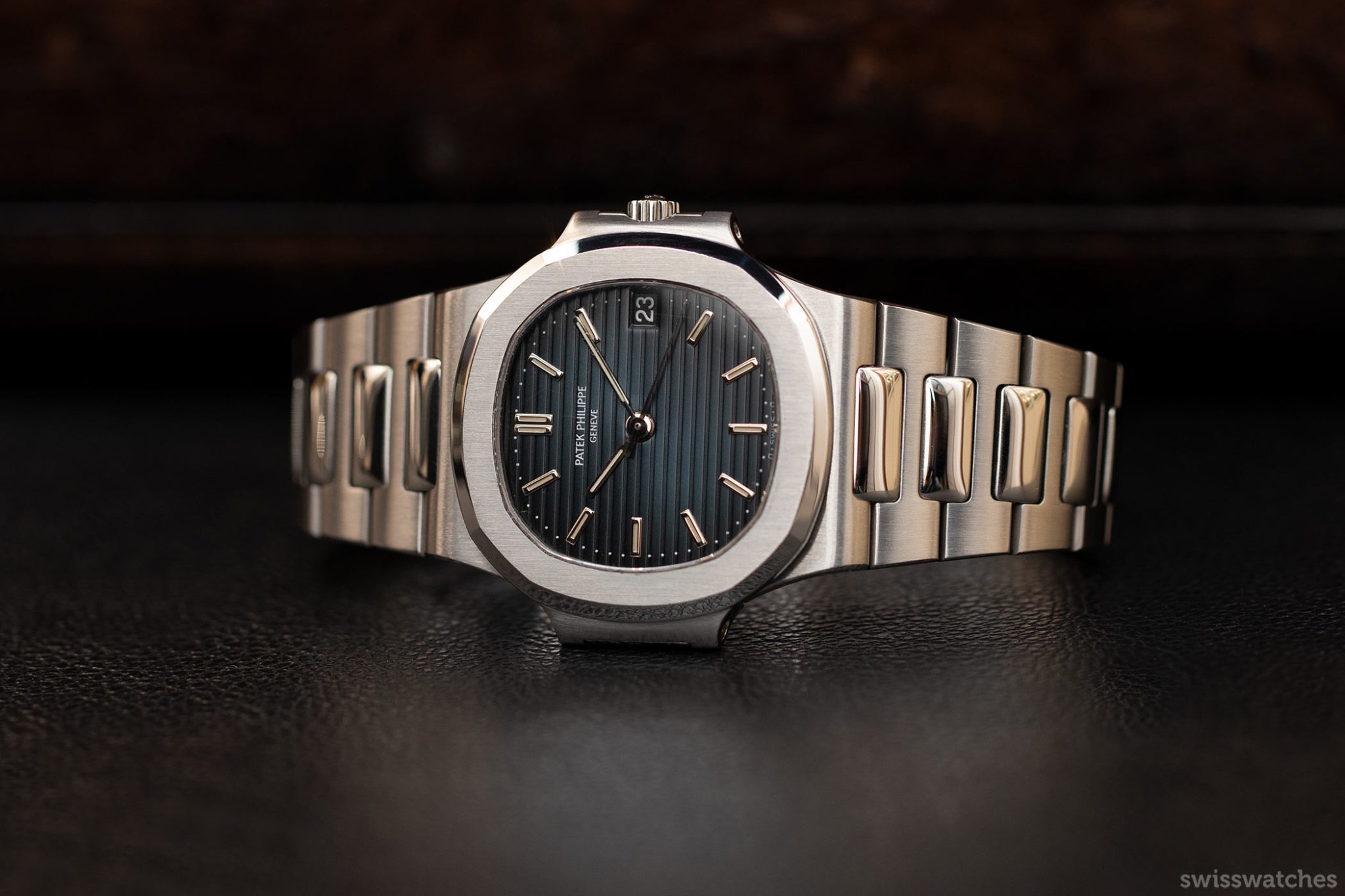
Ref. 3800/1A
The same year, a bicolour model was introduced for the first time. In the Reference 3900/1JA, which only available in the midsize size, parts of the bracelet, dial and two-part case were made of 18-carat gold. In 1996, twenty years after the classic “Jumbo” was introduced, models with Roman numerals were offered for the first time. The Reference 3800/1JA was available in bicolour, and the Reference 5060/SJ was the first time the Nautilus was presented with a leather strap. It paved the way for the Aquanaut line launched one year later with its first steel model, the Reference 5060A.[5]
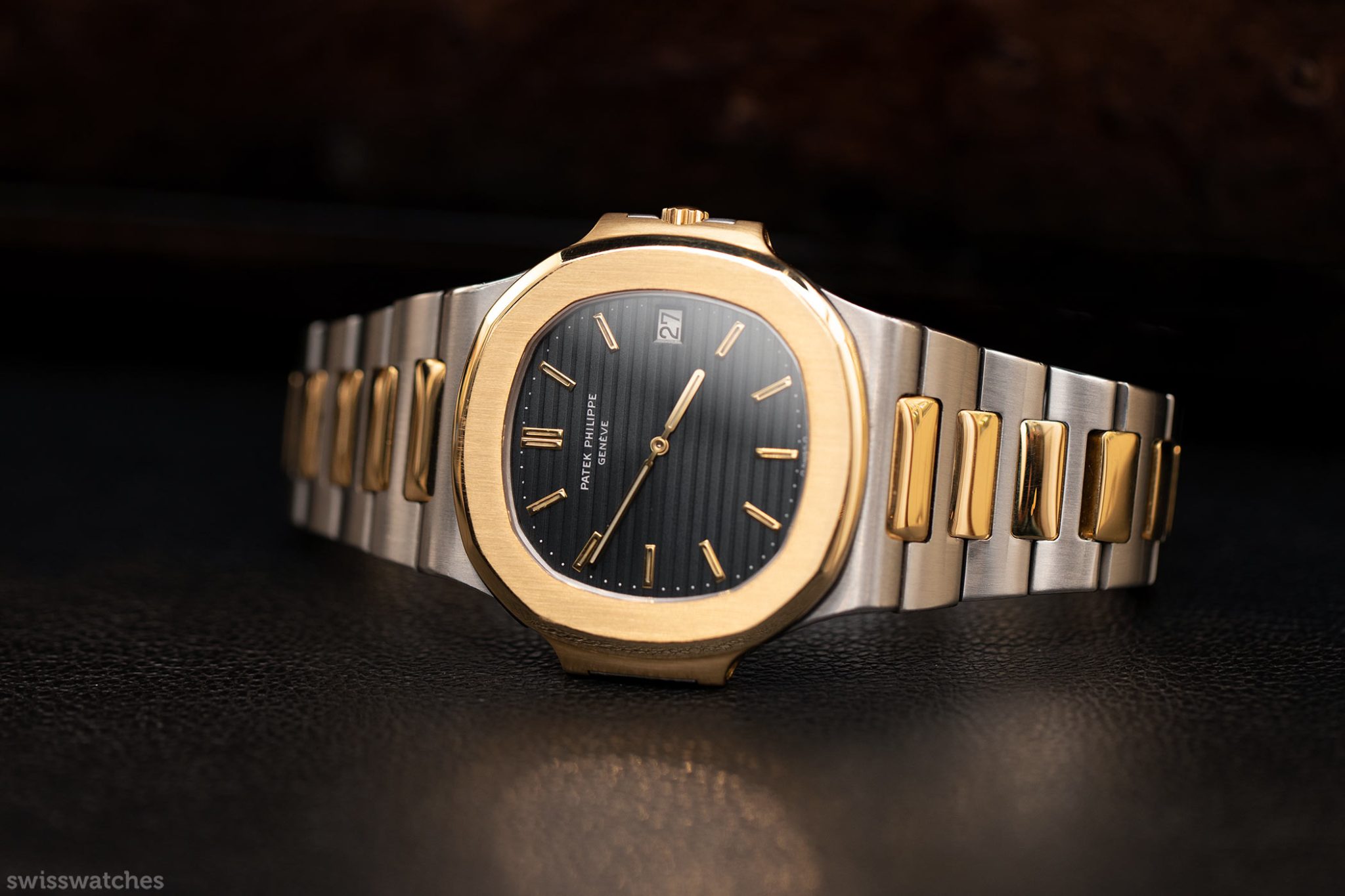
Ref. 3700/1JA

Ref. 3800/1JA & 3800/1A & 3800-1
In 1998, the watch was offered alongside a complication for the first time, starting with a power reserve indicator in the Reference 3710/1A. This watch with Roman numerals also has the case diameter of 40 millimetres (which remains common today) for the first time. In 2004, a model in a white-gold case appeared for the first time, the Reference 3711/1G. The following year, 2005, the most complicated model at the time, the Reference 3712/1A, was introduced, featuring a power reserve indicator, moonphase indication and small seconds at 4 o’clock.
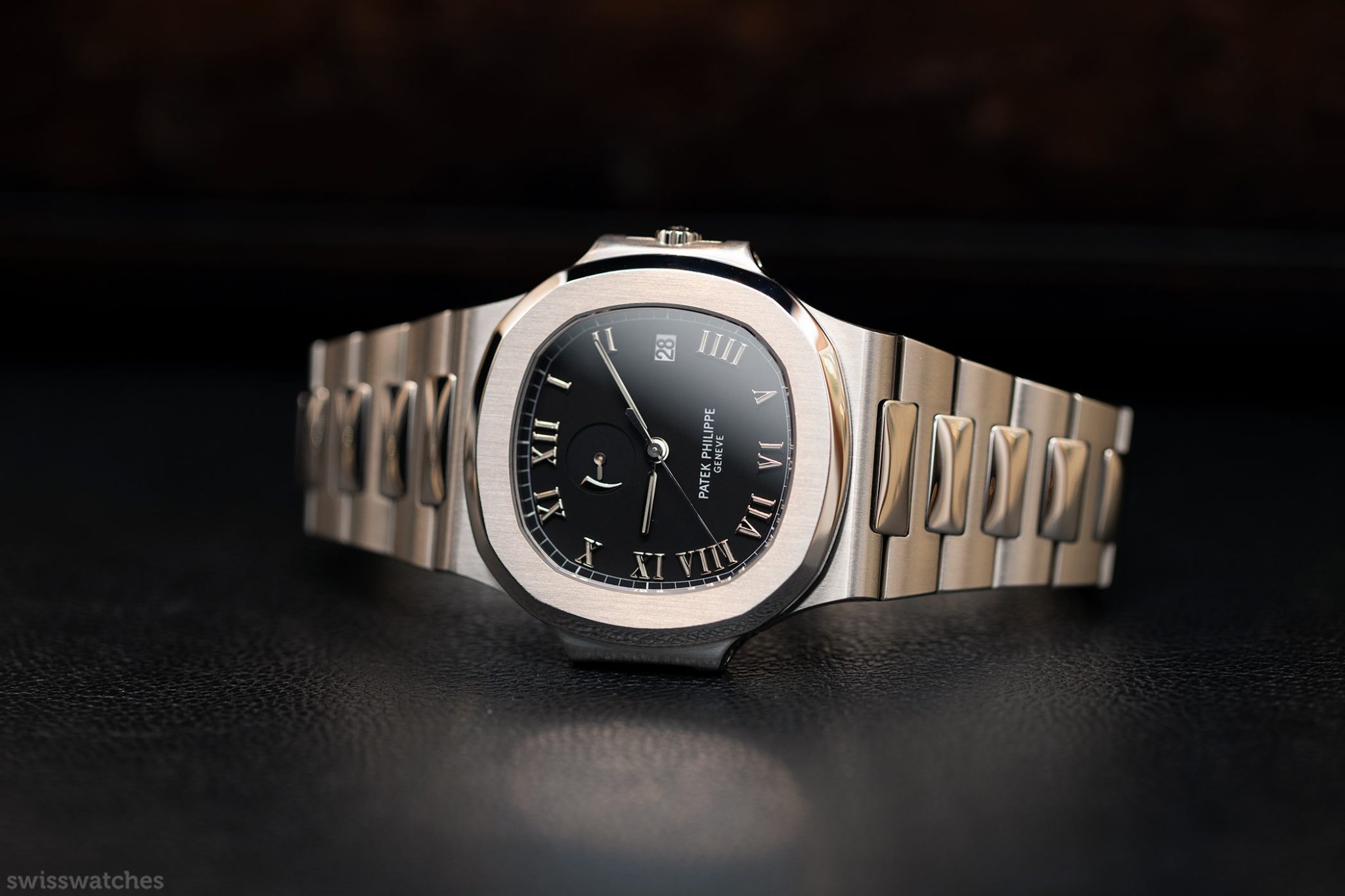
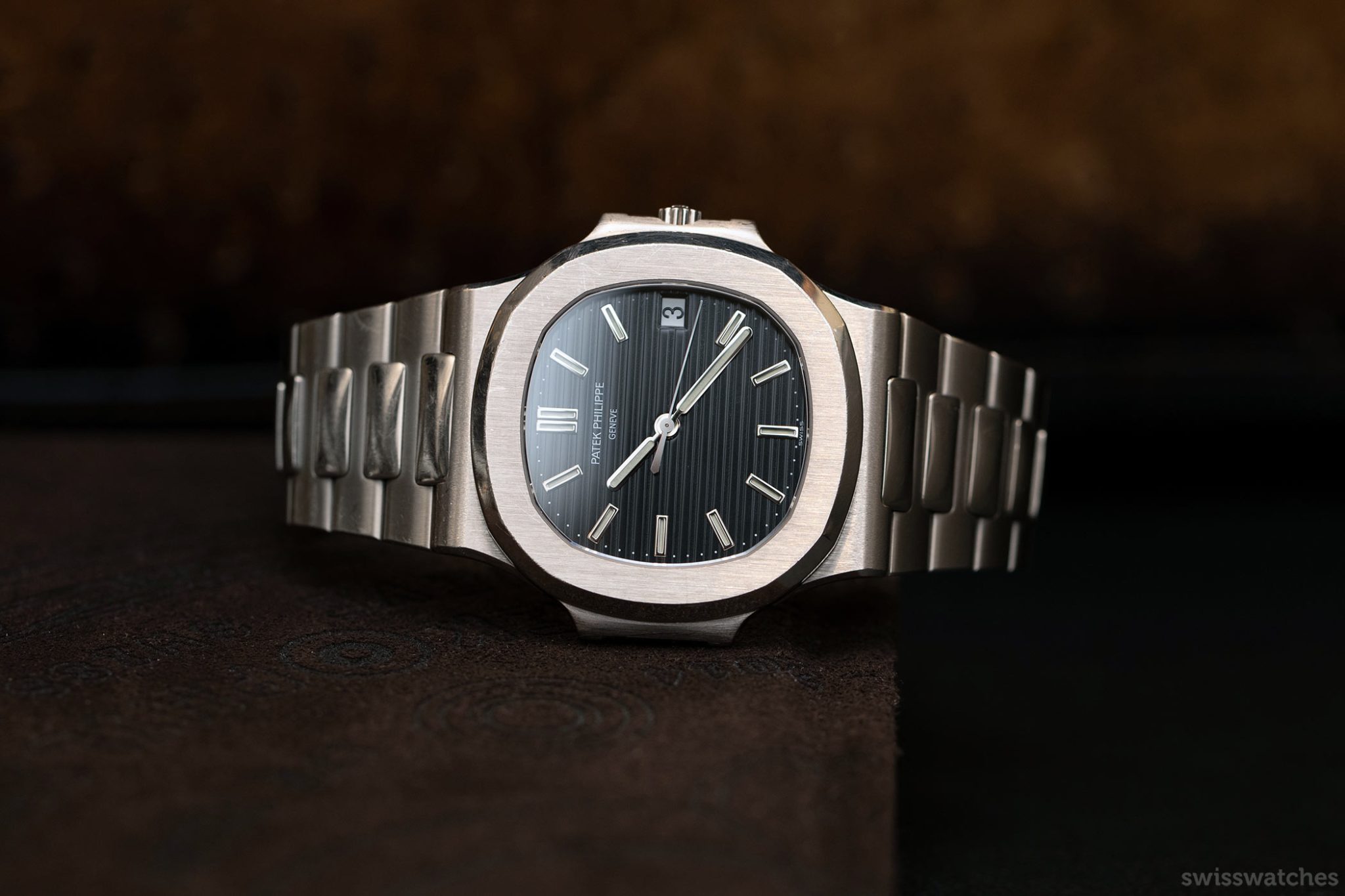
Ref. 3711/1G & 3710/1A
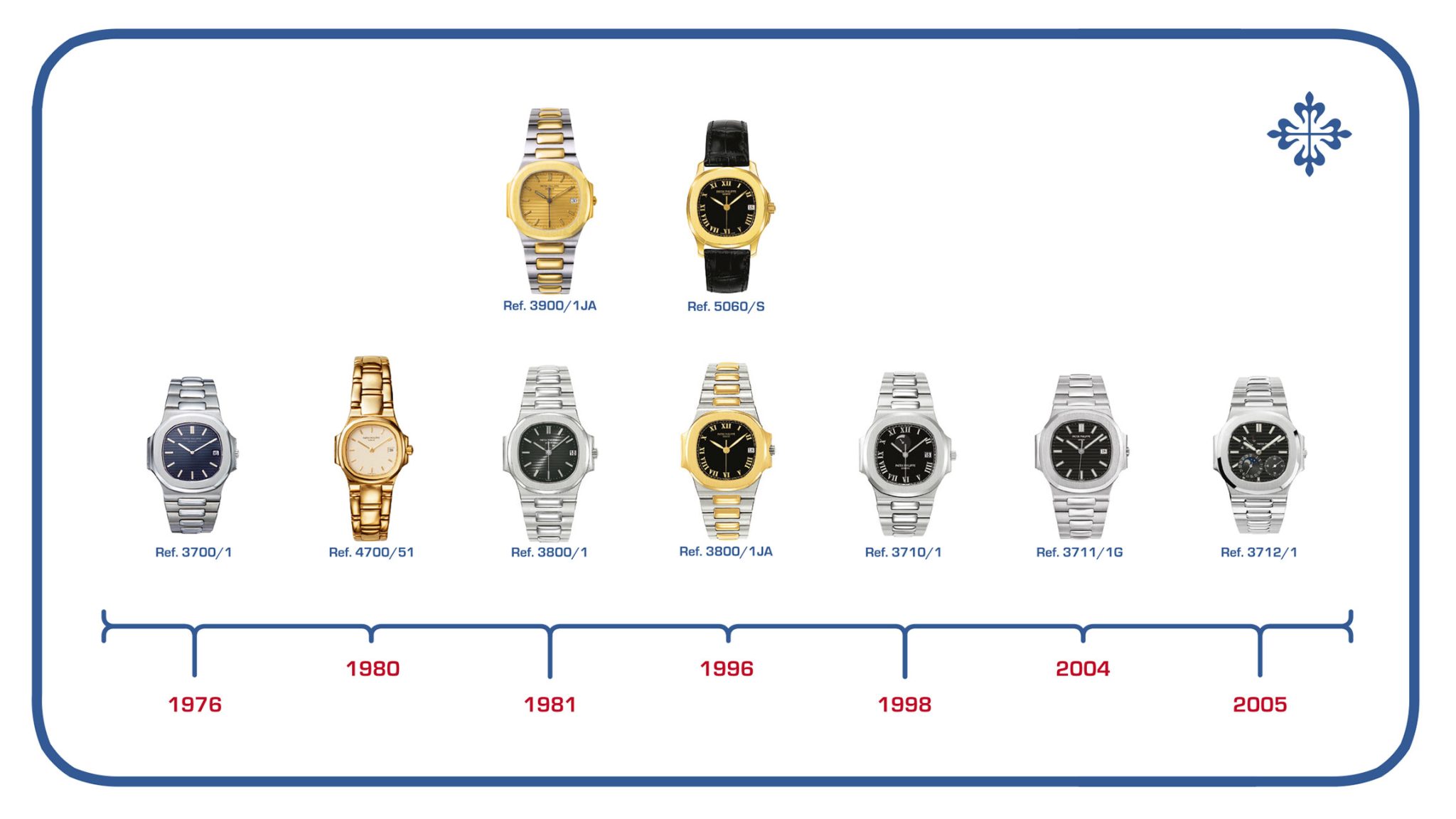
The Nautilus becomes complicated – and even sportier
For the 30th anniversary in 2006, as briefly mentioned above, several important changes were made to the Nautilus. Externally, the most noticeable change was the somewhat sharper-edged polished bezel. This marks out the watch that is the subject of the most hype today: the now three-piece case is equipped with a sapphire crystal caseback. What remains is the porthole mechanism for tightening the bezel. Through the sapphire crystal caseback, you can observe the most significant change to the watch at work; for the first time, the Reference 5711/1A now features the extremely accurate movement with central rotor, calibre 324 SC, which is manufactured fully in-house. In the medium size version, by the way, the classic two-piece construction with monocoque and bezel is retained, in a nod to the original.
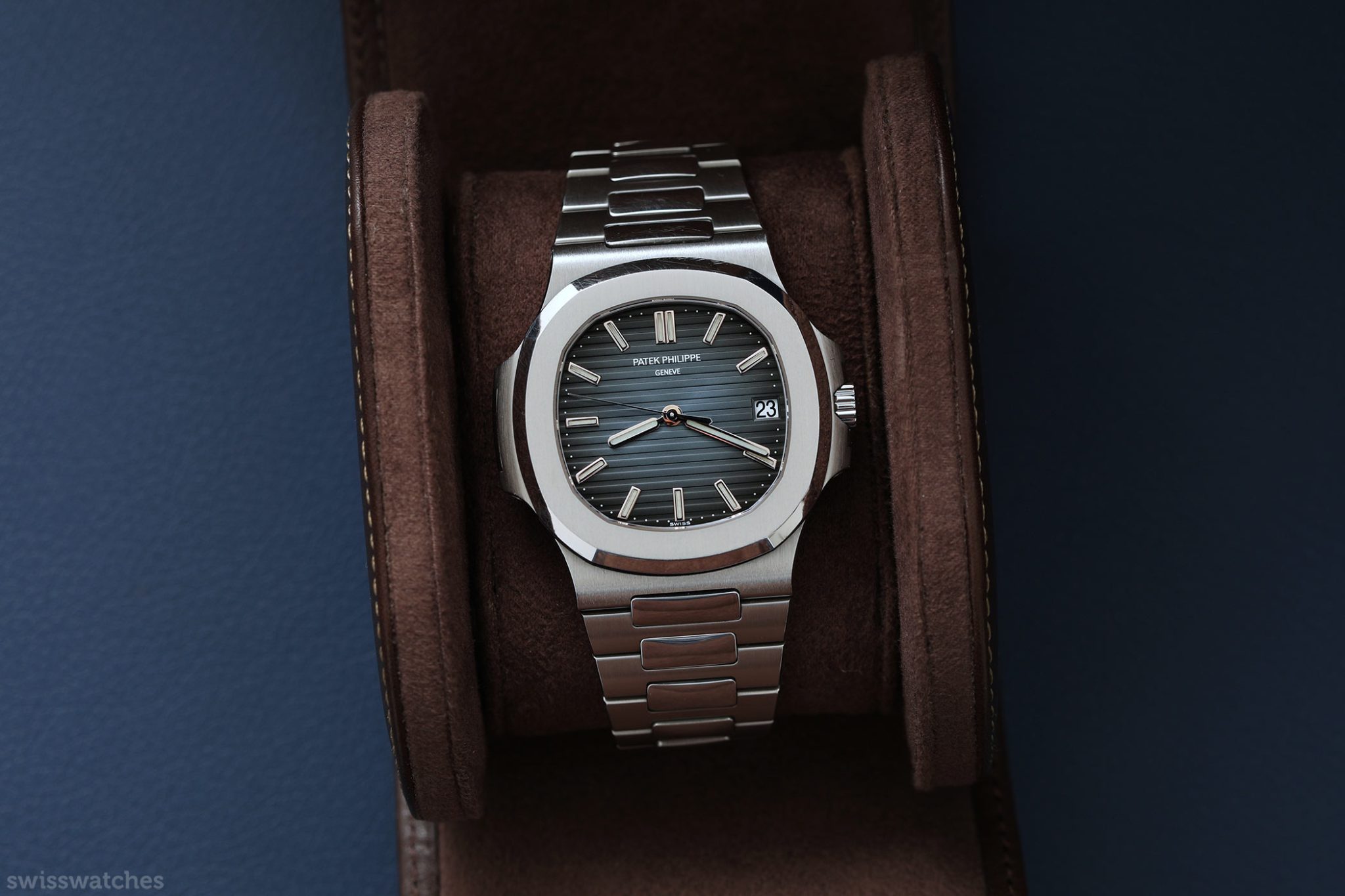
Ref. 5711/1A-010
The Reference 5711/1A‘s life span came to an end in 2021 after 15 years, shortly before its 50th birthday. But the even bigger sensation was actually the presentation of the first chronograph in the Nautilus family in 2006, with the Reference 5980/1A. The moonphase model (Ref. 5712/1A) and midsize model (5800/1A) also underwent changes in terms of both case construction and movements. The first rose-gold case Nautilus also made its debut with the Reference 5712R.
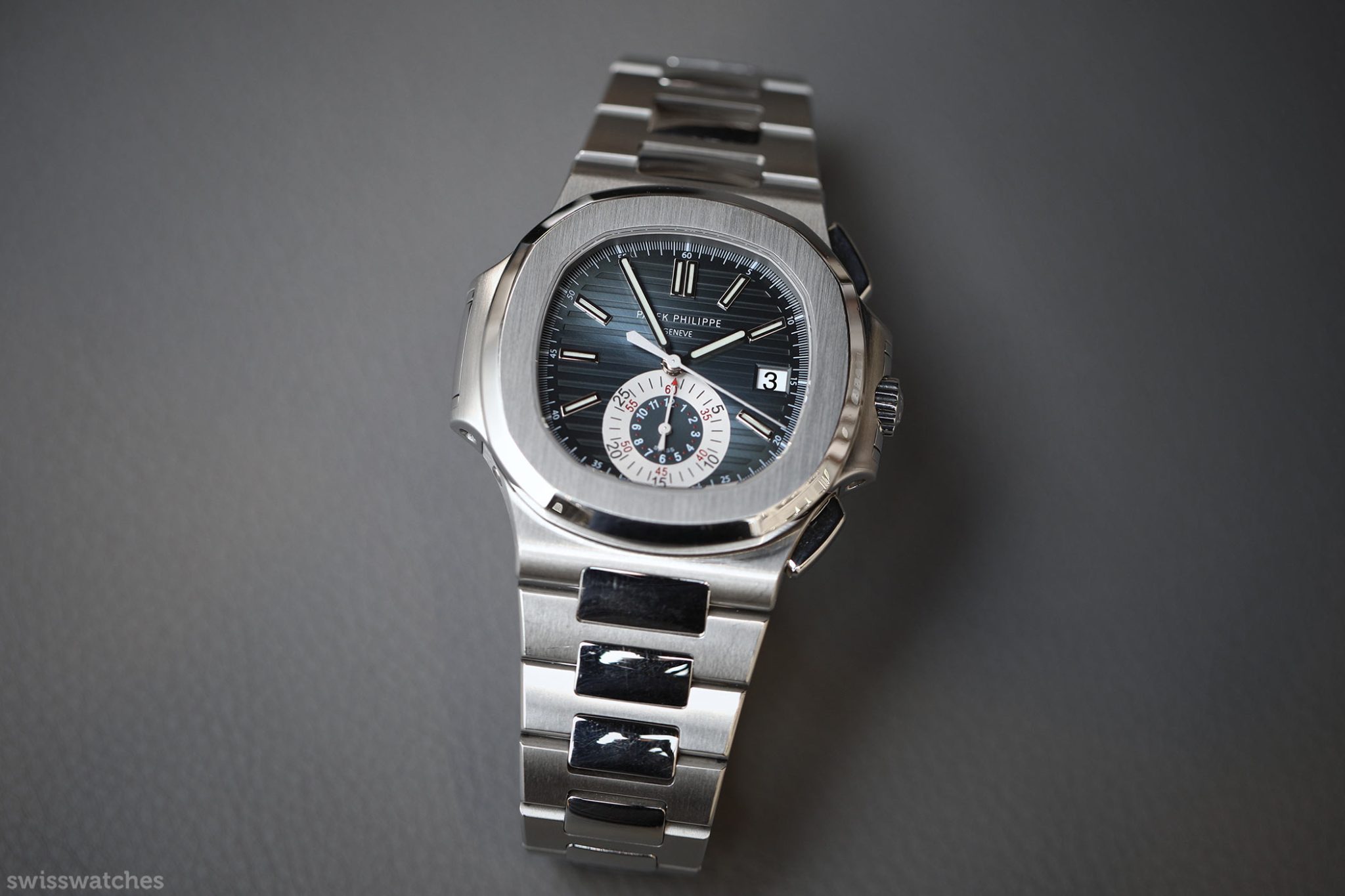
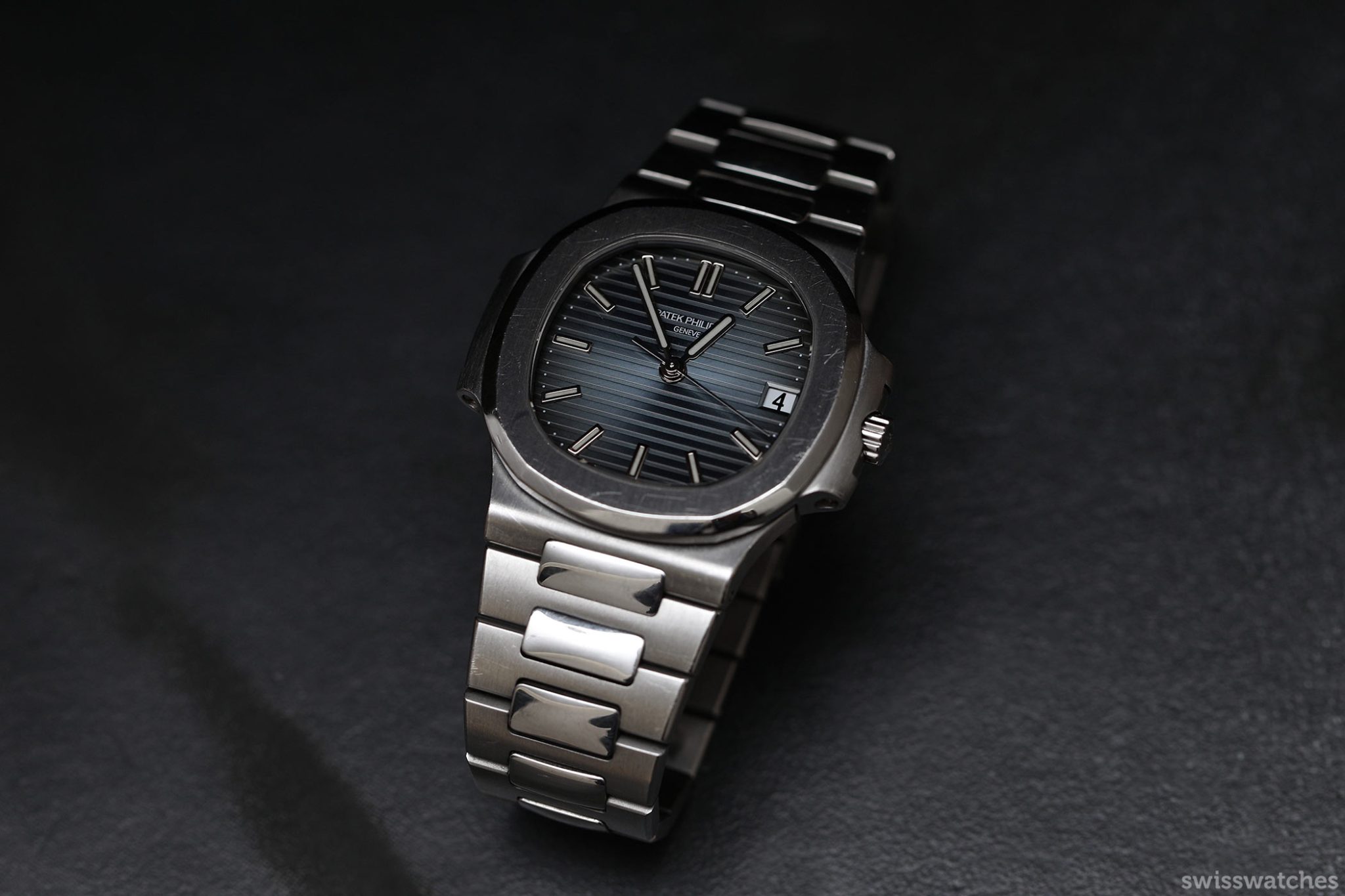
Ref. 5980/1A-001 & 5800/1A-001
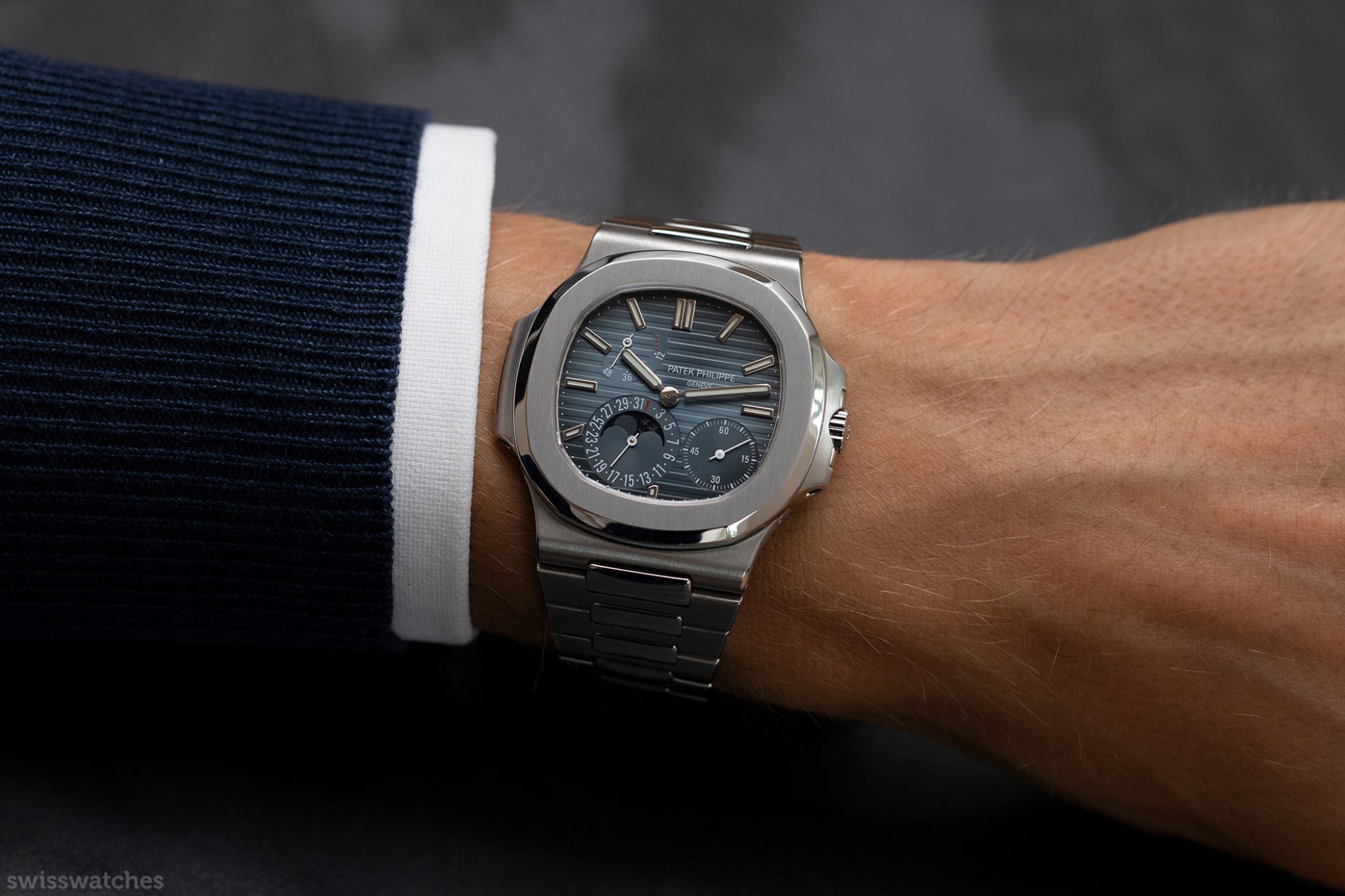
Ref. 5712/1A-001
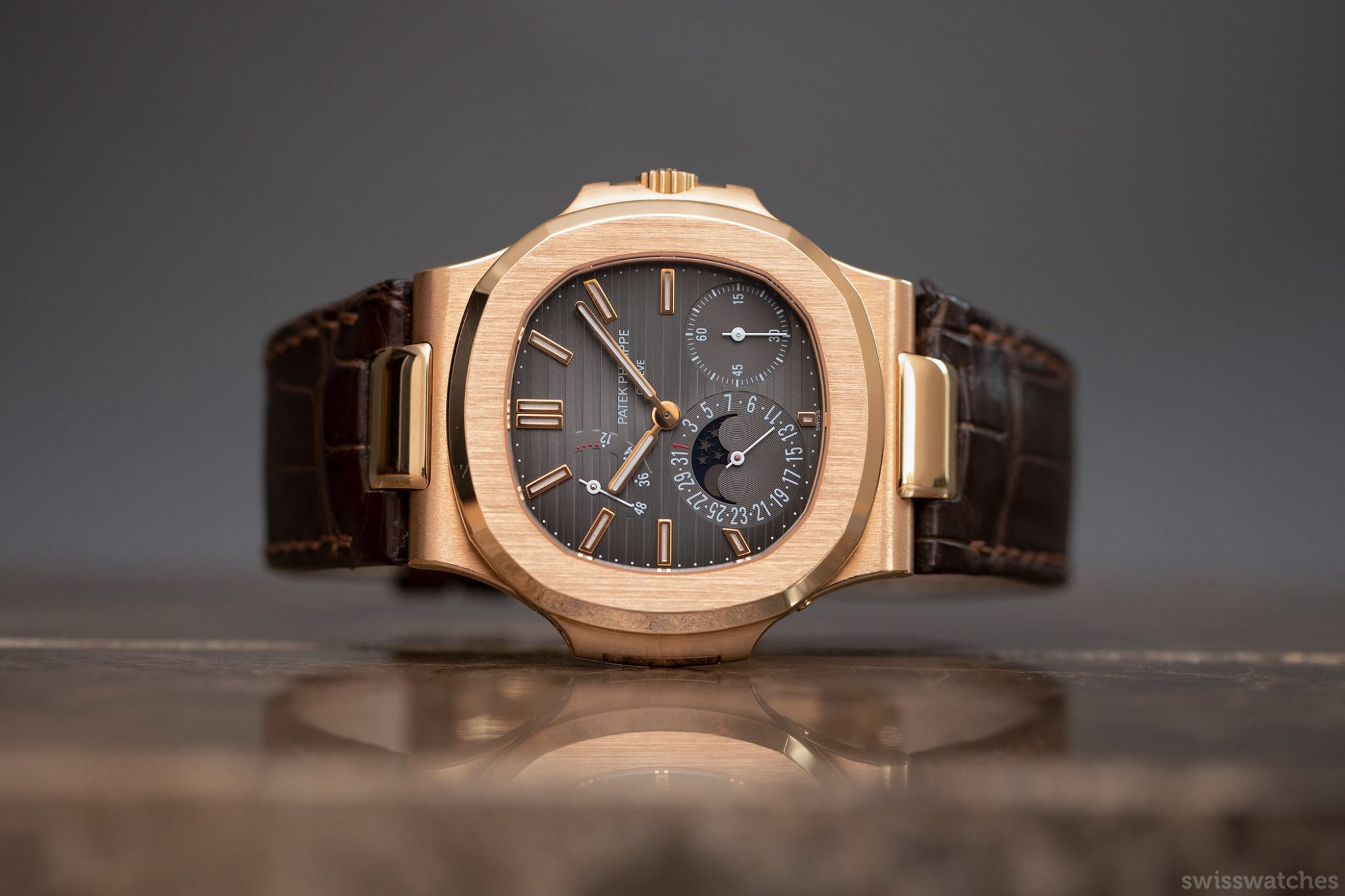
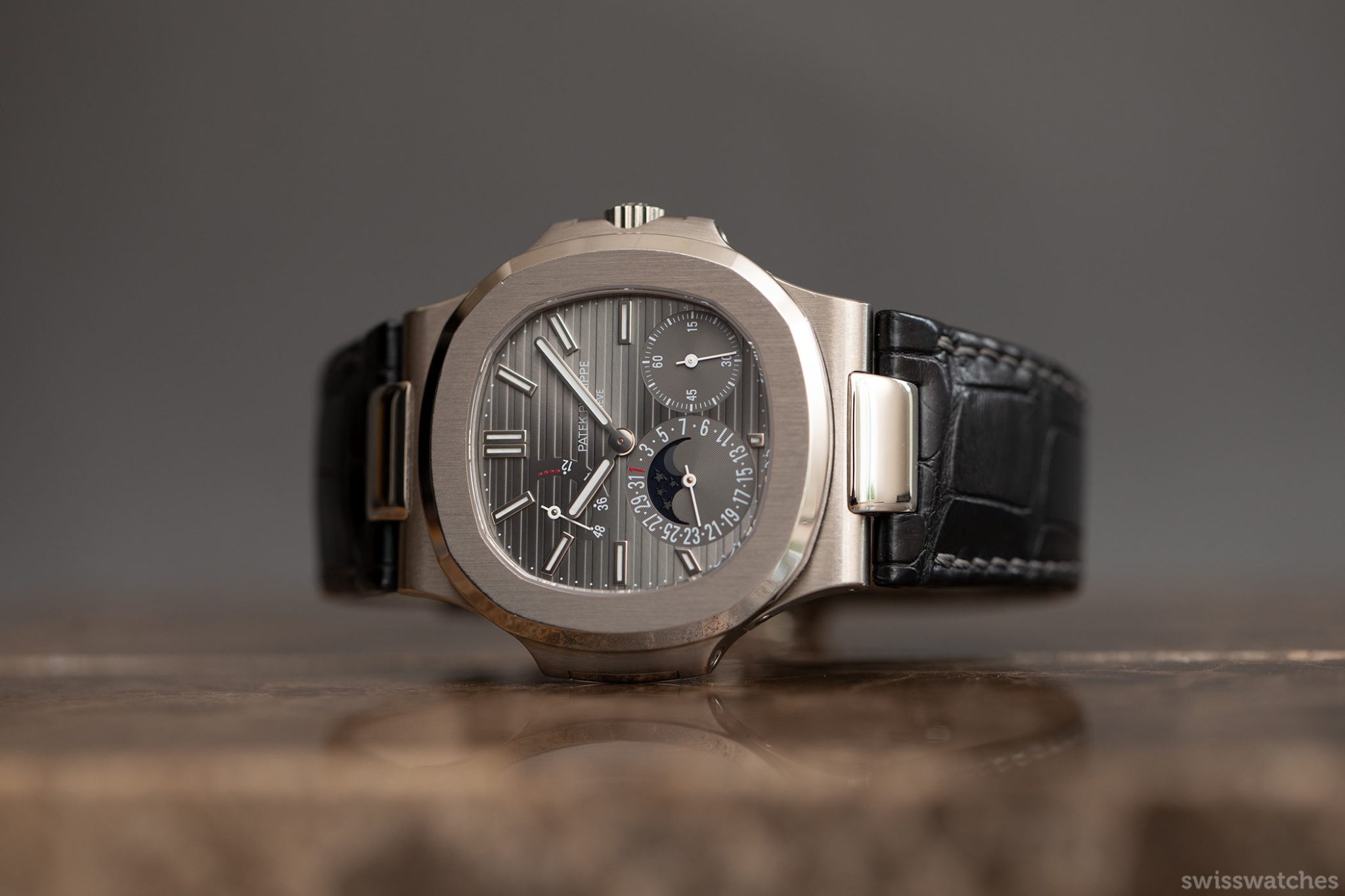
Ref. 5712R-001 & Ref. 5712G-001
Another interesting innovation was added to the Nautilus family upon its anniversary, and herein lies perhaps an insider’s tip for collectors. For the first time, a Nautilus appeared with a white dial, celebrating its premiere in the form of the 5980/1A-19 chronograph. Only three steel variations in total received this look until today; the three-hand watch in the year after and the annual calendar with moonphase six years later. All models have since been discontinued and were only available until 2014, 2020 and 2019 respectively. And for the experts out there: yes, there was also a gold version with a white dial, but with a strap – the Reference 5711J-001.
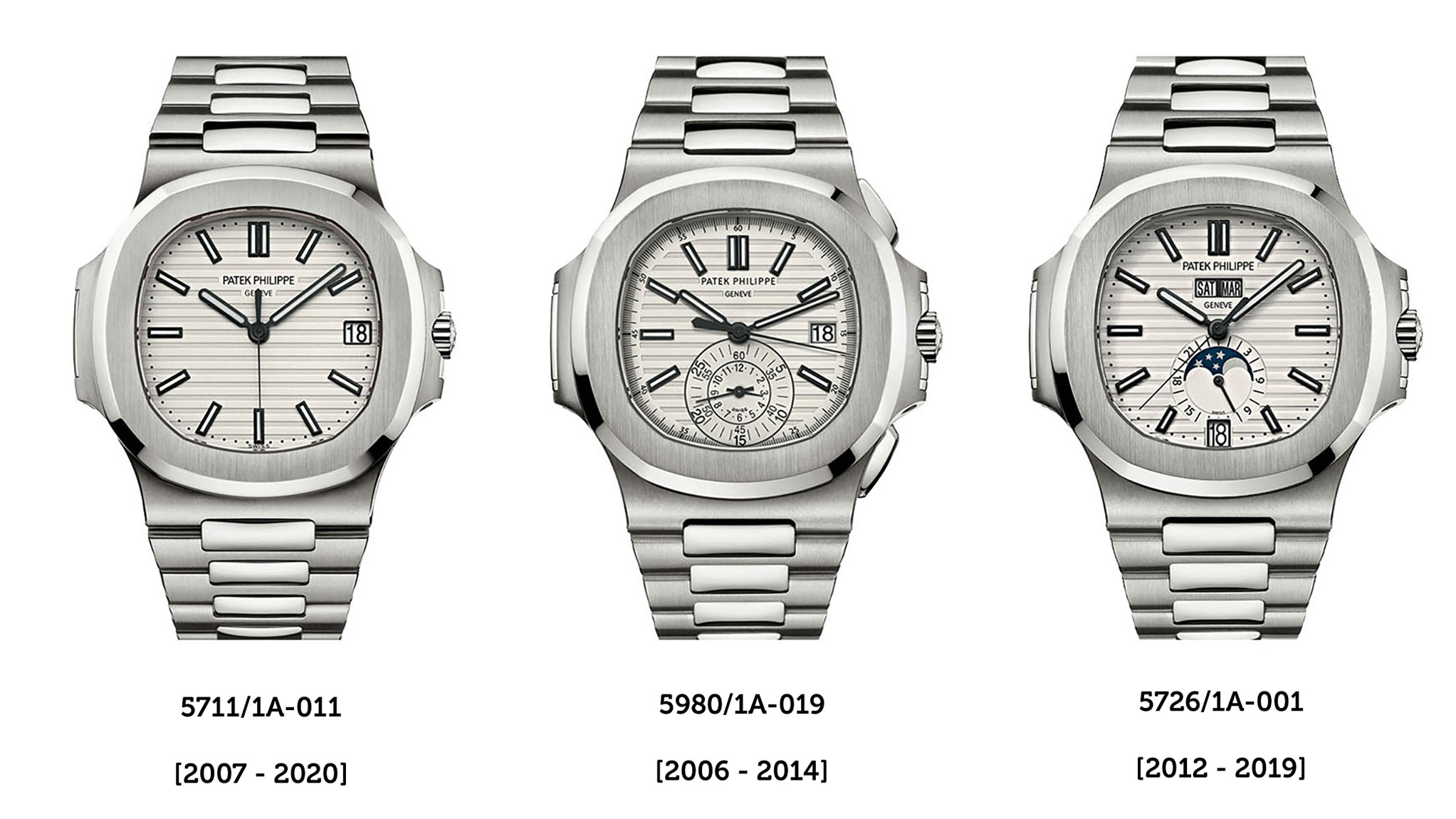
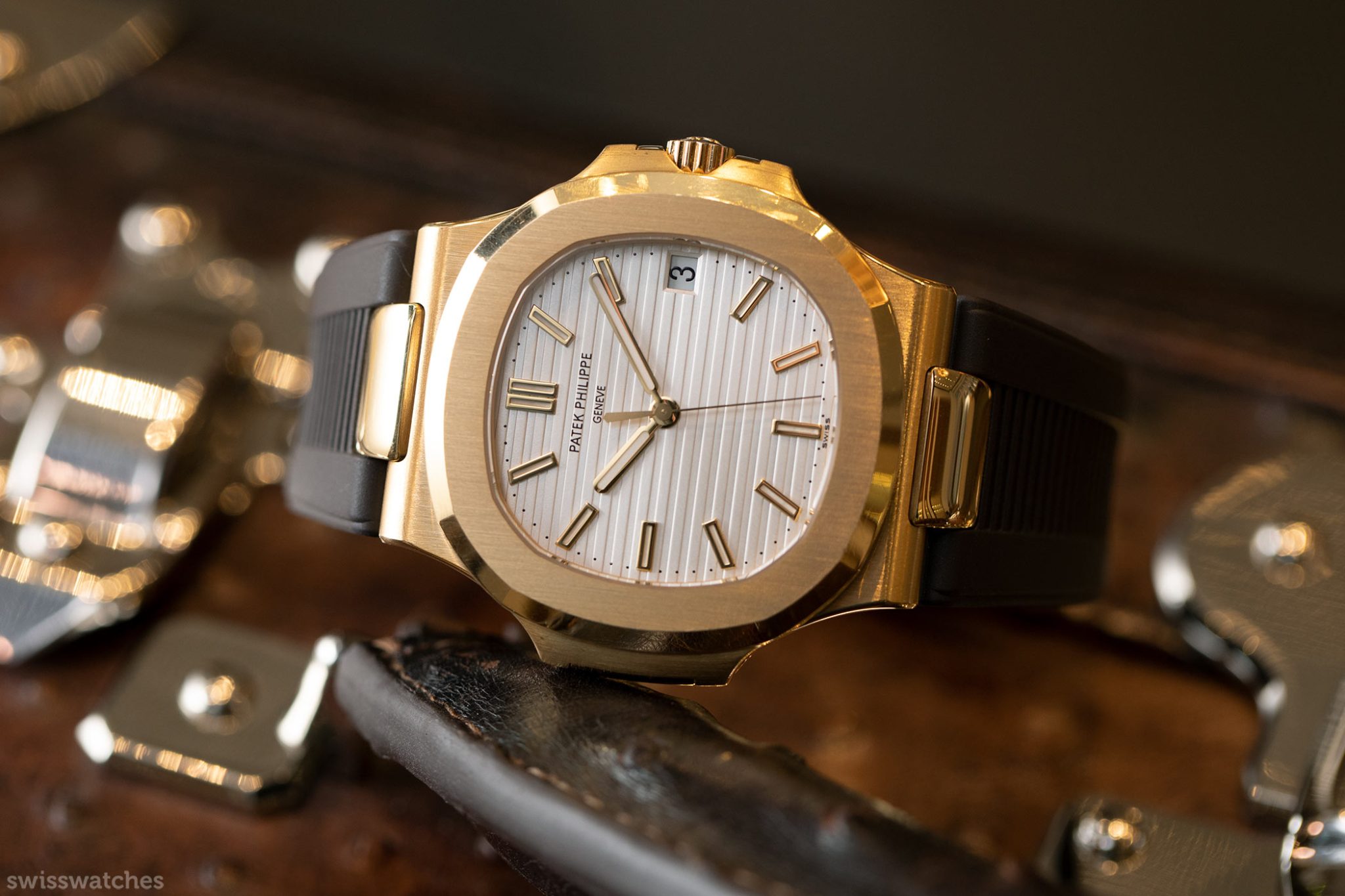
Ref. 5711J-001
2009: Gérald Genta resurfaces on the Nautilus scene
Gérald Genta was involved in the design of the new 2009 ladies’ model, which now had an increased case diameter of 32 millimetres. For the first time, diamonds appeared on a Nautilus, namely on the bezel. In 2010, an annual calendar version was introduced with a leather strap (Reference 5726A), followed two years later by the practical function on a version with a steel bracelet (Reference 5726/1A).
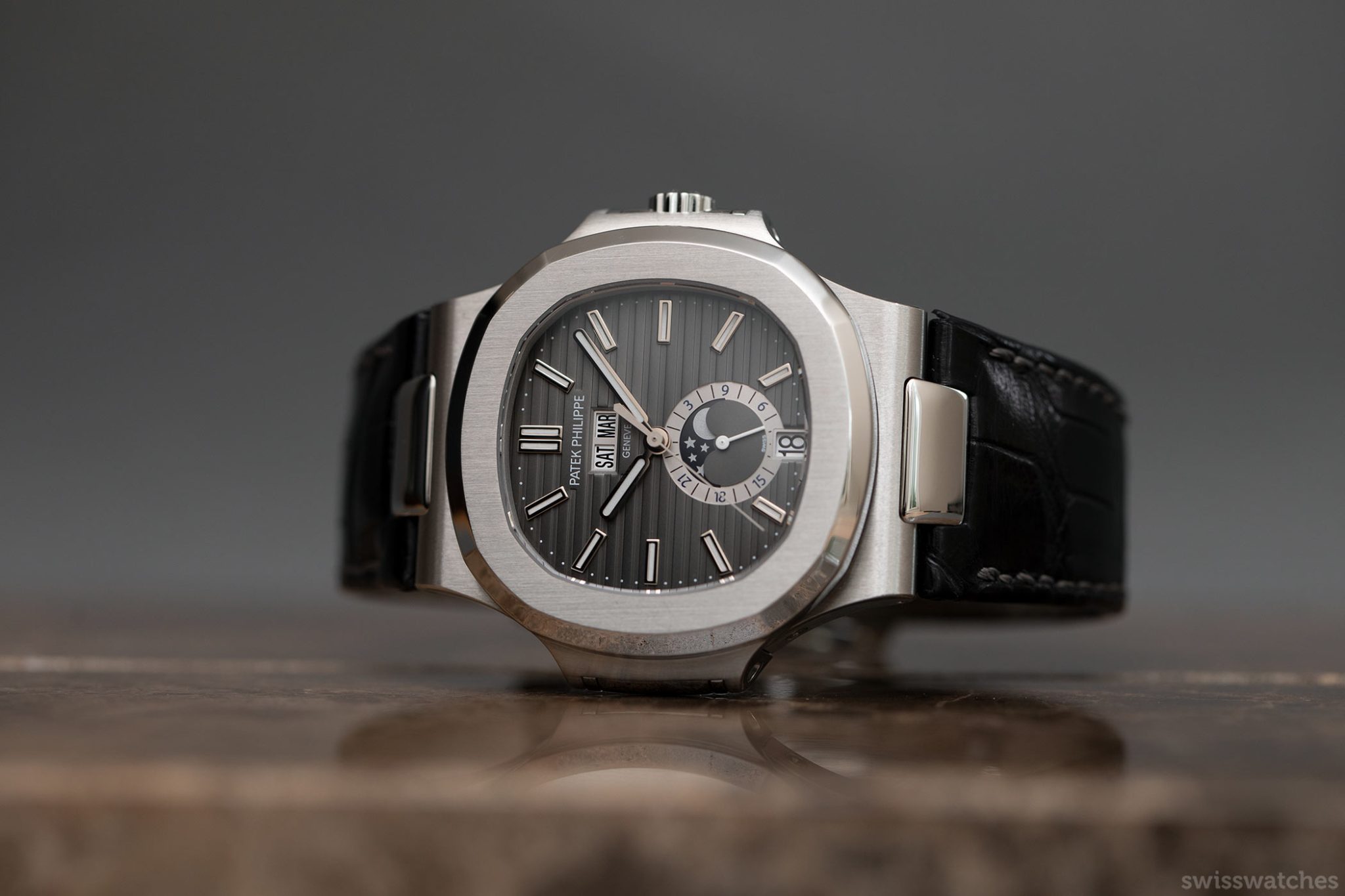
Ref. 5726A-001
For the chronographs, the situation was exactly the opposite of that for the annual calendar watches. The leather strap version followed in 2010 (with the Reference 5980R-001), four years after the steel bracelet chrono was unveiled. In 2013, the ladies’ line was revised to include new leather straps, and at the same time, the dials were given a wave-shaped pattern.

Ref. 5980R-001
That year also saw the appearance of two interesting design novelties in chronographs. After the first bicolour Nautilus in 1981, there followed Patek’s first complicated bicolour watch, the chronograph Reference 5980/1AR-001, as well as the first complicated solid gold version, the chronograph Reference 5980/1R-001. Both models are still available from Patek today.
Ref. 5980/1AR-001 & 5980/1R-001
In 2014, two popular functions, a travel-time function and a chronograph, appeared together in a Nautilus for the first time. This marked a completely new combination in the manufacture’s portfolio. The model’s two pushers for advancing and resetting the local time in one-hour increments were so elegantly integrated into the case that the typical contours of the porthole design managed to be retained. The Reference 5990/1A-001 “Travel Time” remained the most complicated Nautilus up until the introduction of the perpetual calendar, which caused a sensation with its unique time zone mechanism plus day and night display. Furthermore, the watch was an elaborate flyback chronograph. Finally, the first ladies’ model with an in-house automatic movement, without diamonds and in steel, followed in 2015, and also deserves a mention.
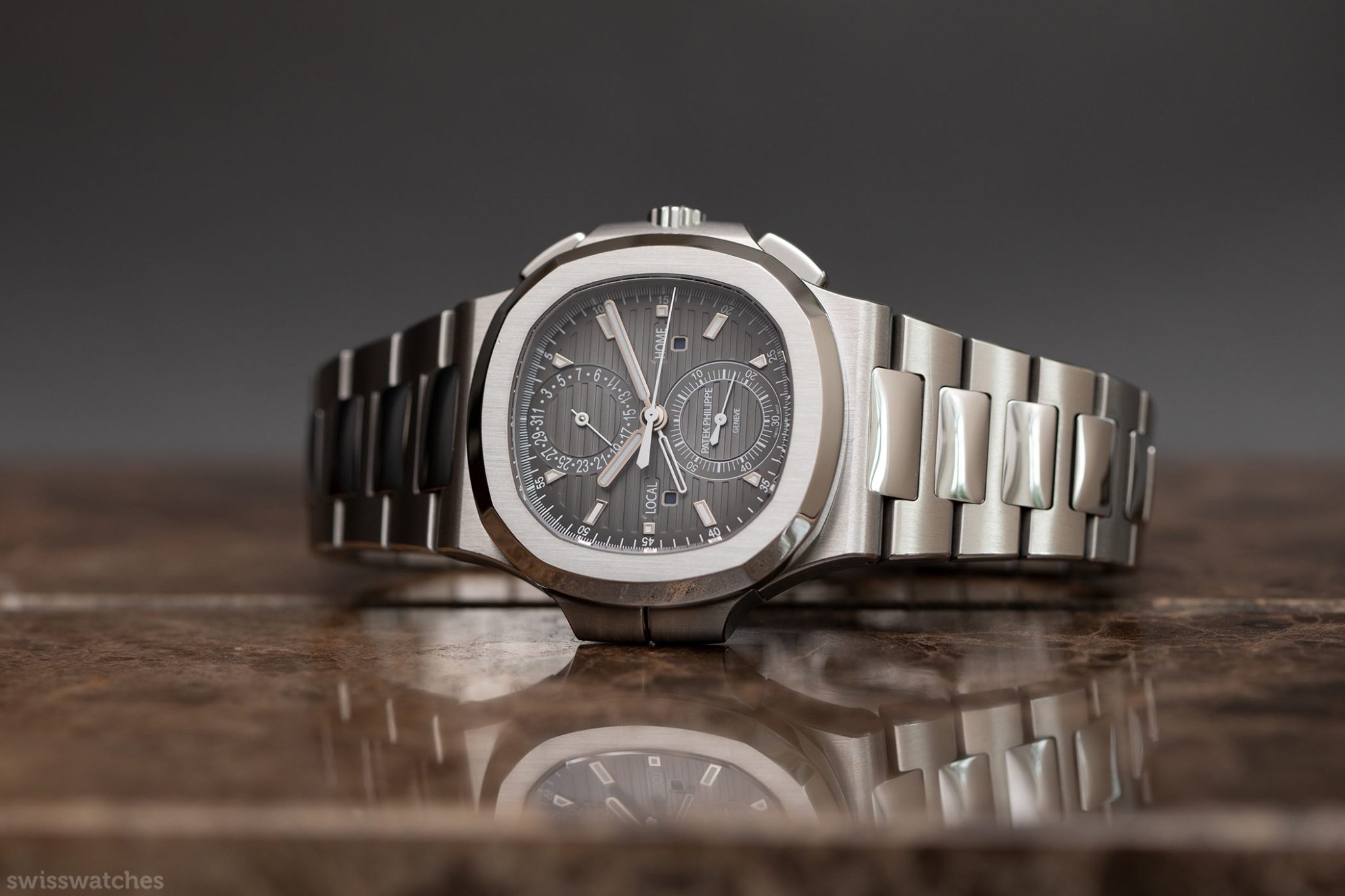
Ref. 5990/1A-001
From the Jumbo to the Big Jumbo
Upon its 40th birthday, the case of the Nautilus increased. For the first time, the chronograph of Reference 5976/1G appeared in a 44 millimetre white-gold case. The watch, recognisable thanks to a special dial enscribed “1976 – 40 -2016”, is a limited edition of 1300 pieces. Furthermore, the strictly limited 700 pieces of the platinum version, also presented for the 40th anniversary, are extremely rare. After all, platinum is a material that traditionally enjoys the very highest reputation among top collectors. In addition to the anniversary inscription, the Reference 5711/1P can also be identified by its applied diamond indices. This is how the great watch of yesteryear became the discreetly casually elegant uber-sport watch of the 21st century.
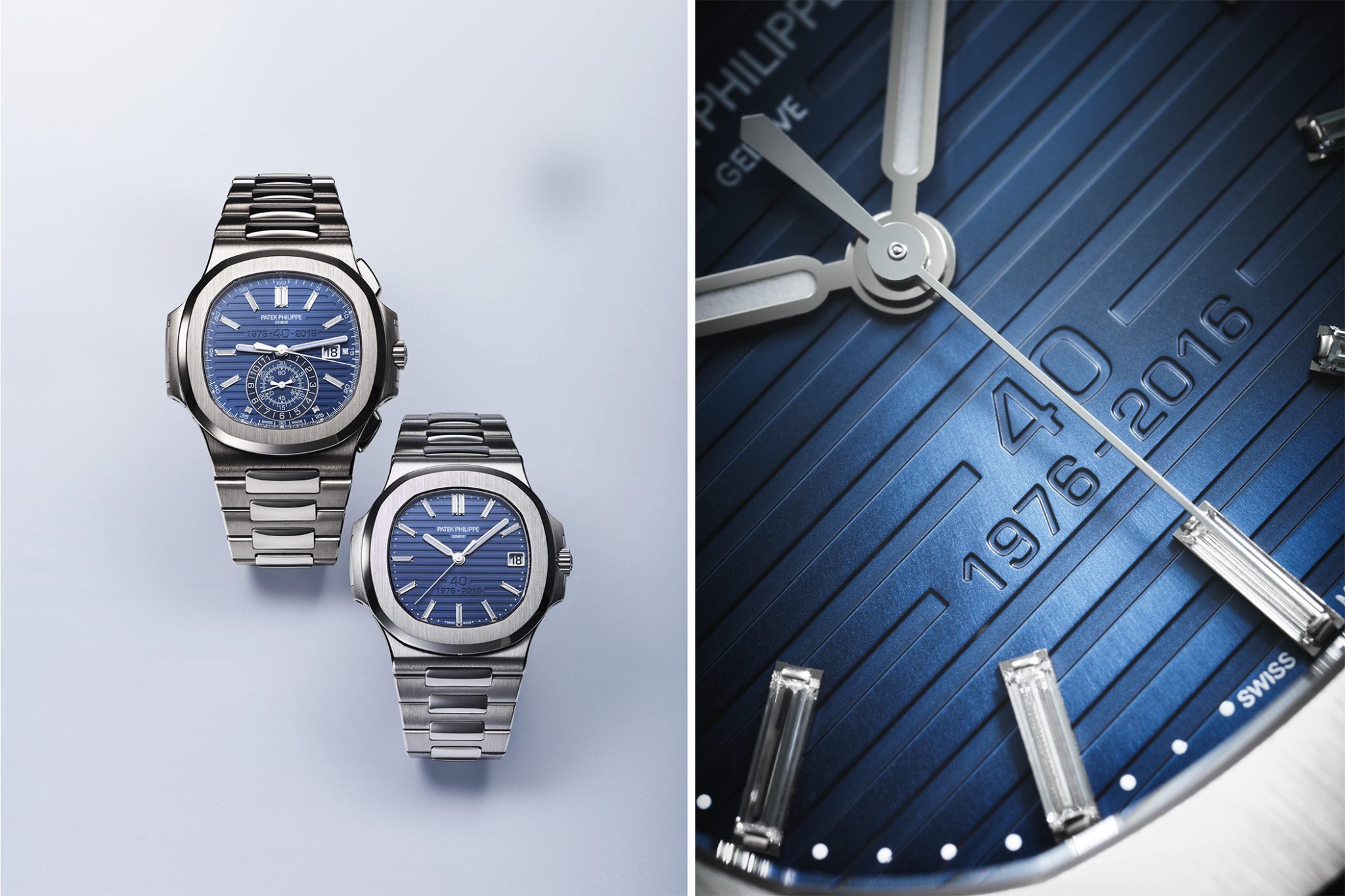
Ref. 5976/1G & 5711/1P
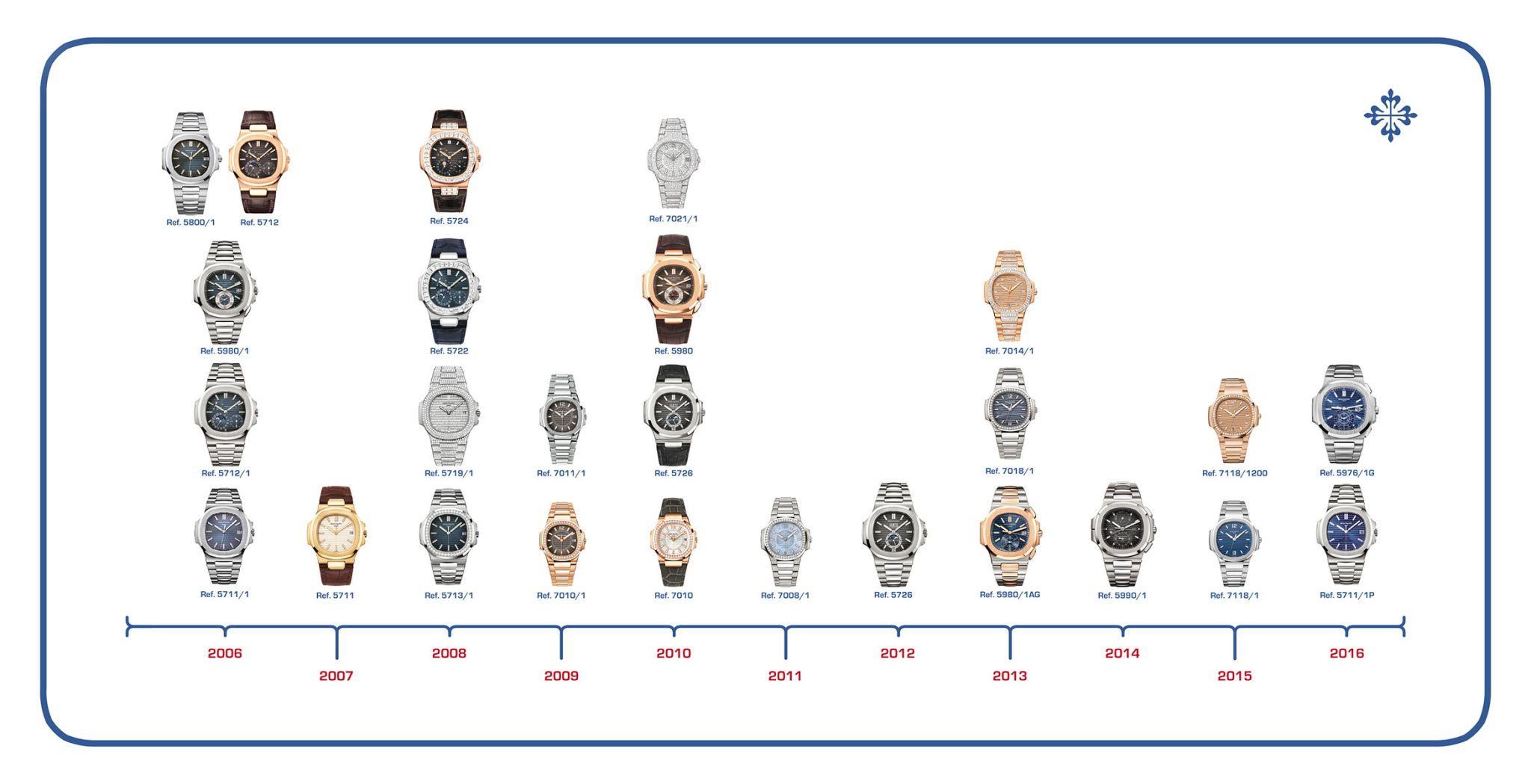
In 2017, the Aquanaut celebrated its twentieth birthday with two beautiful references. With the ability to give the Nautilus real competition peu à peu, Patek released the Aquanaut Travel Time Reference 5650A Advanced Research. With its open-worked dial, it clearly demonstrates where the journey is going technically for sports watches: even more complicated, and even more precise. Finally, at this same time, the ladies’ Nautilus Reference 7118/1A-010 with white dial and the brown dial 7118/1A-011 in stainless steel were also introduced.
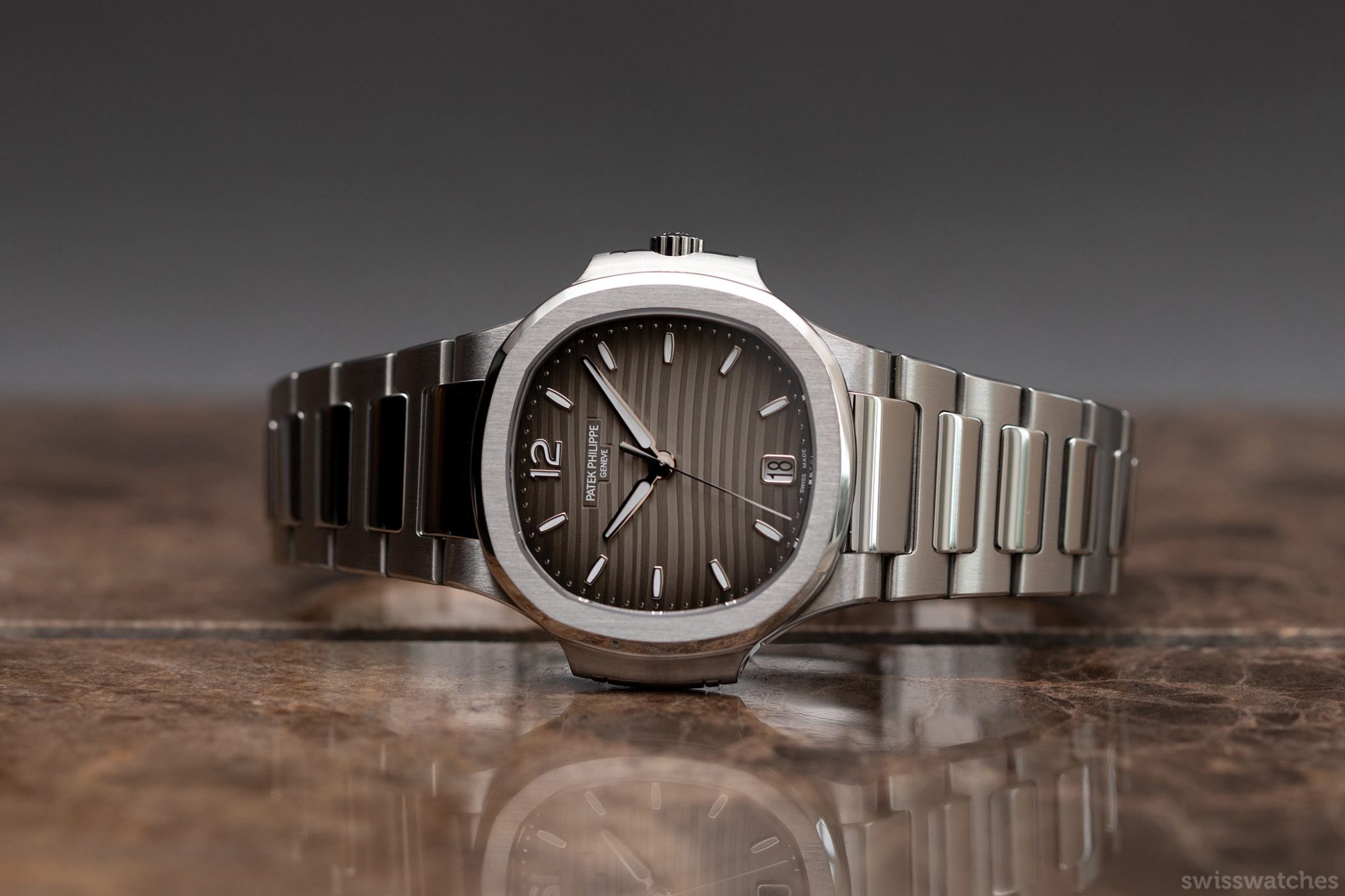
Ref. 7118/1A-011
Created for eternity
In 2018, a classic complication made its way into the sports watch range in the form of the first Nautilus with a perpetual calendar (Reference 5740/1G-001). At the same time, the first Aquanaut chronograph was also introduced. In 2019, another complicated Nautilus was released for the first time with the famous blue dial, the very practical annual calendar Reference 5726/1A-014 with moonphase. By this point, the demand for the classic look of the Nautilus was already plain to see. Replacing the two discontinued 5726/1A variations, the new version differs from its predecessors only by its dial.
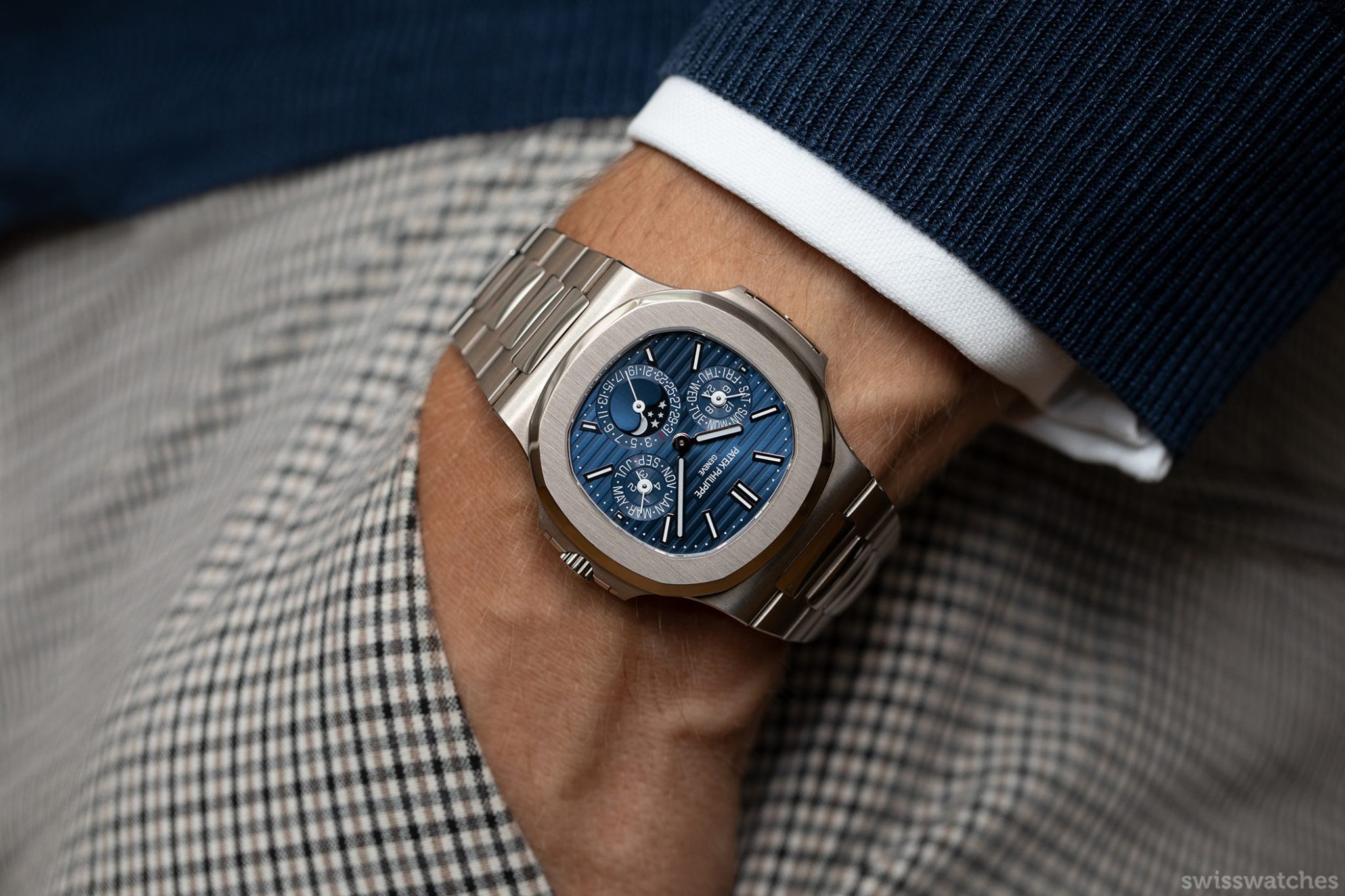
Ref. 5740/1G-001 & 5726/1A-014
Another not-to-be-underestimated innovation was also introduced in the classic Ref. 5711. Instead of the calibre 324 SC, the newer calibre 26-330 SC has been installed ever since its introduction. This step is an interesting detail in the product strategy of Patek Philippe; it is, of course, not without reason that one changes a product for which there is high demand. After all, a new movement always means extra work. On an interesting side note, there is not even a press release about this important step for such an epoch-making watch.
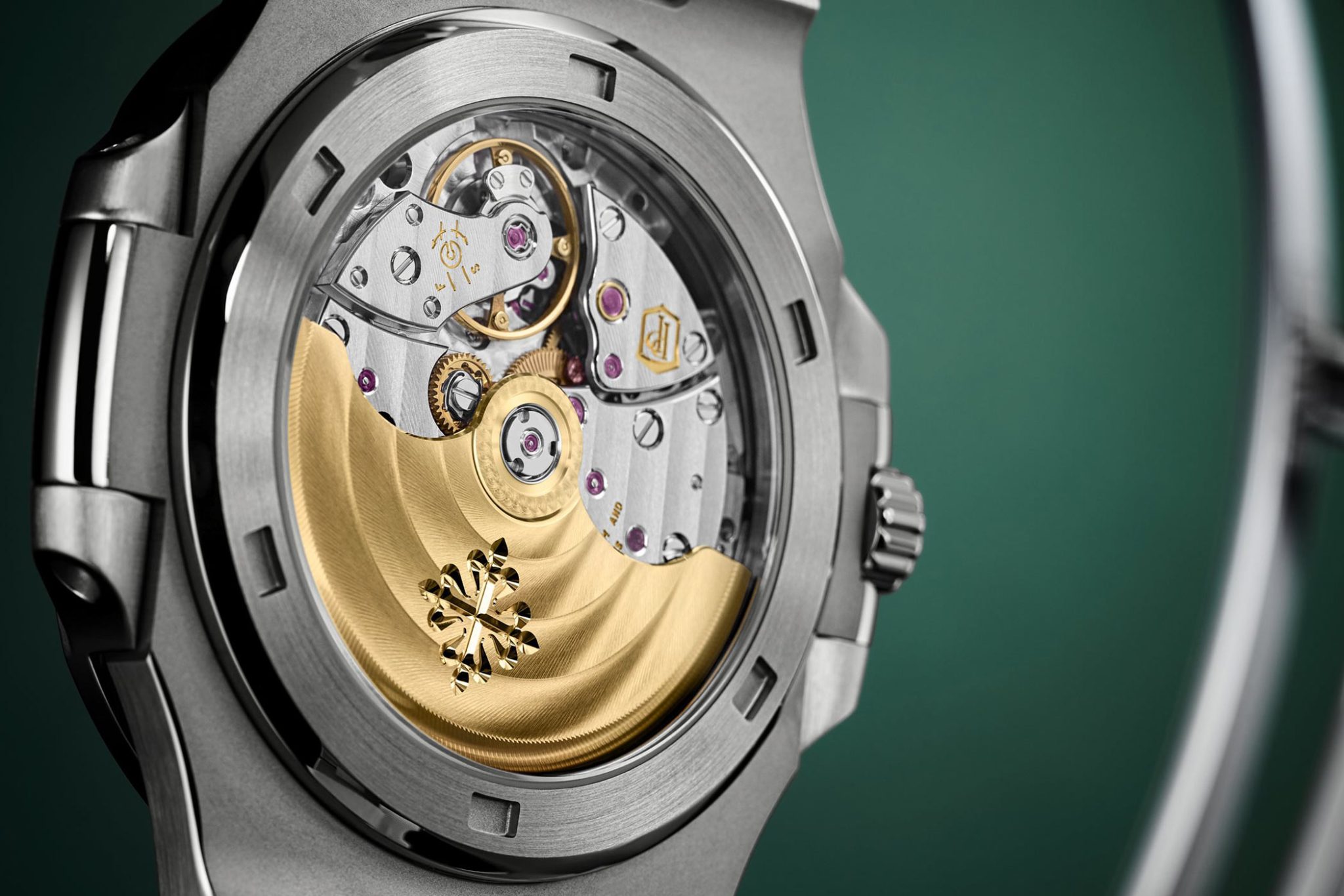
So what is different now? Firstly, the movement is a further developed version of the calibre 324, and would in principle be interchangeable with the basic movement. Almost identical diameter with 26.6 millimetres, it also has the same height of 3.3 millimetres. The new calibre, however, has a special stop-second function, a feature requested by Patek customers for years, which comes into effect as soon as the crown is moved to the time-setting position. Thanks to this device, the user can set the time to the second. When the crown is pushed back into the case, the mechanism gives the balance a slight impulse, which sets it in motion once more.
Today, it’s practically part of the good manners of the Swiss manufacturing elite; it’s how professionals set the time to the second. A second difference in the updated calibre is that the automatic winding of the movement was improved by decoupling the reduction wheel (this is now in the process of being patented). Despite the measures, the number of components nevertheless shrank from 217 in the calibre 324 SC to 212 in the calibre 26-330 SC. The power reserve remained unchanged, offering between 35 to 45 hours.
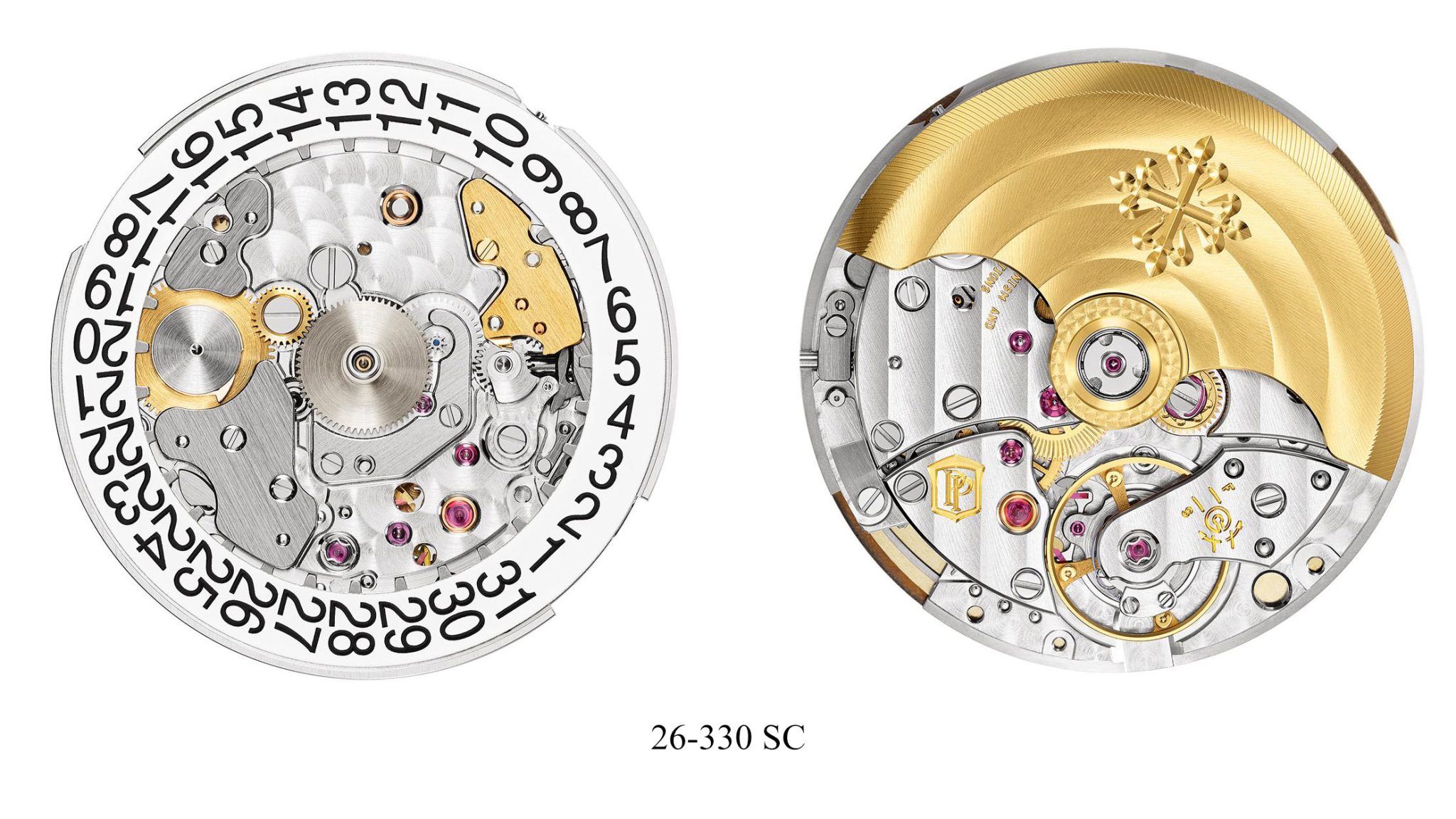
How should we assess this step against the background of the now discontinued Reference 5711? I don’t think Patek would ever even dream of discontinuing the Nautilus, but more on that a bit later. Patek do their homework, think long-term, and listens to its customers. This is probably the latest point at which the long-term plan for the Nautilus was forged, two years before it was discontinued. After all, who would invest in something they don’t want to continue?
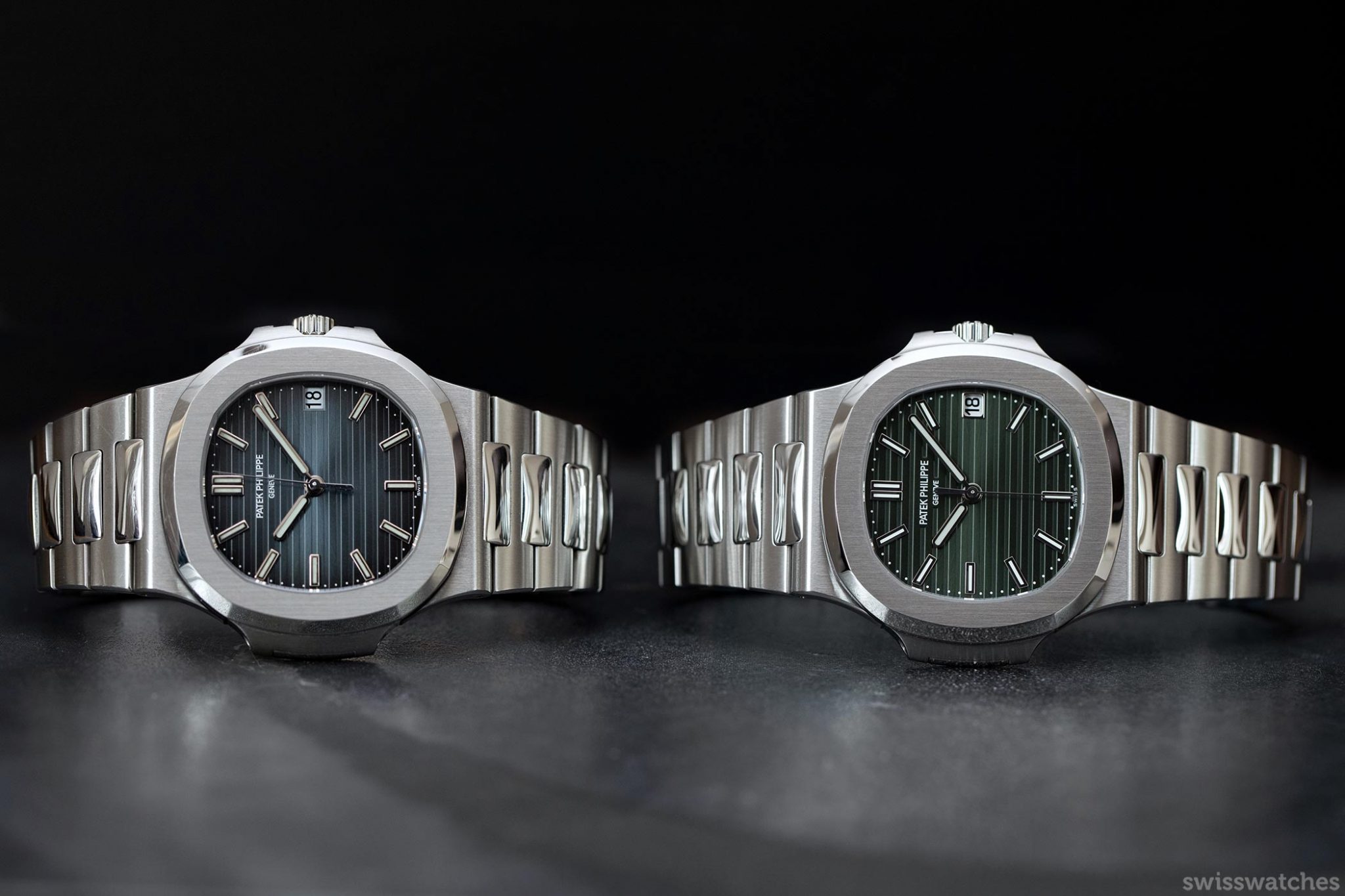
Ref. 5711/1A-010 & 5711/1A-014
But let’s return to the key models. Of course, in 2019, ten years after the relaunch of the ladies’ version with Genta’s last contribution, several other models still need a mention: the ladies’ Nautilus Reference 7118/1200A in stainless steel with date and stop-seconds, which is available with white (7118/1200A-010) or blue (7118/1200A-001) dials plus a diamond bezel. The rose-gold 7118/R-001 with white dial also deserves a mention, alongside the beautiful rose-gold version with a gold dial (Reference 7118/1R-010).
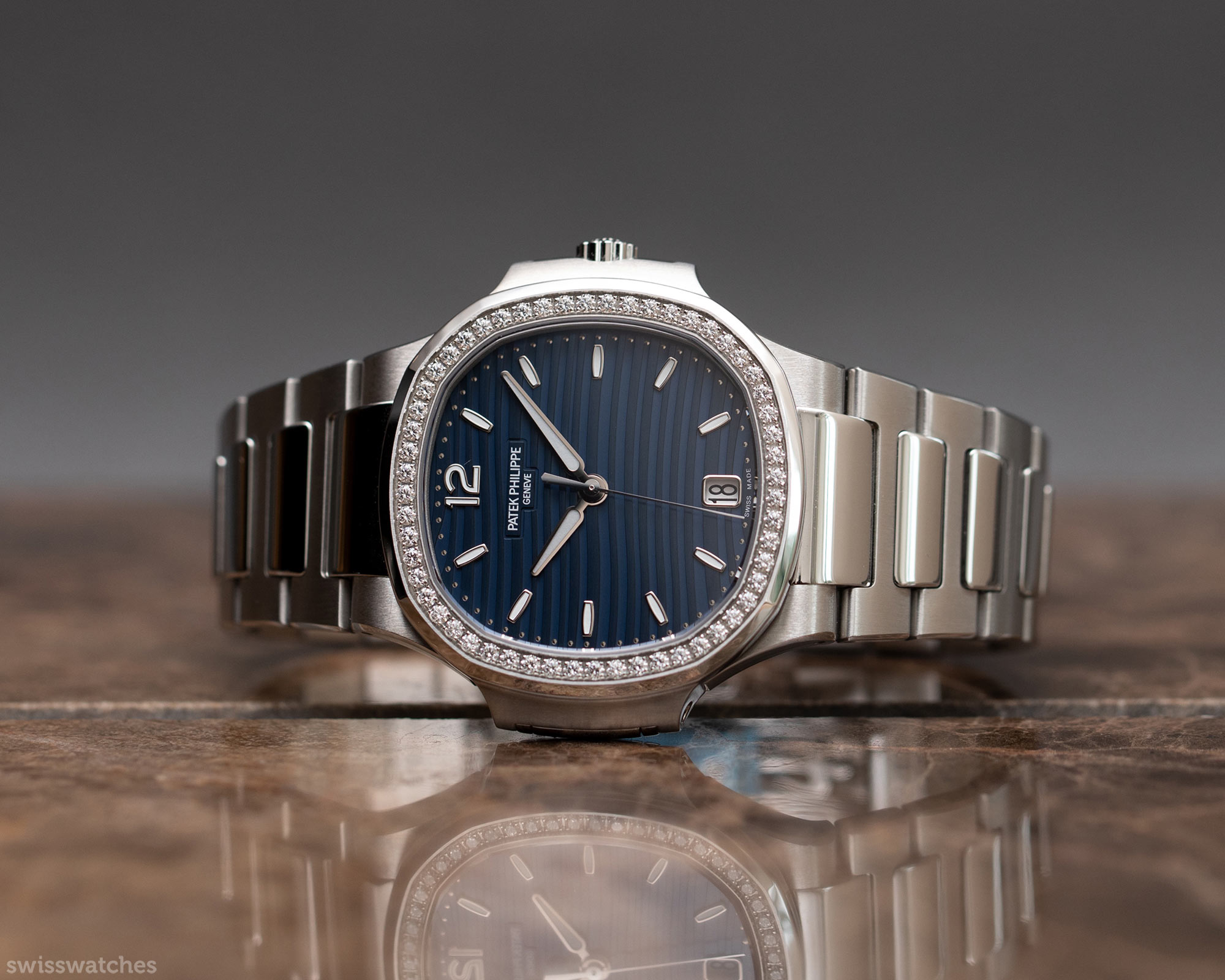
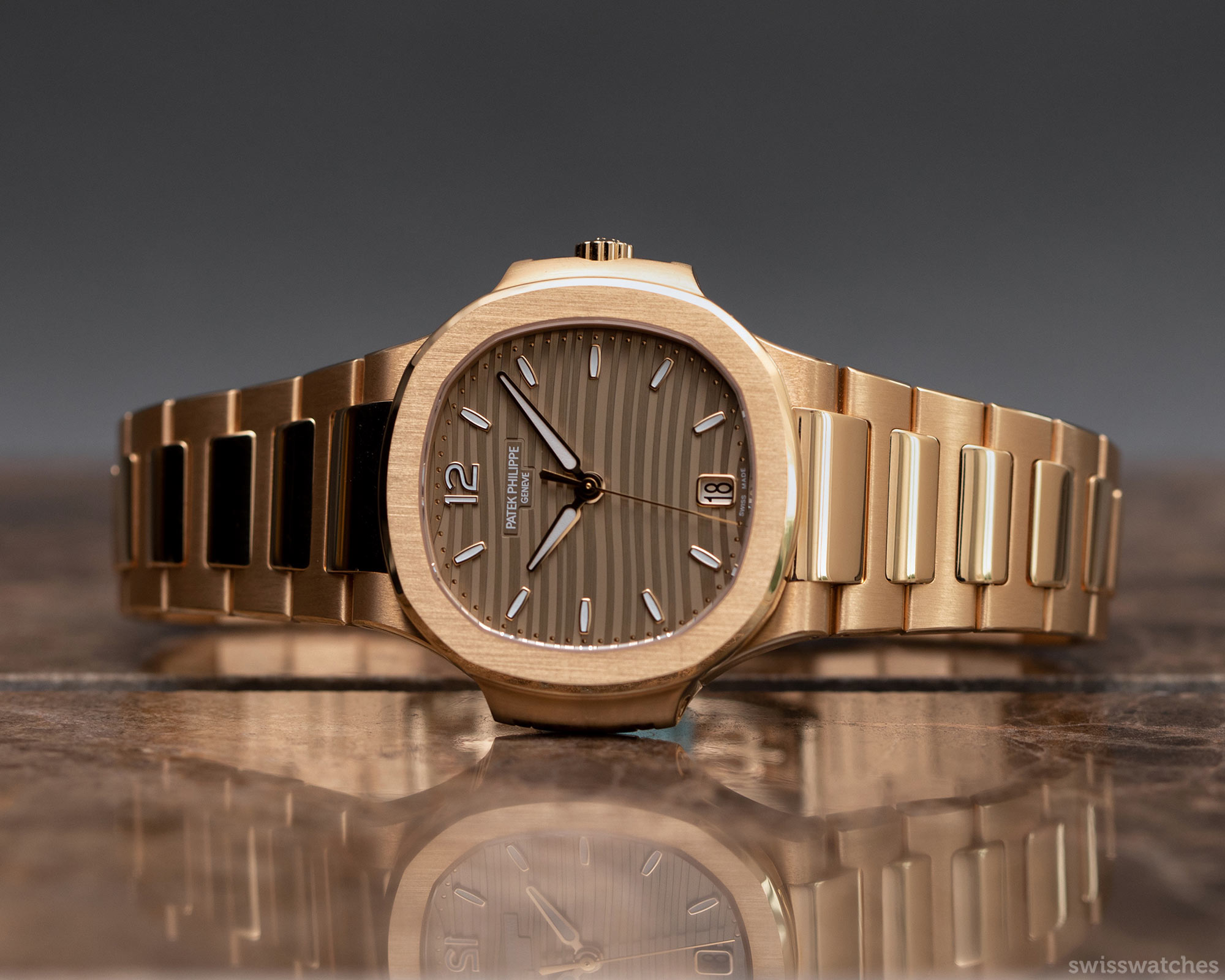
Ref. 7118/1200A-001 & 7118/1R-010
The calm before the storm
In 2020, the calm before the big storm continued. No new Nautilus reference had launched on the market. According to an article in the New York Times, the dice had already rolled in Geneva in favour of a classic Nautilus. Thierry Stern went on record in February of this year:

“In 2019, at Baselworld, I said that I thought there were too many Nautilus watches out there. The discontinuation of the Ref. 5711 was on my mind at the time. And when I made the decision in 2019, we already knew what was coming next.”
– Thierry Stern
An olive-green farewell
Why the Stern family chose an olive-green dial, of all things, to bid farewell to the stainless steel model may remain their secret. But I hope not, not least because number of Patek fans must have been green with irritation to have been crossed off waiting lists, some of which they had been on for a good decade. Thierry Stern was perfectly aware of what he was doing, confessing to the New York Times, “Some dealers were getting only two Nautilus a year, but had 100 names on their waiting list.”
Yet that does not detract from the significance of the final steel variation. On April 7, 2021, they made the following statement at the new Geneva watch fair. “Following the announcement that 2021 will be the last production year of the stainless steel model Ref. 5711/1A, this cult model is unveiled with an olive green dial – a hue that never existed before in the Nautilus collection. This new shade replaces the Ref. 5711/1A-010 with a blue-black gradated dial.”
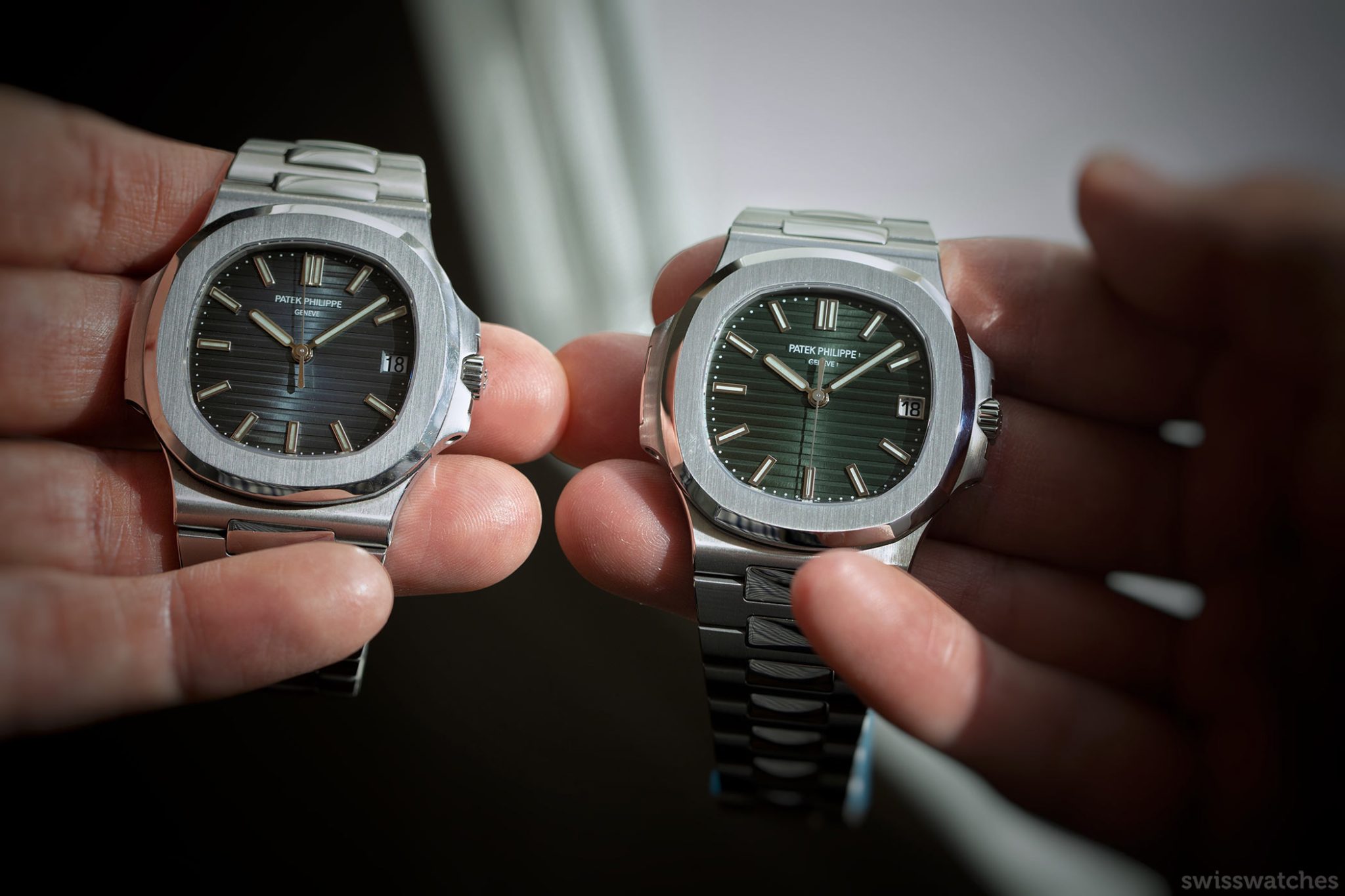
Ref. 5711/1A-010 in Blau & 5711/1A-014 in Olivegrün
‘Never’ – and this should be noted for connoisseurs – does not exist in the watch world. Collectors will know very well that there are, let’s say, ‘involuntarily green’ Nautilus models, whose dials changed colour due to sunlight. Of the first estimated 3,300 or so examples (according to acollectedman.com) of the original Reference 3700/001A, the dials called “Type 6” and “Type 7” are particularly affected. They were made at Stern Fréres at the time, the supplier from which the current owner’s family originated and which has since been integrated into the manufacture.
What will follow the classics?
We can return to the latest news, given this already provides an impression of what could soon be coming to fans and collectors. One thing is certain: the Nautilus will continue to exist – just a little differently. On the one hand, we have seen interesting jewellery watches in Geneva in 2021 which provide information about this. For example, a new and unique combination of stainless steel and baguette diamonds appeared with the introduction of the Reference 5711/1300A-001. The distinctive shape of the bezel and case is accented by a ring of 32 flawless Top Wesselton baguette diamonds. Each baguette diamond bears a special, slightly trapezoidal shape instead of the classic rectangle and is cut to match the octagonal bezel contour with its rounded corners.
Ref. 5711/1300A-001
Anyone familiar with diamond cutting knows that jewellery is usually designed around the stones in order to have as little loss of them as possible. Every diamond loses about 50 percent of its original material during the cutting process. In the case of pavé watches, another 60 percent or so of this is lost, so that a three-carat diamond on a ring is about half as cheap as three carats in a wristwatch, as the owner of the Bunter SA company once explained to me.
In addition to baguette diamonds, we also saw another Nautilus with so-called arbitrary full diamond setting with the ladies’ Reference 7118/1450R-001 (not that some rappers hadn’t picked up a 5719/10G with 255 diamonds before, or one very special customer picked up the very first snowflake setting Nautilus from 2010, the Reference 7021/1GR).
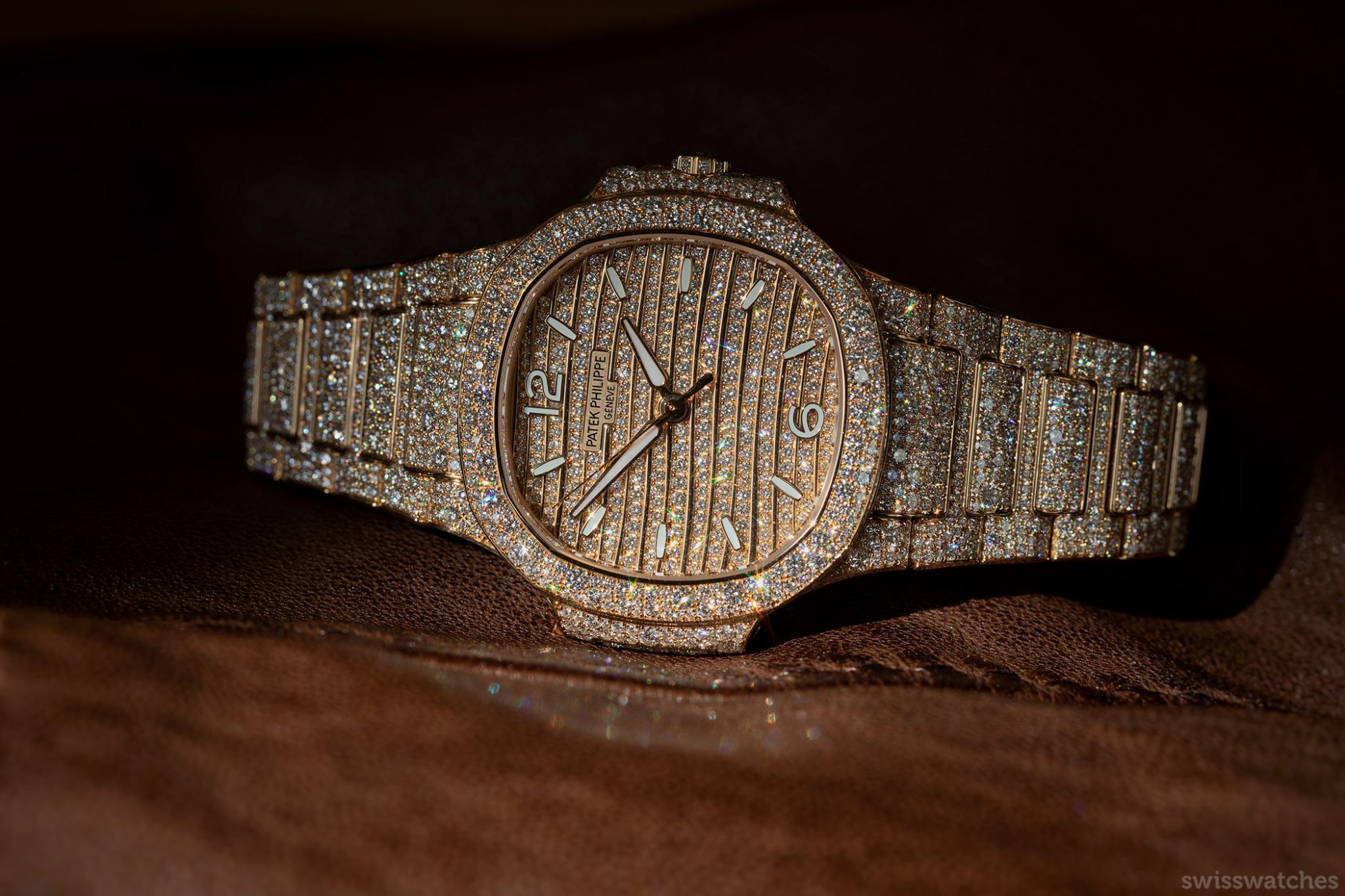
Ref. 7118-1450R-001
On the new Haute Joaillerie model in rose gold, however, 2,553 flawless Top Wesselton diamonds glitter on the case, bezel and bracelet, set in the very rare pavé technique. In this so-called ‘snow setting’, diamonds of different sizes are arranged in a free form so that as little precious metal as possible shows through between the individual stones. Sorry, Jay-Z and co., it’s finally ladies first here. Among the complicated models, the practical Travel Time chronograph first appeared with the distinctive blue sunburst dial in Reference 5990/1R-001, but this model is housed in a full rose-gold case.
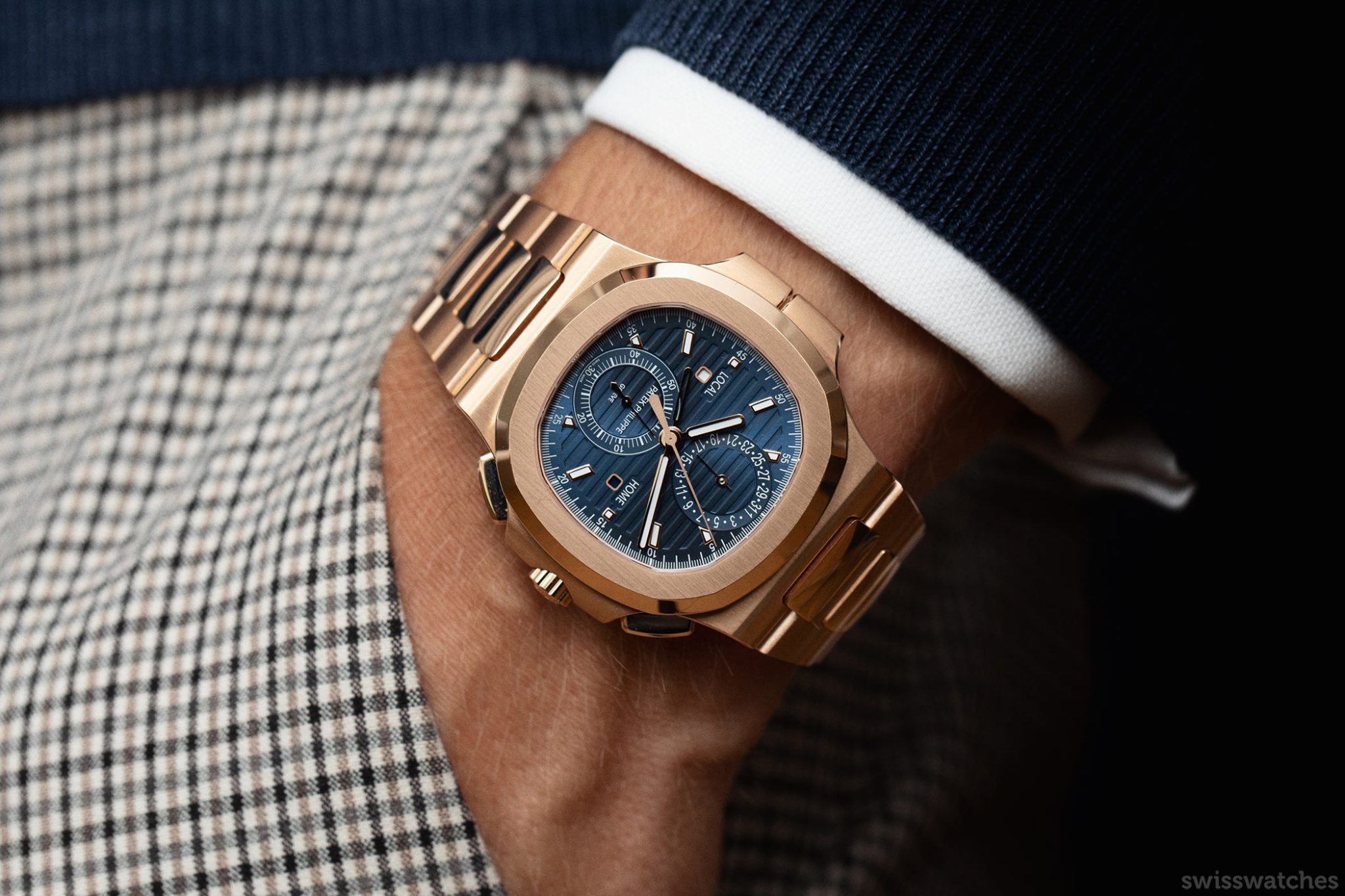
Ref. 5990/1R-001
What’s coming up as we reach 50 years of the Nautilus in 2026?
As one of the last family-run Swiss manufactures, Patek Philippe has the great fortune of being able to develop and refine its products over many decades. It’s a privilege of which the company’s current president, Thierry Stern, is well aware. Up until now, the company has faced huge worldwide demand for the Nautilus, so the foresight of his father and grandfather has paid off. The entire family resists all temptations after certain short-lived trends.
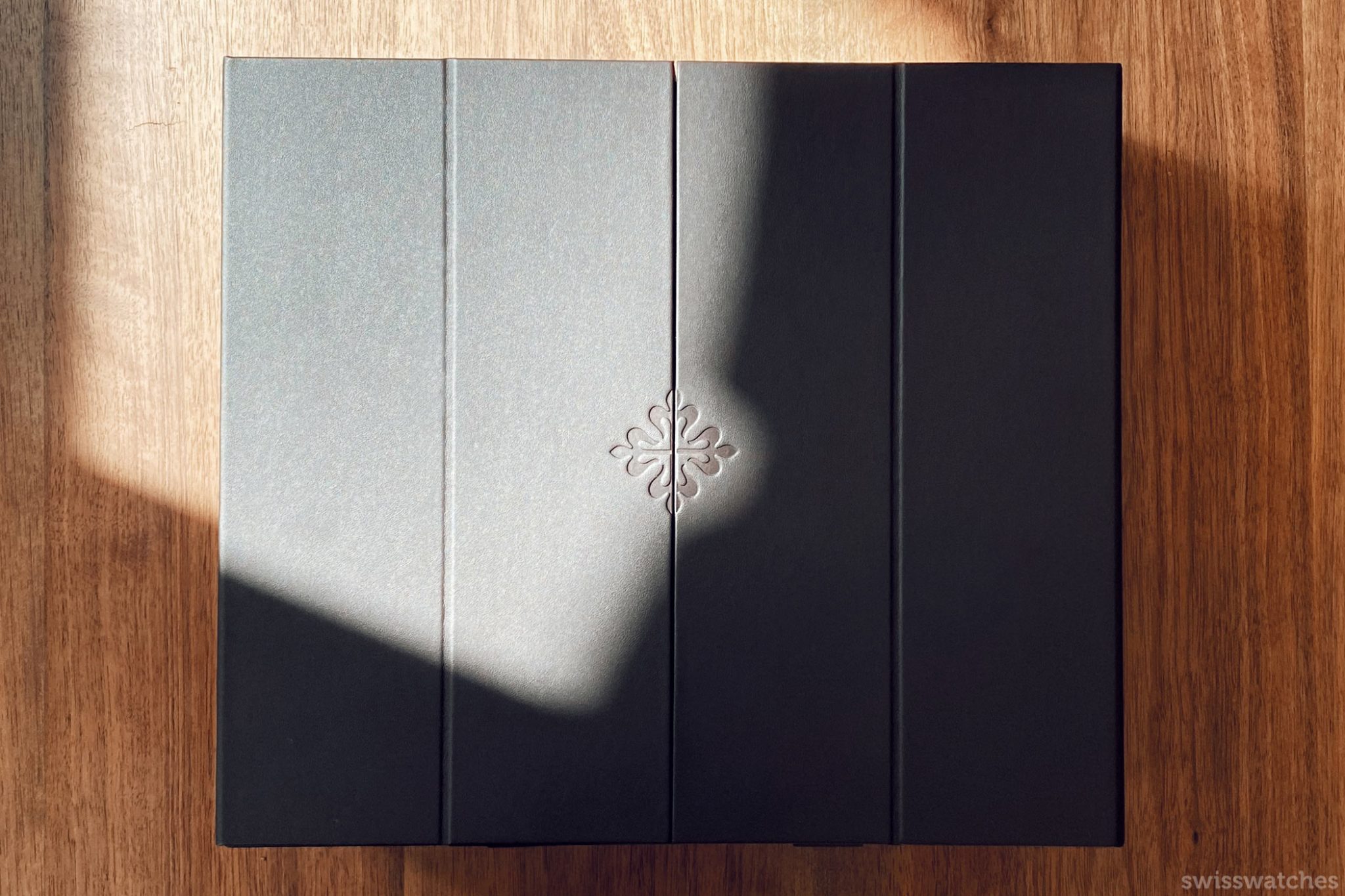
Thierry Stern, who himself was given a Nautilus by his father on his 21st birthday, celebrated the icon’s 40th birthday very discreetly; the two anniversary models with their blue dials are initially very reminiscent of the 1976 model.
But at Patek Philippe, you always have to take a closer look. Sandrine Stern, for example, provided the dials of the anniversary watches with bar-shaped diamonds instead of the classic luminous indices. The fact that these watches today go not only with a diver’s suit but also with a business suit, as the advertising once promised, is discreetly indicated by the case materials chosen; they are not available in steel, but only in limited white gold and platinum versions. And the fact that the limited-edition chronograph has been housed in an even larger case than the “Jumbo” of yesteryear indicates that the Stern family has already taken another step forward. The next generation of watch collectors is already ready and waiting.
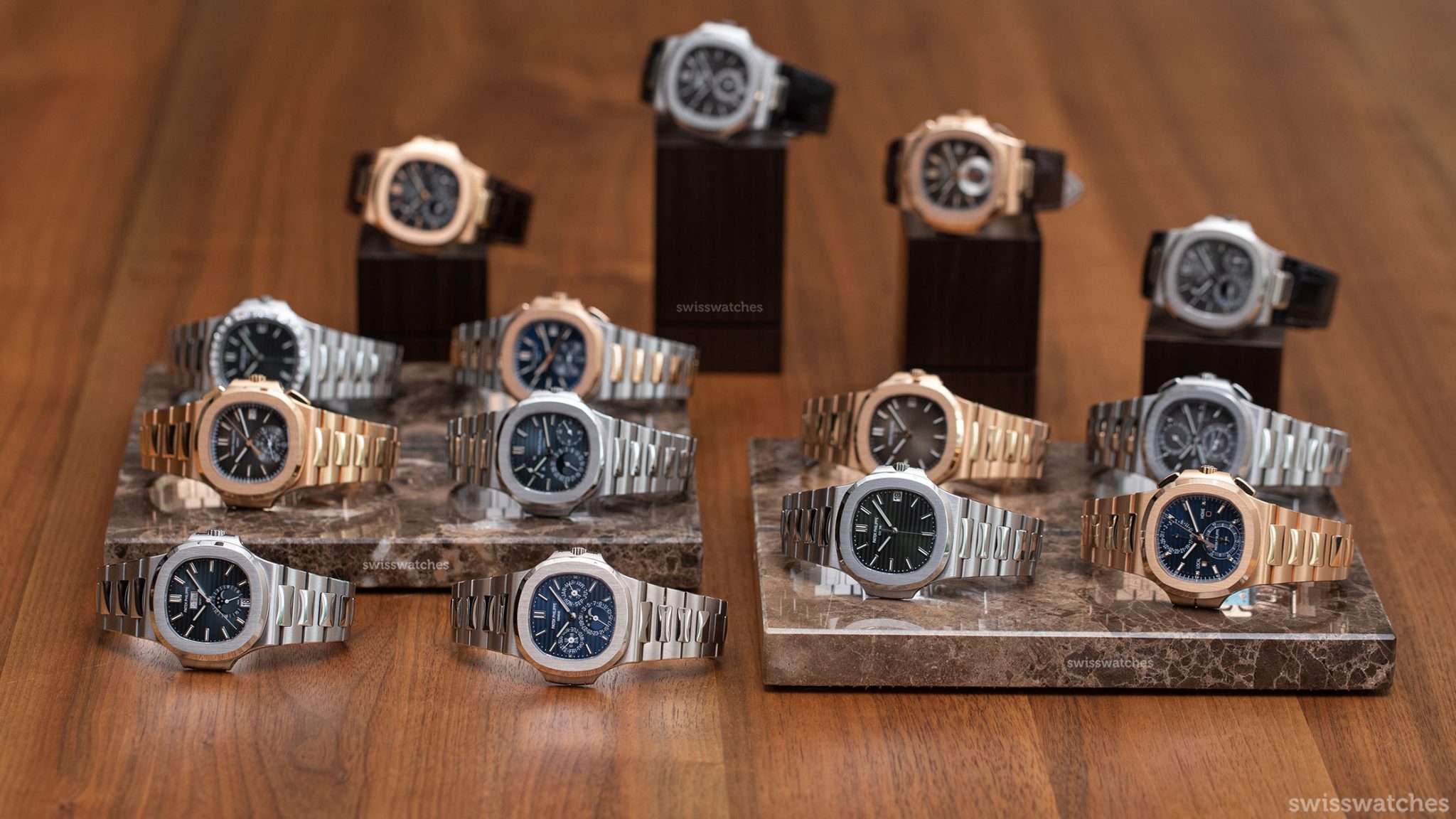
The big anniversary
We are now five years away from the big 50th anniversary of this ultimate cult watch. Geneva usually prepares meticulously for such occasions years in advance. If the decision to discontinue the Reference 5711/1A is really made in 2019 and not, as many experts assume, well before, there will still be enough time for groundbreaking developments. Also speaking to the New York Times, Thierry Stern was actually very clear – by his standards – about what’s coming: “Discontinuing the Nautilus was a major decision, but we have a plan.” He went on to say, “The replacement for the Reference 5711 will be pretty big. It will be better than the Reference 5711, but I’m not going to say today what metal it will use, or if it will be in steel. It will be something else, very close, and logical.”
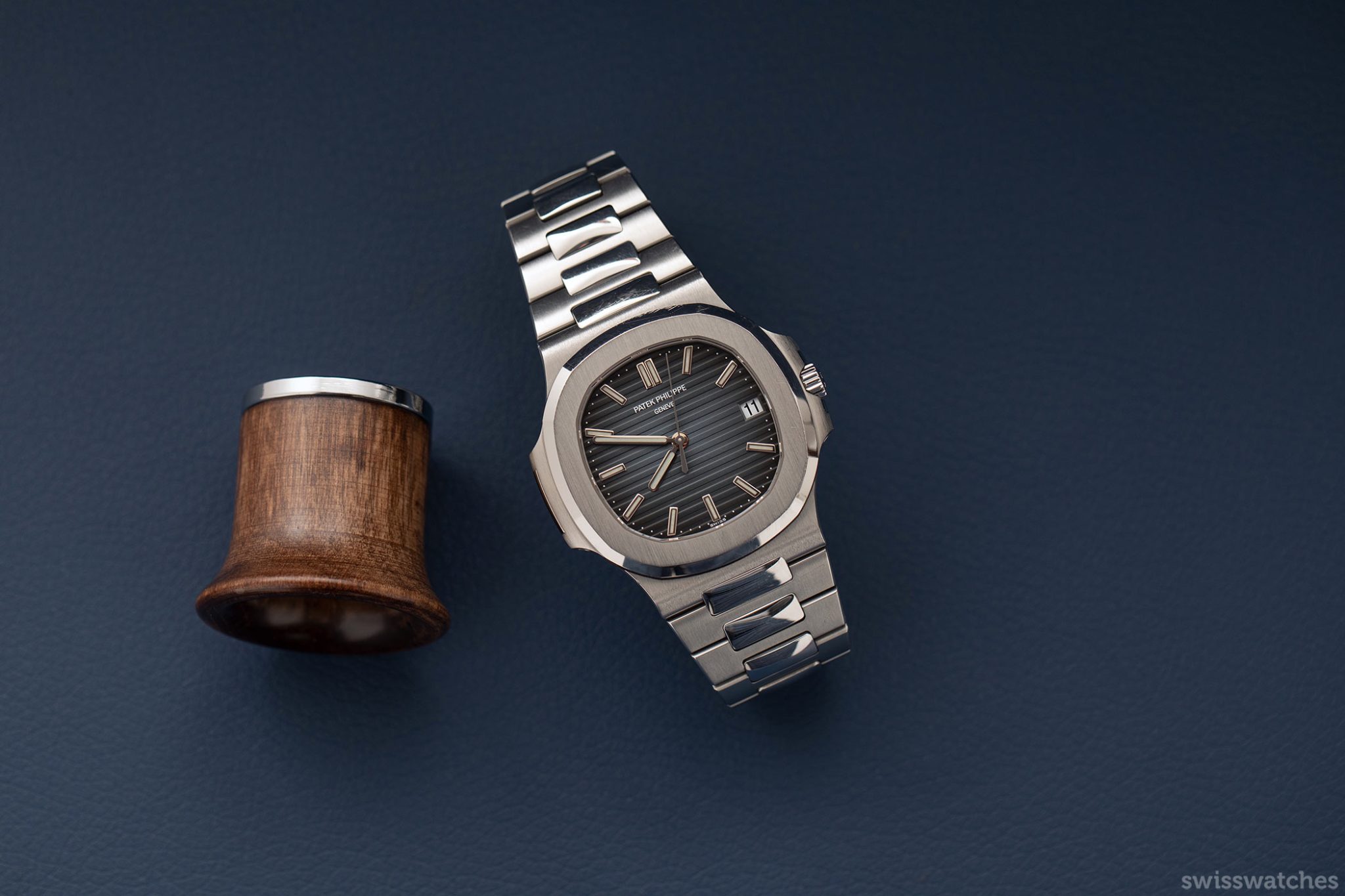
The all-important movement
Leaving aside the question of materials, a new version of the classic Nautilus would definitely want to stand out above all in terms of watchmaking, and in a way that is unique to the company. Thierry Stern’s father, without whom the Nautilus would not exist, once said, “My dream was always to make a normal watch that was more precise than a tourbillon.” That could be a move towards, for example, an even flatter, much more precise sports watch standard movement than we know today with a power reserve that runs well beyond a long weekend.
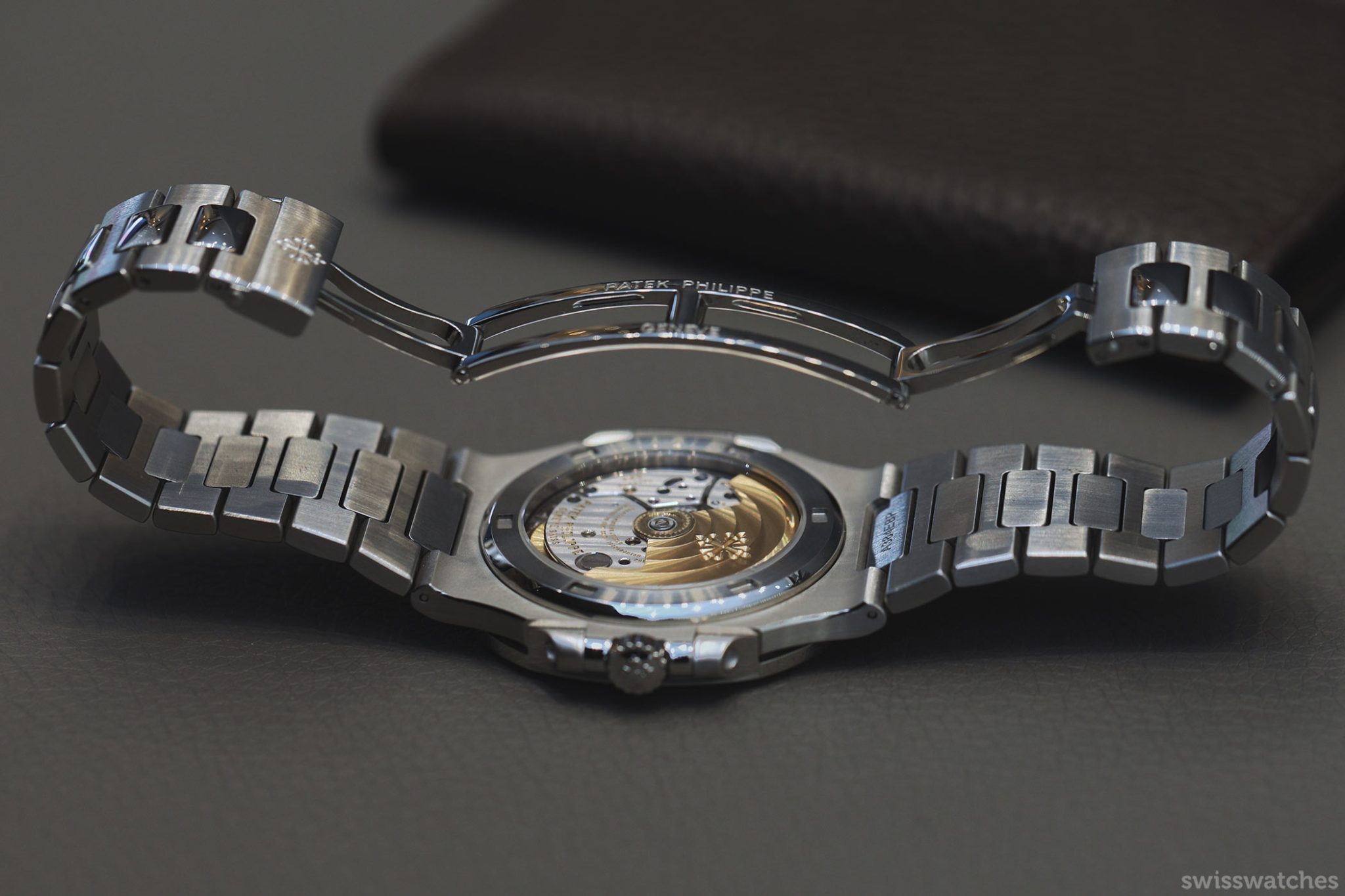
A small cross-reference: OMEGA also presented a completely new calibre for its 50th anniversary in its Speedmaster Professional Moonwatch – in this case, of course, a revised version of the legendary calibre 321. Charmingly, a platinum version has just been presented, a material that is currently on everyone’s lips. And Rolex is leading the way with ever-improving standards, from ten-year warranties to its own accuracy standards. All of this will be reason enough for the Stern family to give a lot of thought to ultra-precise movements with extremely long power reserves and high suitability for everyday use. Whether it is worthwhile for the Sterns to address the issue of water resistance remains to be seen. But I think, with 120 meters, they are well positioned. For superlative diving depths, you’ll have to look a few streets away in Geneva.
A grand complication for the Nautilus
We can now speculate which complications will be used in which combination for the anniversary. It should at least be a perpetual calendar in combination with a chronograph; anything beneath that would be unworthy of a Thierry Stern. Whether a new type of tourbillon or first truly water-resistant minute repeater would make sense is something I doubt, since this would risk adjusting the character of the Nautilus line.
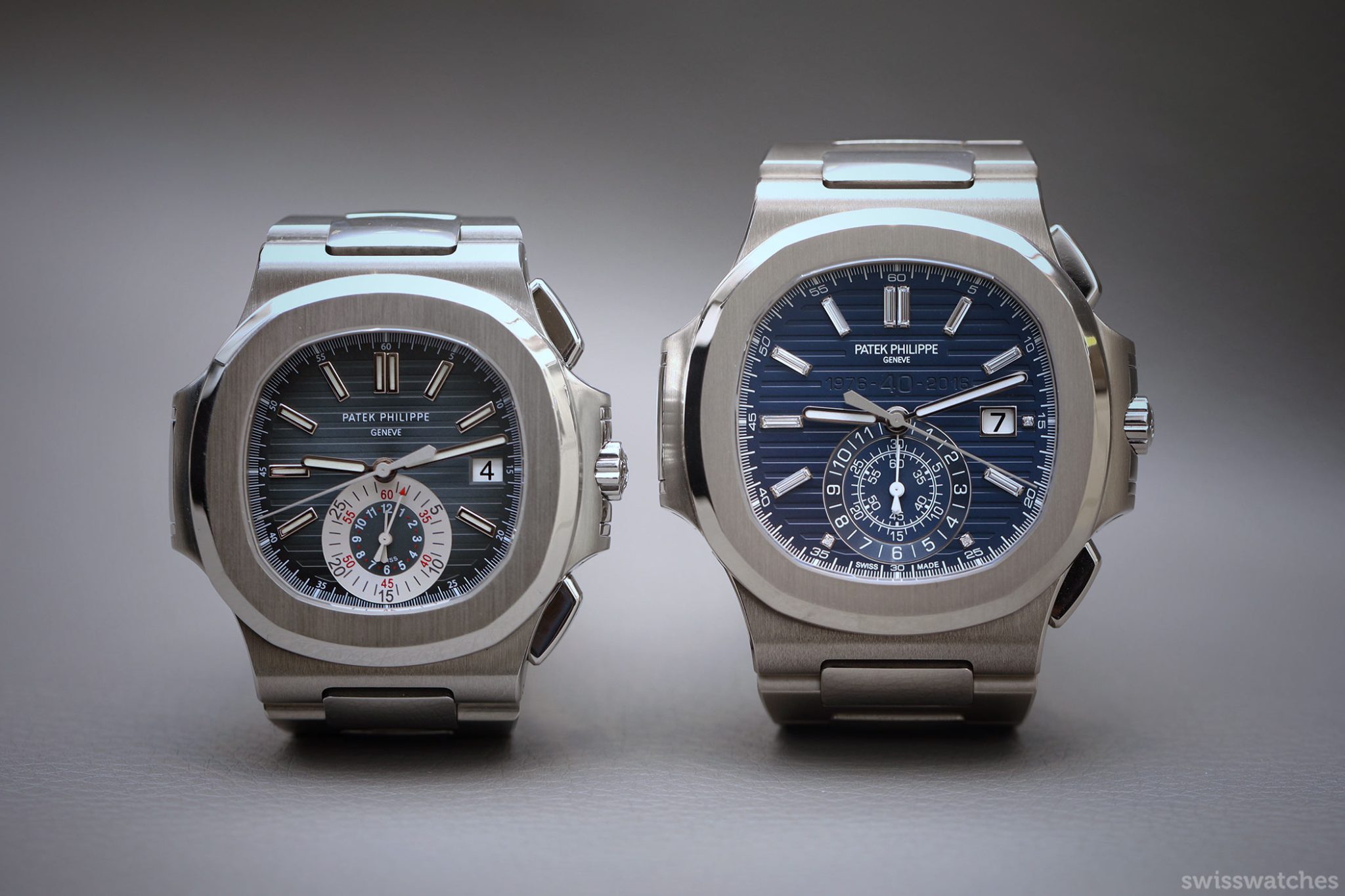
Ref. 5980/1A-001 in steel (40.5 mm) & Ref. 5976/1G in white gold (44 mm)
An alarm function with a strikework like in the Grand Complication 6300G with a reversible case would be more to our taste, not to mention practical. Whether the Traveltime mechanism can be combined with a perpetual calendar or a chronograph, as well as a weekday display, is a question for the engineers to answer. This company could be trusted with it, plus these functions would fit a classic sports watch.
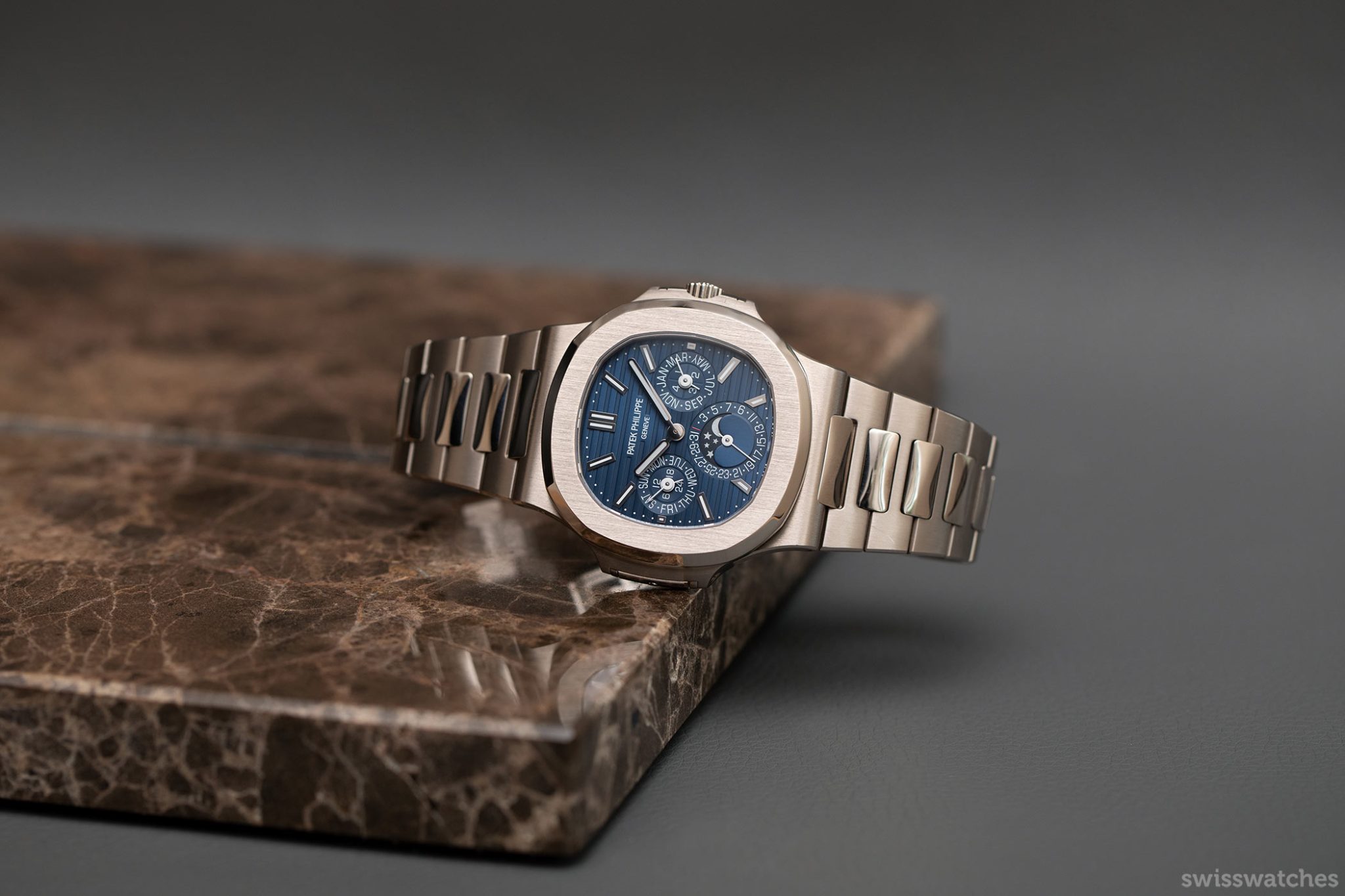
Nautilus Ref. 5740-1G Perpetual Calendar
The rarest of Patek Philippe Nautilus models
Just in case you have the money, but you’re feeling bored of all the talk about the steel version – read on. What is the most important collection criterion? Origin. Behind the buzz word “double signed” is something at Patek that is rarely seen today: watch models with dials printed by famous dealers with their names. As watch specialist Virginie Liatard-Roessli of the Phillips auction house wrote at the start of the largest Double-Signed auction at that point in 2019, “It seems that it was Patek Philippe that started the trend of double-signed watches, thanks to its relationship with the famous New York jeweller Tiffany & Co. The story goes that Tiffany sold its first Patek Philippe in 1851, and that the two have worked together continuously ever since. On December 22, 1854, a picture of Antoine Norbert de Patek shaking hands with Charles Lewis Tiffany was taken as a testament to this strong partnership.”
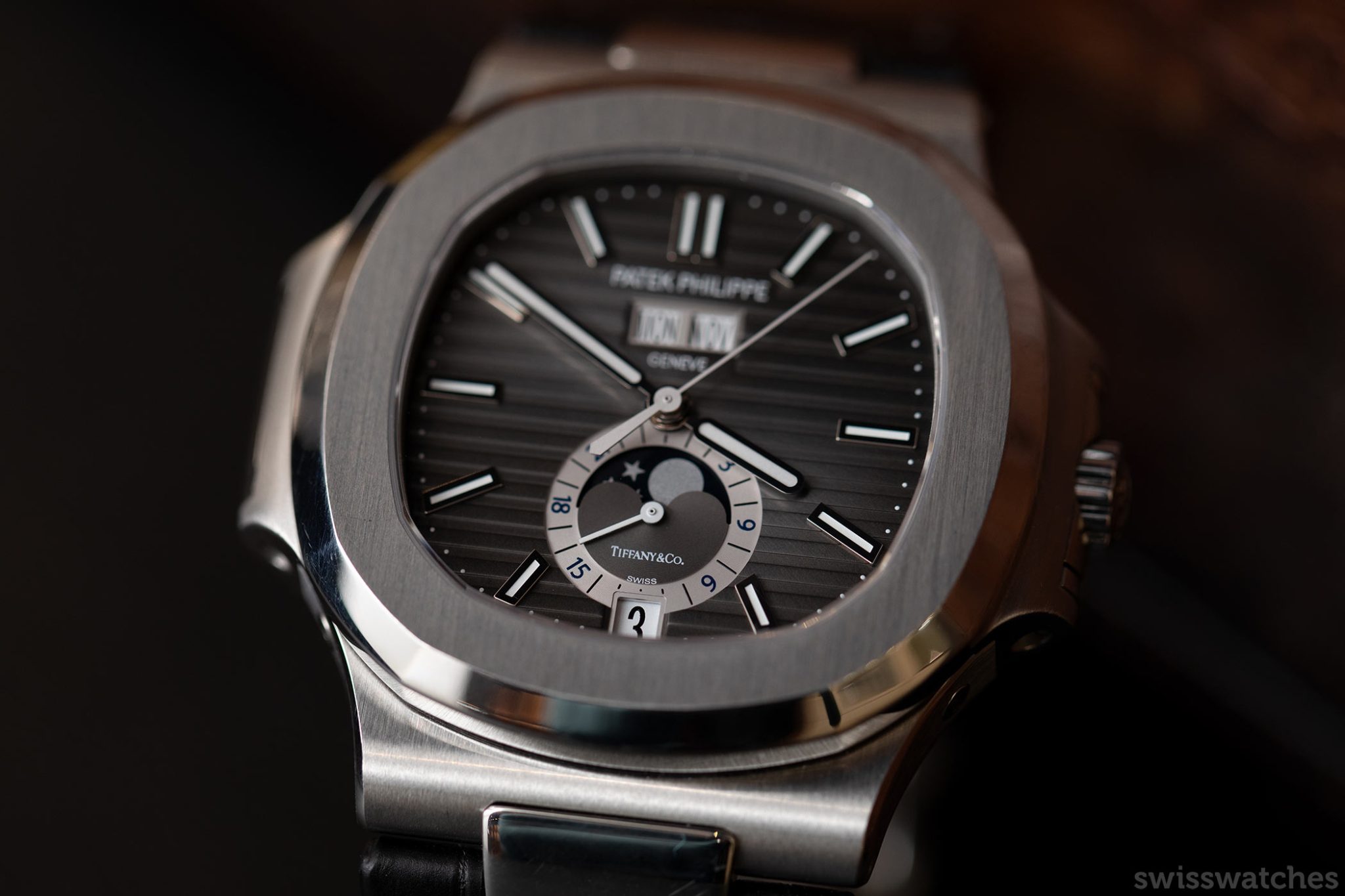
Ref. 5726A “TIFFANY & Co.”
Over the years, Patek Philippe established new partnerships with more and more dealers, but only with the best of the best. From Chronometrie Beyer in Zurich, in business since 1760, it is said that the archives know of watches that have been imprinted with the company’s own name since 1899. Whether it was Gübelin from Lucerne, Gobbi from Italy or Gondolo & Labouriau in Brazil, the dials with the names of these companies were usually printed onsite after the watches had been received from Geneva.
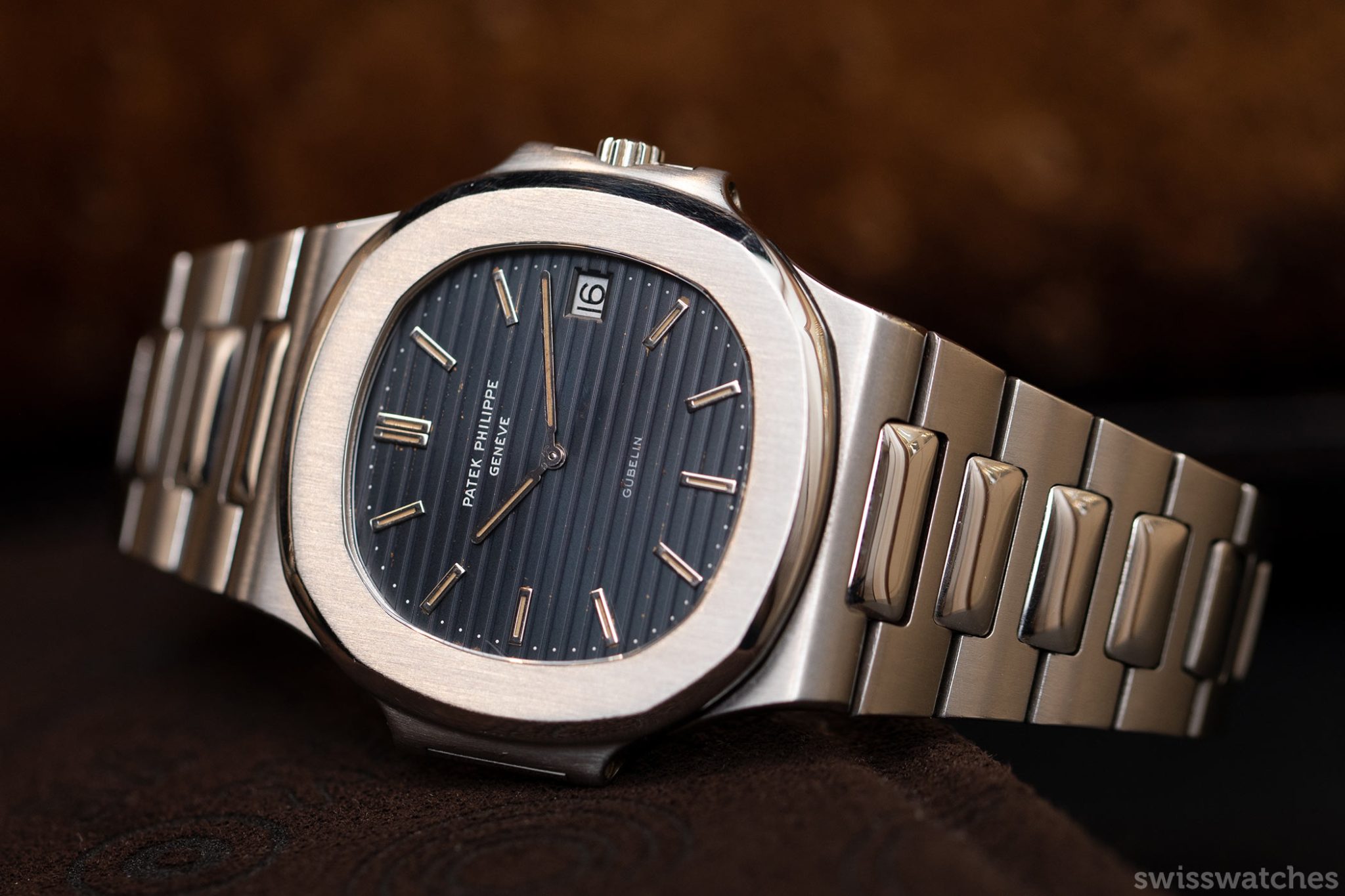
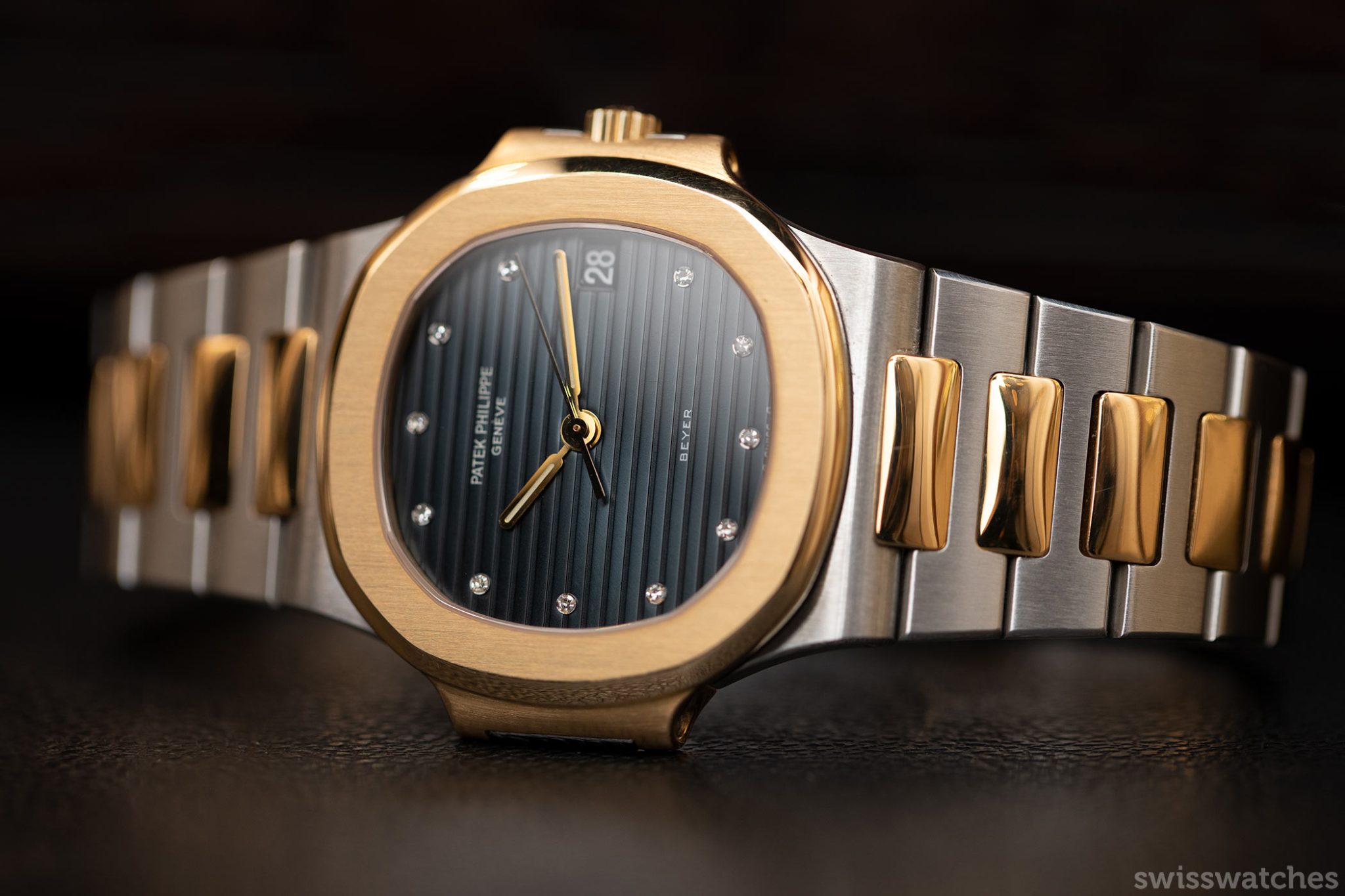
Ref. 3700/1A “GÜBELIN” & 3800/1JA “BEYER”
Colleagues at “a collected man” have written a wonderful article about this, which deserves a mention. Even the very first references of the Nautilus exist with these stamps, like the 3700/1A GÜBELIN shown here or the 3800/1JA by BEYER. However, the oldest form of this cooperation at Patek is between the Geneva manufacture and TIffany. It remains the longest existing partnership between a jeweller and watch manufacturer. If you want to try your luck, here is the phone number to purchase such a coveted watch: Tiffany & Patek Philippe Partnership.
The rarest first generation Patek Philippe Nautilus Jumbo
You want something even rarer? Something that should not exist? Then take a close look at the dial of the Reference 3700/1J shown here. Toni Cavelti is not a watch dealer. Strictly speaking, it is the name of a private person on the dial of a Nautilus. The present specimen was confirmed by the Patek Philippe archive extract from 1977. What reminds you of a fake was actually officially made that way by Patek.
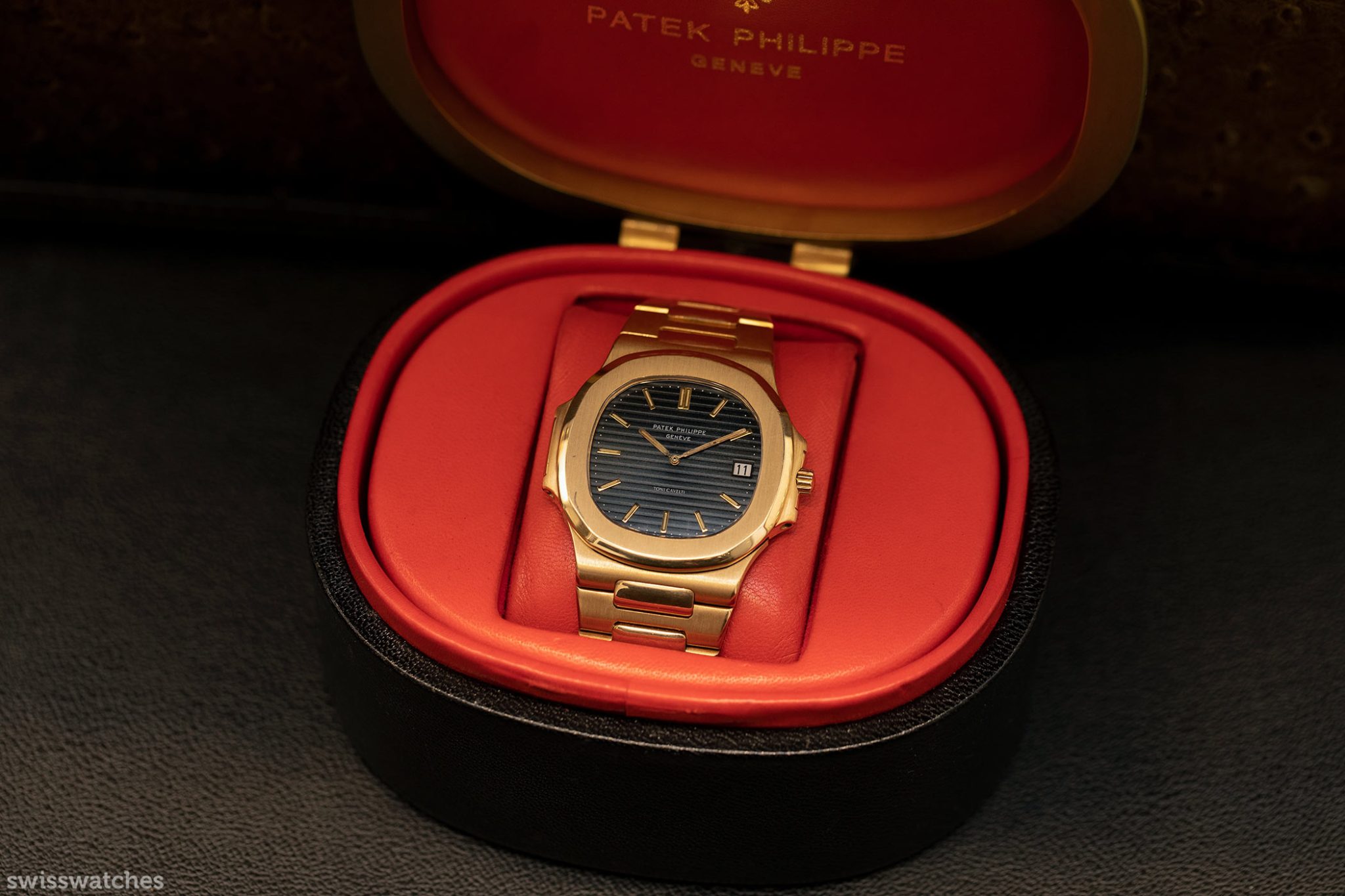
Unique Piece: Nautilus Ref. 3700/1J “TONI CAVELTI”
A bronze-coloured dial in a Reference 3700? Impossible, many will say. But no, not quite. Just like the unintentional “green” Nautilus mentioned earlier, this uniformly faded bronze dial was originally blue. Toni Cavelti, by the way, was an extremely talented goldsmith and jewellery designer from Switzerland who emigrated to Vancouver, Canada, in 1954 and attracted attention for extremely unusual jewellery pieces until the 90s. The fact that he owned one of the very few personally dedicated Nautilus models indicates very close personal relations between him and the Stern family.
The future of the Nautilus
Returning to the expectations of Patek: the following quote from Mr. Stern to the New York Times also hints at the possibility of something extremely unusual in the 2026 anniversary Nautilus, which perfectly summarises the family philosophy. The quote refers to the discontinuation of the steel reference: “We are doing this for our customers who already own a Patek Philippe, and to protect our brand from becoming too commercial. I can continue to make this fantastic product or sell ten times more of it. But I don’t work for numbers. I’m protecting the company for the future, for my children.” Adding, “The second thing is that I have to protect my customer. To do that, a Patek Philippe watch has to keep its value.”
By the way, Mr. Stern did not mean that he will never make steel watches again. Nor can it be ruled out that Patek will present a few limited steel models every now and then on special occasions. Because that’s what stainless steel models have always been in Geneva: a beautiful exception, never the rule.

